Paul van Yperen's Blog, page 78
August 10, 2023
Antonella Lualdi (1931-2023)
Yesterday, 10 August 2023, Italo-Greek Antonella Lualdi (1931) passed away. She was the fascinating leading lady of many Italian and French films of the 1950s and 1960s. Since 1949 her luminescent beauty has graced over 90 films. Antonella Lualdi was 92.
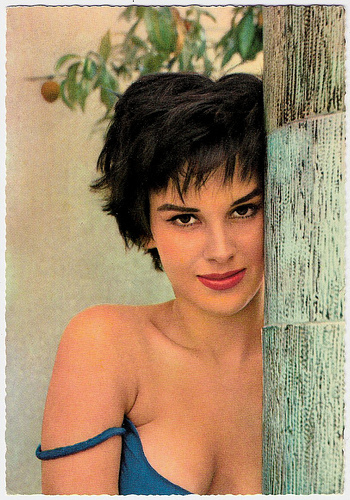
German postcard by Krüger/Ufa, no. 902/151. Photo: Fried Agency.
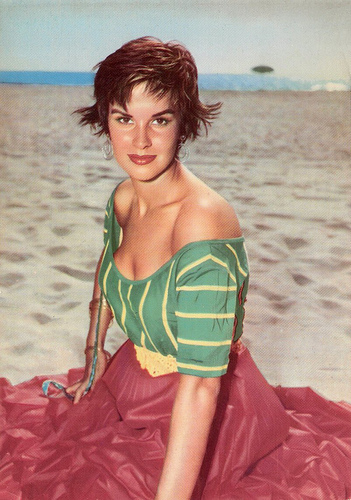
French postcard by Editions P.I., Paris (French licency holder for Ufa, Berlin-Tempelhof), no. CK-159. Photo: Herbert Fried / Ufa.
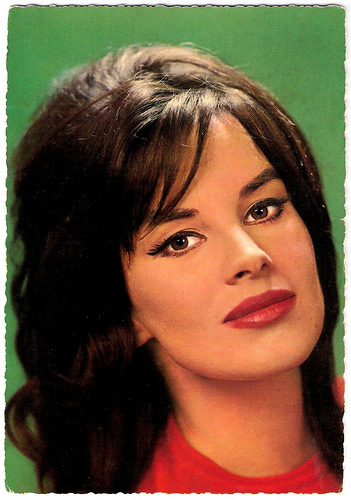
German postcard by Krüger, no. 902/111. Photo: Farabola.
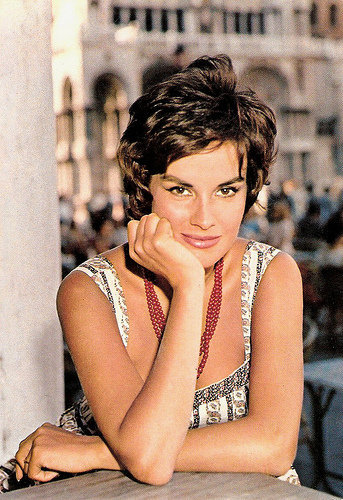
Italian postcard by Rotalfoto, Milano (Milan), no. 62.
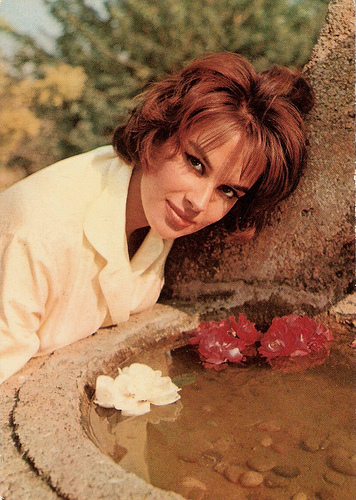
French postcard by Editions P.I., Paris, no. 1032. Photo: Beauvarlet / D. Roger.
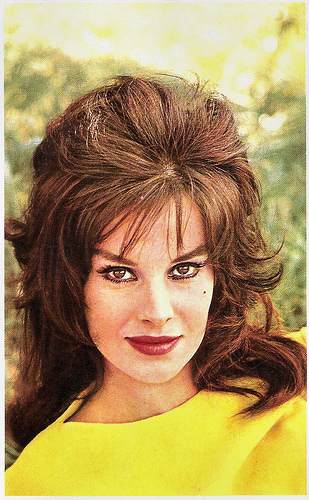
French postcard by Editions P.I., Paris, offered by Corvisart, no. 1072. Photo: Noa.
Franco Interlenghi
Antonella Lualdi was born as Antonietta De Pascale in Beirut, Lebanon in 1931. She was the daughter of an Italian civil engineer and his Greek wife. She learned to speak Italian, French, Greek and a bit of Arabic. With her mother, her sister and her two brothers, Antonella went to live in Rome. At 17, she made her film debut in the musical Signorinella (Mario Mattoli, 1949).
That same year, she appeared in Canzoni per le strade/Songs for the Road (Mario Landi, 1949). Immediately she was seen as a star of the same stature as Lucia Bosé and Gina Lollobrigida .
In the early 1950,s she appeared successfully in films like Ha fatto 13 (Carlo Manzoni, 1951), E Più Facile Che Un Camello/It is Easier for a Camel (Luigi Zampa, 1951) with Jean Gabin , La cieca di Sorrento/The Blind Woman from Sorrento (Giacomo Gentilomo, 1952), the comedy È arrivato l'accordatore/The Piano Tuner Has Arrived (Duilio Coletti, 1952), and Il cappotto/The Overcoat (Alberto Lattuada, 1952) - an adaptation of the classic Nicolas Gogol fable.
During the shooting of I Vitelloni (Federico Fellini, 1953), she met her future husband, Franco Interlenghi . Together they starred in several productions like Non c'è amore più grande (Giorgio Bianchi, 1955), Gli innamorati/Wild Love (Mauro Bolognini, 1955), which was feted at the 1956 Cannes Film Festival, and Padri e figli/Fathers and Sons (Mario Monicelli, 1957).
Without her husband, she appeared opposite Marcello Mastroianni in the controversial Cronache di poveri amanti/Chronicle of Poor Lovers (Carlo Lizzani, 1954), La notte brava/The Big Night (Mauro Bolognini, 1959), I delfini/The Dauphins (Francesco Maselli, 1960) starring Claudia Cardinale , and Il disordine/Disorder (Franco Brusati, 1962) with Alida Valli .
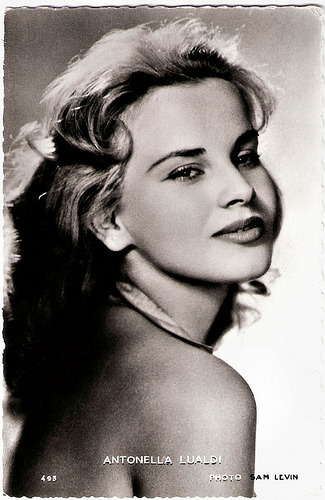
French postcard by Editions P.I., Paris, no. 493. Photo: Sam Lévin.
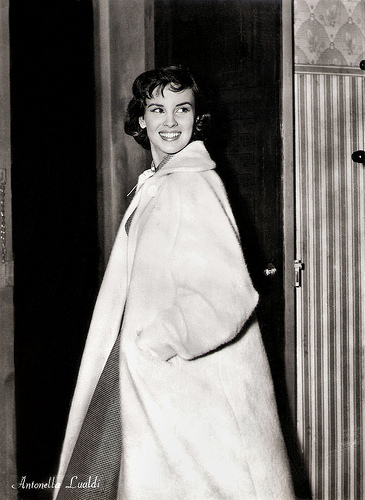
Big Italian postcard by Bromofoto, Milano.
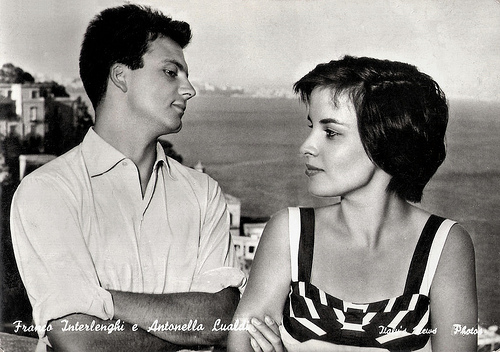
Italian postcard by Bromofoto, Milano, no. 1234. Photo: Italy's News Photos. With Franco Interlenghi .
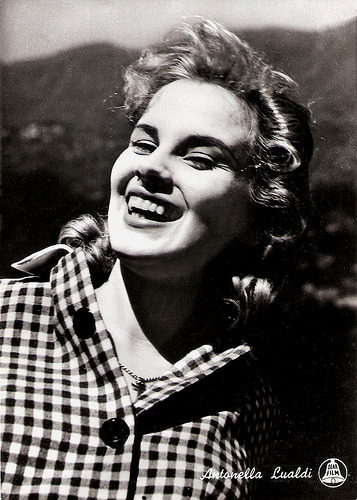
Italian postcard by Bromofoto, no. 550. Photo: Dear Film.
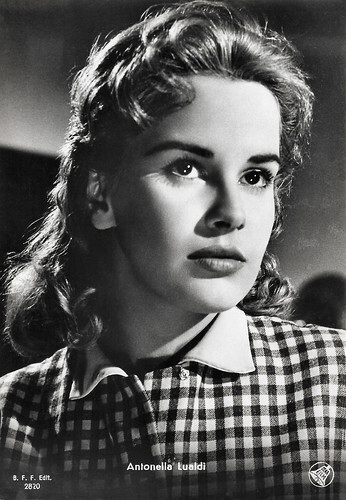
Italian postcard by Casa Editr. Ballerini & Fratini, Firenze. Photo: DEAR Film. Antonella Lualdi in Perdonami!/Forgive me! (Mario Costa, 1953).
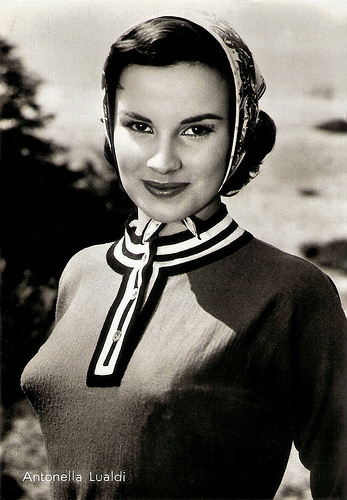
Italian postcard by Bromostampa, no. 6.
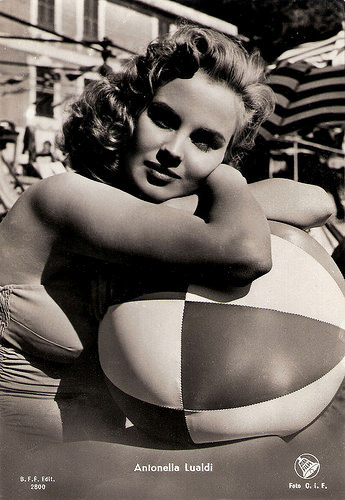
Italian postcard by B.F.F. Edit., no. 2800. Photo: Dear Film / C.I.F.
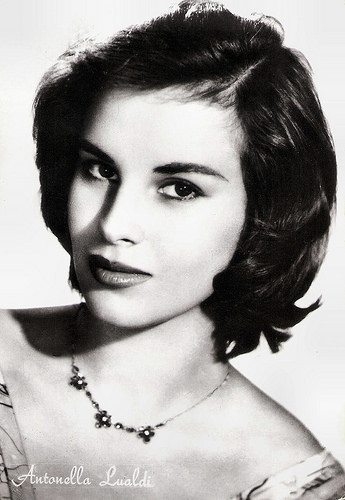
Yugoslavian postcard by NPO, no. G21.
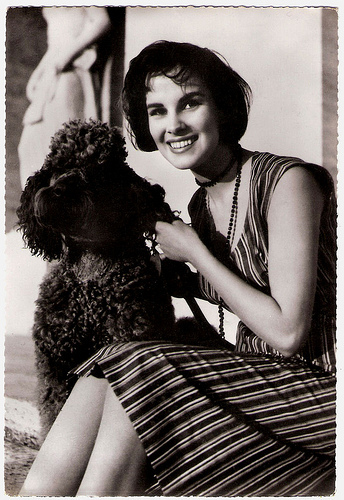
Yugoslavian postcard by 3K, no. 3840.
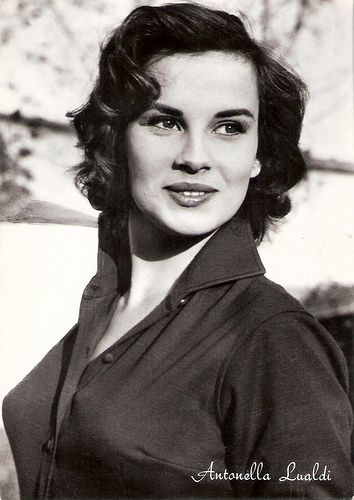
Italian postcard by Rotalfoto, no. 539.
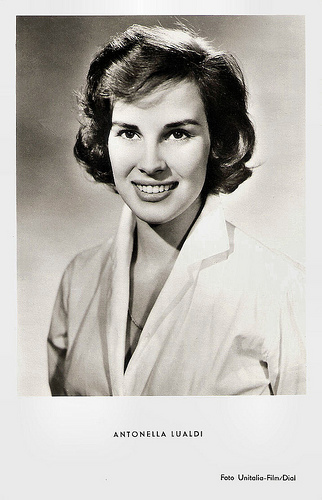
West-German postcard by Kunst und Bild, Berlin, no. A 1155. Photo: Unitalia-Film / Dial.
Arthouse and Sword and Sandal epics
Antonella Lualdi appeared also in many French films, including Adorable créatures (Christian-Jaque, 1952) with Daniel Gélin , the successful Stendhal adaptation Le Rouge et le Noir/The Red and the Black (Claude Autant-Lara, 1954) starring Gérard Philipe , the Film-Noir Mefiez-Vous Fillettes/Look Out Girls (Yves Allégret, 1957), Une Vie/A Life (Alexandre Astruc, 1958) based on a novel by Guy De Maupassant, and Á Double Tour/Web of Passion (1959), a tale of murder and a dysfunctional family by Nouvelle Vague director Claude Chabrol.
In the 1960s she was seen in arthouse productions like Se permettete parliamo di donne/Let's Talk About Women (Ettore Scola, 1964) with Vittorio Gassman , Comizi d'amore (Pier Paolo Pasolini, 1965), and Made in Italy (Nanni Loy, 1965).
But she also starred in Sword and Sandal epics like Arrivano i Titani/The Titans (Duccio Tessari, 1961), I cento cavalieri/Hundred Horsemen (Vittorio Cottafavi, 1964), and Columna/The Column (Mircea Dragan, 1968) with Richard Johnson and the legendary Amedeo Nazzari .
From the 1970s on, her films were less interesting with the exception of Vincent, François, Paul et les Autres/Vincent, Francois, Paul and the Others (Claude Sautet, 1974). For a while, she worked as an assistant director.
In 1992 she made a comeback on TV as Lucia Cordier, the wife of the protagonist (Pierre Mondy) of the crime series Les Cordier, juge et flic, which was broadcasted for 13 seasons till 2005. Her role was continued in the series Commissaire Cordier (2005-2008). Antonella Lualdi and Franco Interlenghi separated in 1972 but later came back together. Interlenghi passed away in 2015. They had two daughters, Stella Interlenghi and actress Antonella Interlenghi.
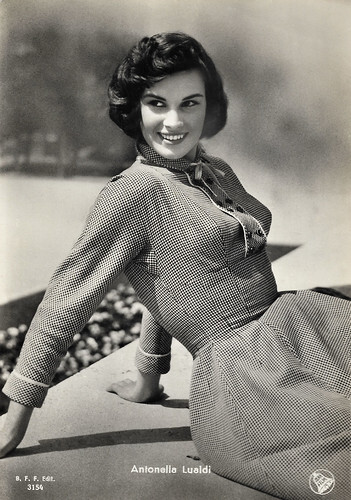
Italian postcard by Casa Editr. Ballerini & Fratini, Firenze, no. 3154. Photo: Dear Film.
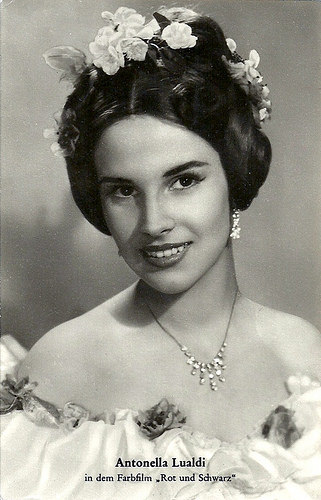
East-German postcard by VEB Progress Filmvertrieb, Berlin. Photo: Antonella Lualdi in Le rouge et le noir (Claude Autant-Lara, 1954).
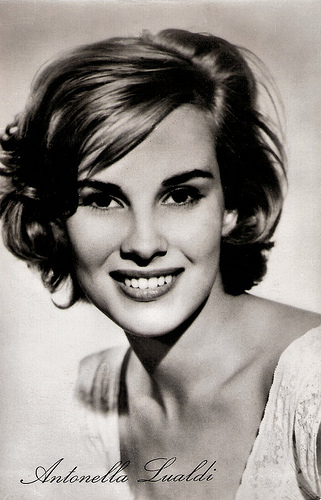
East-German postcard by VEB Progress Film-Vertrieb, no. 836, 1959.
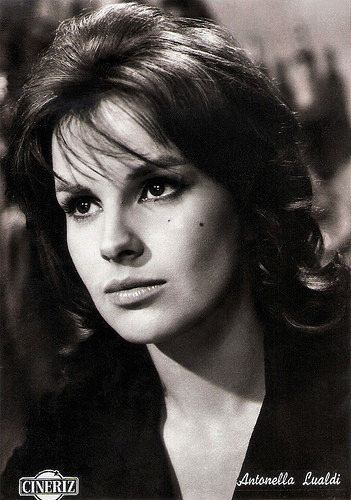
Italian postcard by Bromofoto, Milano, no. 1736. Photo: Cineriz. Publicity still for Via Margutta/Run with the Devil (Mario Camerini, 1960).
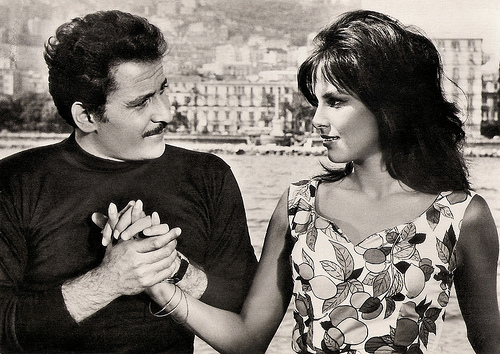
East-German postcard by VEB Progress Filmvertrieb, Berlin. Photo: Antonella Lualdi and Domenico Modugno in Appuntamento a Ischia (Mario Mattoli, 1960).
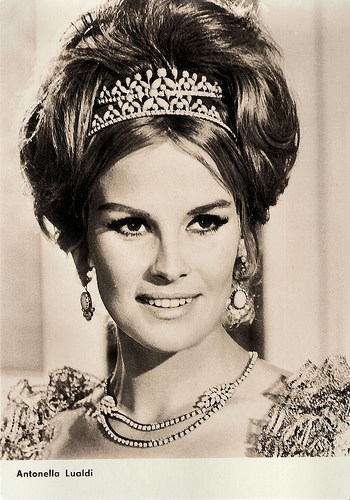
East-German postcard by VEB Progress Film-Vertrieb, Berlin, no. 2815, 1967. Photo: publicity still for Surcouf, l'eroe dei sette mari/The Sea Pirate (Sergio Bergonzelli, Roy Rowland, 1966).
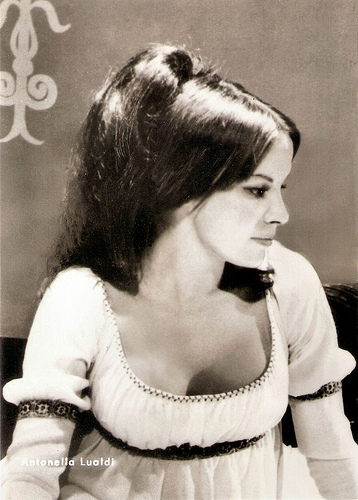
East-German postcard by VEB Progress Film-Vertrieb, Berlin, no. 248/70. Photo: publicity still for Columna/Trajan's Column (Mircea Dragan, 1968).
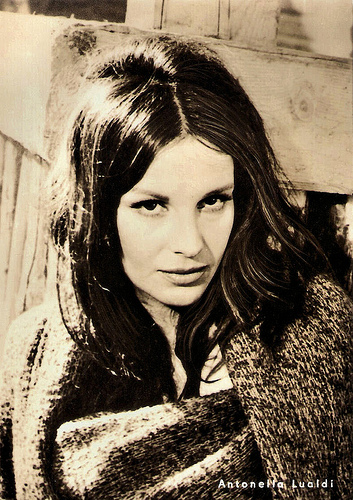
East-German postcard by VEB Progress Film-Vertrieb, no. 20/71. Photo: publicity still for Columna/The Column (Mircea Dragan, 1968).
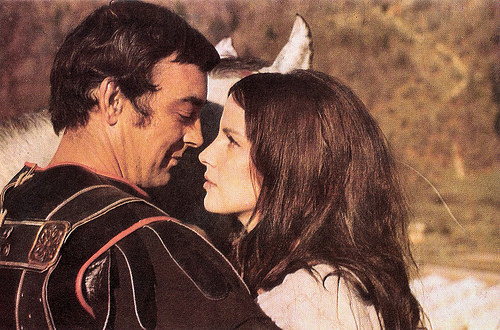
Romanian postcard by Casa Filmului Acin, no. 92. Photo: publicity still for Columna/Trajan's Column (Mircea Dragan, 1968) with Richard Johnson .

French postcard in the series 'Les Cordier, juge et flic - Le collection officielle' by U.M.K. Collections, 2004. Photo: Corbis. Publicity still for Les Cordier, juge et flic/The Cordiers, Judge and Cop (1992-2005) with Antonella Lualdi as Lucia Cordier.
Sources: Sandra Brennan (AllMovie), Notre Cinema (French), Wikipedia, and .

German postcard by Krüger/Ufa, no. 902/151. Photo: Fried Agency.

French postcard by Editions P.I., Paris (French licency holder for Ufa, Berlin-Tempelhof), no. CK-159. Photo: Herbert Fried / Ufa.

German postcard by Krüger, no. 902/111. Photo: Farabola.

Italian postcard by Rotalfoto, Milano (Milan), no. 62.

French postcard by Editions P.I., Paris, no. 1032. Photo: Beauvarlet / D. Roger.

French postcard by Editions P.I., Paris, offered by Corvisart, no. 1072. Photo: Noa.
Franco Interlenghi
Antonella Lualdi was born as Antonietta De Pascale in Beirut, Lebanon in 1931. She was the daughter of an Italian civil engineer and his Greek wife. She learned to speak Italian, French, Greek and a bit of Arabic. With her mother, her sister and her two brothers, Antonella went to live in Rome. At 17, she made her film debut in the musical Signorinella (Mario Mattoli, 1949).
That same year, she appeared in Canzoni per le strade/Songs for the Road (Mario Landi, 1949). Immediately she was seen as a star of the same stature as Lucia Bosé and Gina Lollobrigida .
In the early 1950,s she appeared successfully in films like Ha fatto 13 (Carlo Manzoni, 1951), E Più Facile Che Un Camello/It is Easier for a Camel (Luigi Zampa, 1951) with Jean Gabin , La cieca di Sorrento/The Blind Woman from Sorrento (Giacomo Gentilomo, 1952), the comedy È arrivato l'accordatore/The Piano Tuner Has Arrived (Duilio Coletti, 1952), and Il cappotto/The Overcoat (Alberto Lattuada, 1952) - an adaptation of the classic Nicolas Gogol fable.
During the shooting of I Vitelloni (Federico Fellini, 1953), she met her future husband, Franco Interlenghi . Together they starred in several productions like Non c'è amore più grande (Giorgio Bianchi, 1955), Gli innamorati/Wild Love (Mauro Bolognini, 1955), which was feted at the 1956 Cannes Film Festival, and Padri e figli/Fathers and Sons (Mario Monicelli, 1957).
Without her husband, she appeared opposite Marcello Mastroianni in the controversial Cronache di poveri amanti/Chronicle of Poor Lovers (Carlo Lizzani, 1954), La notte brava/The Big Night (Mauro Bolognini, 1959), I delfini/The Dauphins (Francesco Maselli, 1960) starring Claudia Cardinale , and Il disordine/Disorder (Franco Brusati, 1962) with Alida Valli .

French postcard by Editions P.I., Paris, no. 493. Photo: Sam Lévin.

Big Italian postcard by Bromofoto, Milano.

Italian postcard by Bromofoto, Milano, no. 1234. Photo: Italy's News Photos. With Franco Interlenghi .

Italian postcard by Bromofoto, no. 550. Photo: Dear Film.

Italian postcard by Casa Editr. Ballerini & Fratini, Firenze. Photo: DEAR Film. Antonella Lualdi in Perdonami!/Forgive me! (Mario Costa, 1953).

Italian postcard by Bromostampa, no. 6.

Italian postcard by B.F.F. Edit., no. 2800. Photo: Dear Film / C.I.F.

Yugoslavian postcard by NPO, no. G21.

Yugoslavian postcard by 3K, no. 3840.

Italian postcard by Rotalfoto, no. 539.

West-German postcard by Kunst und Bild, Berlin, no. A 1155. Photo: Unitalia-Film / Dial.
Arthouse and Sword and Sandal epics
Antonella Lualdi appeared also in many French films, including Adorable créatures (Christian-Jaque, 1952) with Daniel Gélin , the successful Stendhal adaptation Le Rouge et le Noir/The Red and the Black (Claude Autant-Lara, 1954) starring Gérard Philipe , the Film-Noir Mefiez-Vous Fillettes/Look Out Girls (Yves Allégret, 1957), Une Vie/A Life (Alexandre Astruc, 1958) based on a novel by Guy De Maupassant, and Á Double Tour/Web of Passion (1959), a tale of murder and a dysfunctional family by Nouvelle Vague director Claude Chabrol.
In the 1960s she was seen in arthouse productions like Se permettete parliamo di donne/Let's Talk About Women (Ettore Scola, 1964) with Vittorio Gassman , Comizi d'amore (Pier Paolo Pasolini, 1965), and Made in Italy (Nanni Loy, 1965).
But she also starred in Sword and Sandal epics like Arrivano i Titani/The Titans (Duccio Tessari, 1961), I cento cavalieri/Hundred Horsemen (Vittorio Cottafavi, 1964), and Columna/The Column (Mircea Dragan, 1968) with Richard Johnson and the legendary Amedeo Nazzari .
From the 1970s on, her films were less interesting with the exception of Vincent, François, Paul et les Autres/Vincent, Francois, Paul and the Others (Claude Sautet, 1974). For a while, she worked as an assistant director.
In 1992 she made a comeback on TV as Lucia Cordier, the wife of the protagonist (Pierre Mondy) of the crime series Les Cordier, juge et flic, which was broadcasted for 13 seasons till 2005. Her role was continued in the series Commissaire Cordier (2005-2008). Antonella Lualdi and Franco Interlenghi separated in 1972 but later came back together. Interlenghi passed away in 2015. They had two daughters, Stella Interlenghi and actress Antonella Interlenghi.

Italian postcard by Casa Editr. Ballerini & Fratini, Firenze, no. 3154. Photo: Dear Film.

East-German postcard by VEB Progress Filmvertrieb, Berlin. Photo: Antonella Lualdi in Le rouge et le noir (Claude Autant-Lara, 1954).

East-German postcard by VEB Progress Film-Vertrieb, no. 836, 1959.

Italian postcard by Bromofoto, Milano, no. 1736. Photo: Cineriz. Publicity still for Via Margutta/Run with the Devil (Mario Camerini, 1960).

East-German postcard by VEB Progress Filmvertrieb, Berlin. Photo: Antonella Lualdi and Domenico Modugno in Appuntamento a Ischia (Mario Mattoli, 1960).

East-German postcard by VEB Progress Film-Vertrieb, Berlin, no. 2815, 1967. Photo: publicity still for Surcouf, l'eroe dei sette mari/The Sea Pirate (Sergio Bergonzelli, Roy Rowland, 1966).

East-German postcard by VEB Progress Film-Vertrieb, Berlin, no. 248/70. Photo: publicity still for Columna/Trajan's Column (Mircea Dragan, 1968).

East-German postcard by VEB Progress Film-Vertrieb, no. 20/71. Photo: publicity still for Columna/The Column (Mircea Dragan, 1968).

Romanian postcard by Casa Filmului Acin, no. 92. Photo: publicity still for Columna/Trajan's Column (Mircea Dragan, 1968) with Richard Johnson .

French postcard in the series 'Les Cordier, juge et flic - Le collection officielle' by U.M.K. Collections, 2004. Photo: Corbis. Publicity still for Les Cordier, juge et flic/The Cordiers, Judge and Cop (1992-2005) with Antonella Lualdi as Lucia Cordier.
Sources: Sandra Brennan (AllMovie), Notre Cinema (French), Wikipedia, and .
Published on August 10, 2023 22:00
August 9, 2023
Margit Saad (1929-2023)
On 7 August 2023, German actress Margit Saad (1929) passed away in Munich, Germany, at the age of 94. The mysterious, exotic beauty worked largely in German film and television. During the 1960s, she also made occasional English-language appearances.
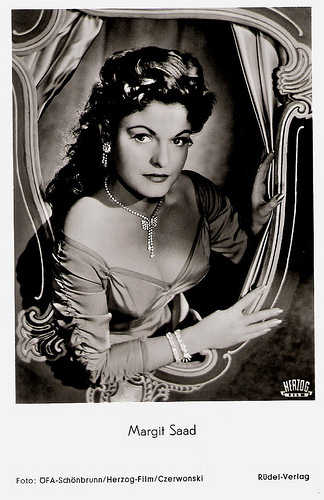
German postcard by Rüdel-Verlag, Hamburg-Bergedorf, no. 844. Photo: ÖFA-Schönbrun / Herzog-Film / Czerwonski. Publicity still for Hab ich nur deine Diebe/I only have your love (Eduard von Borsody, 1953).
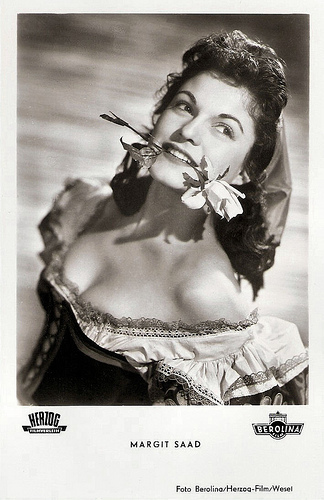
German postcard by Kunst und Bild, Berlin, no. A 1128. Photo: Herzog / Berolina. Publicity still for Der Zigeunerbaron/Baron Tzigane/Gypsy Baron (Arthur Maria Rabenalt, 1954).
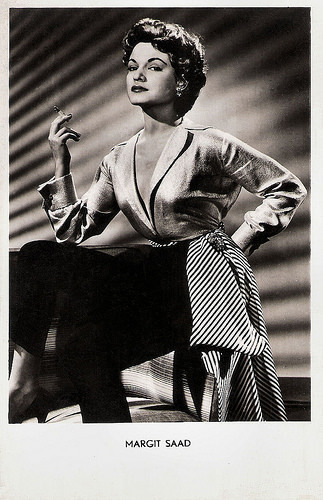
Vintage postcard, no. 103.
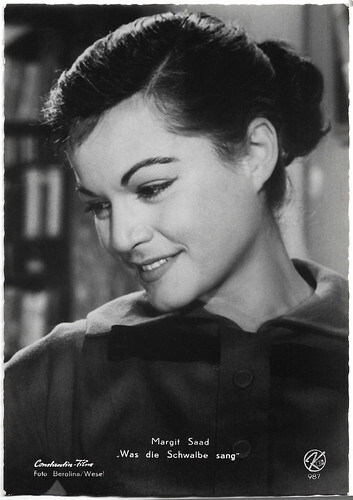
Austrian postcard by Kellner-Fotokarten, Wien, no. 987. Photo: Constantin-Film / Berolina / Wesel. Margit Saad in Was die Schwalbe sang/What the swallow sang (Géza von Bolváry, 1956).
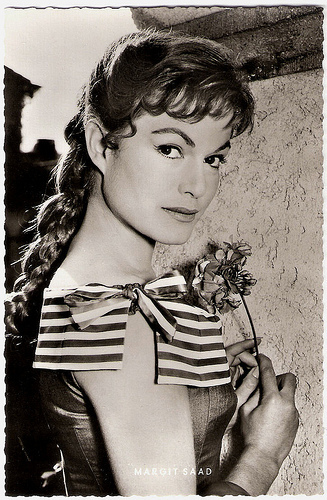
German postcard by Kunst und Bild, Berlin-Charlottenburg, no. T 864. Photo: Bavaria / Schorcht / Vogelmann. Publicity still for Ein Stück vom Himmel/A Piece of Heaven (Rudolf Jugert, 1958).
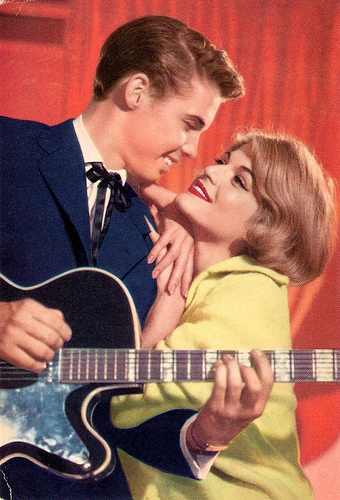
German postcard by ISV, no. H 43. Peter Kraus and Margit Saad in Melodie und Rhythmus/Melody and Rhythms (John Olden, 1959).
Daughter of a Lebanese language professor
Margit Daisy Saad was born in Munich, Bavaria in 1929. She is the daughter of the Lebanese language professor Fuad Jabbour Saad and German language teacher Agnes Saad, born Diepgen. Margit studied acting at the Otto-Falckenberg-Schule in Munich. To finance her studies, she worked as a model. She had her first stage engagement in Düsseldorf.
Saad made her screen debut in the Austrian comedy Eva erbt das Paradies... ein Abenteuer im Salzkammergut/Eva Inherits Paradise (Franz Antel, 1951), starring Maria Andergast. She also appeared as a nun in the West German drama Hinter Klostermauern/The Unholy Intruders (Harald Reinl, 1952) starring Olga Tschechowa , Frits van Dongen (a.k.a. Philip Dorn) and Katharina Mayberg .
She played leading roles in the romantic musical Südliche Nächte/Southern Nights (Robert A. Stemmle, 1953), the operetta Baron Tzigane/Gypsy Baron (Arthur Maria Rabenalt, 1954) with Georges Guétary , and the romantic comedy Drei Mädels vom Rhein/Three girls from the Rhine (Ernst Jacoby, 1955).
In the Swedish-German coproduction Sommarflickan/Swedish Girl (Håkan Bergström, Thomas Engel, 1955), she had a part opposite Maj-Britt Nilsson and Karlheinz Böhm . A popular success was the West German crime-comedy Peter Voss, der Millionendieb/Peter Voss, Thief of Millions (Wolfgang Becker, 1958) featuring O.W. Fischer . It was based on the 1913 novel Peter Voss, Thief of Millions by Ewald Gerhard Seeliger, which had been previously adapted into three films.
In France, she appeared in Les dragueurs/The Dredgers (Jean-Pierre Mocky, 1959). Other films that year were Heiße Ware/Hot Goods (Paul May, 1959) with Ivan Desny , and the teen musical Melodie und Rhythmus/Melody and Rhythms (John Olden, 1959) with teen idol Peter Kraus .
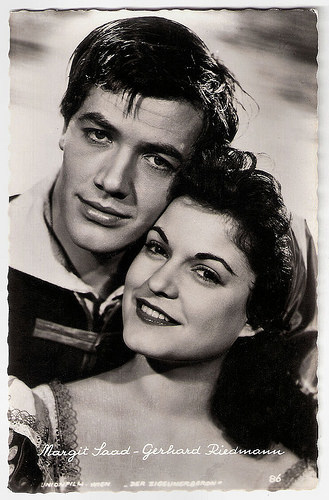
Austrian postcard by Verlag Hubmann, Wien, no.3837. Photo: Unionfilm, Wien. Publicity still for Der Zigeunerbaron/The Gypsy Baron (Arthur Maria Rabenalt, 1954) with Gerhard Riedmann .
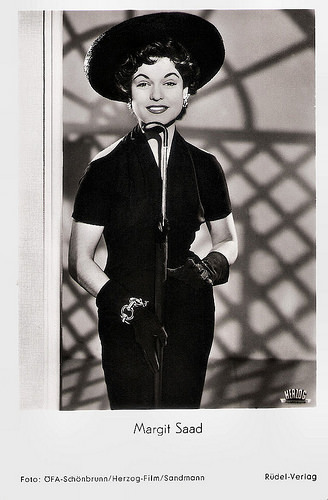
German postcard by Rüdel-Verlag, Hamburg-Bergedorfno. 1265. Photo: ÖFA / Schönbrunn / Herzog-Film / Sandmann. Publicity still for Ehesanatorium/That's Love (Franz Antel, 1955).
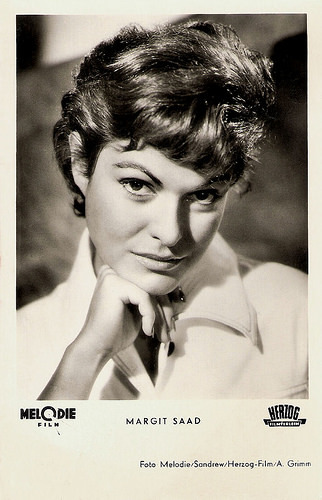
German postcard by Kunst und Bild, Berlin-Charlottenburg, no. I 436. Photo: Melodie / Sandrew / Herzog-Film / Arthur Grimm. Publicity still for Sommarflickan/Swedish Girl (Håkan Bergström, Thomas Engel, 1955).
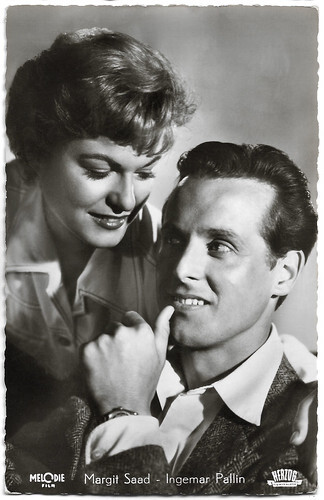
West German postcard by Kolibri-Verlag G.m.b.H., Minden/Westf., no. 1666. Photo: Melodie / Sandrew / Herzog-Film / A. Grimm. Margit Saad and Ingemar Pallin in Sommarflickan/ Schwedenmädel/Swedish Girl (Håkan Bergström, Thomas Engel, 1955).
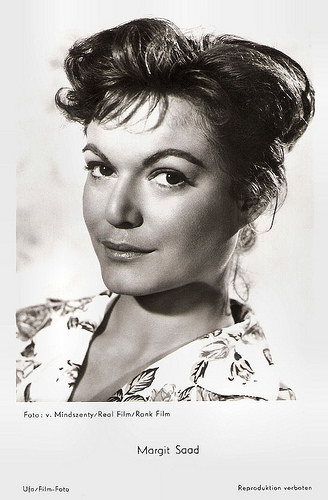
German postcard by Ufa, Berlin-Tempelhof, no. FK 3302. Photo: v. Mindszenty / Real-Film / Rank Film. Publicity still for Drei Birken auf der Heide/Three birches on the heath (Ulrich Erfurth, 1956).
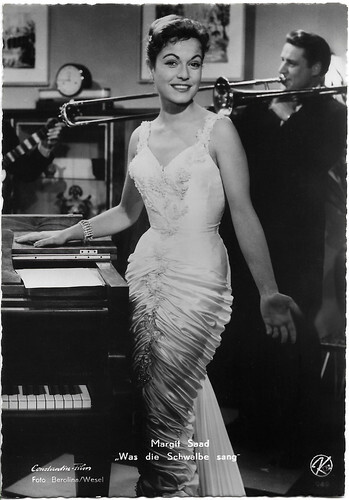
Austrian postcard by Kellner-Fotokarten, Wien, no. 949. Photo: Constantin-Film / Berolina / Wesel. Margit Saad in Was die Schwalbe sang/What the swallow sang (Géza von Bolváry, 1956).
The film's seedy milieu and sadistic streak
In 1960 Margit Saad starred in the British drama The Criminal (Joseph Losey, 1960) with Stanley Baker and Sam Wanamaker. Mario Gauci at IMDb : “While essentially character-driven, the film's seedy milieu and sadistic streak allows for a number of vivid sequences (though the race-track robbery itself is rather thrown away!) including the wild party held at Baker's flat on being released from prison (highlighting sexy Margit Saad who subsequently replaces Jill Bennett as Baker's moll), the equally chaotic prison riot, Baker's escape from the penitentiary (having been betrayed after the robbery and recaptured) and the inevitable showdown with the ruthless Wanamaker.”
She followed it up with appearances in other British films such as The Rebel (Robert Day, 1961) with Tony Hancock and George Sanders , and the low-budget thriller Playback (Quentin Lawrence, 1962). The latter was one of a series of British films based on Edgar Wallace novels, released between 1960 and 1965. On TV she appeared opposite Roger Moore in an episode of The Saint, The Saint Sees It Through (Robert S. Baker, 1964). And in the cinema, she supported TV comedians Eric Morecambe and Ernie Wise in The Magnificent Two (Cliff Owen, 1967).
In Germany, she co-starred with Stewart Granger in the Edgar Wallace crime film Das Geheimnis der drei Dschunken/Code Name Alpha (Ernst Hofbauer, 1965). In 1966, Saad appeared in an episode of the American television espionage series Blue Light, starring Robert Goulet and Christine Carère . It was edited together with three other episodes into the feature film I Deal in Danger (Walter Grauman, 1966), which includes her appearance.
Later she also appeared in Grauman’s war film The Last Escape (Walter Grauman, 1969) starring Stuart Whitman. It was her last film, but she continued to appear incidentally on German TV. Saad also started to direct TV films, including the drama Die Geschichte vom guten alten Herrn und dem schönen Madchen/The Story of the good old gentleman and the beautiful girl (1986) with Peter Pasetti .
From 1957 till his death in 1988, Margit Saad was married to noted French opera director Jean-Pierre Ponnelle. They had one son, conductor Pierre-Dominique Ponnelle.
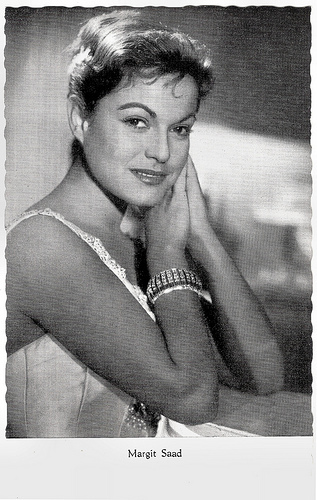
German postcard by Kolibri-Verlag, Minden/Westf., no. D 40. Photo: Berolina / Constantin / Wesel. Publicity still for Was die Schwalbe sang/What the swallow sang (Géza von Bolváry, 1956).
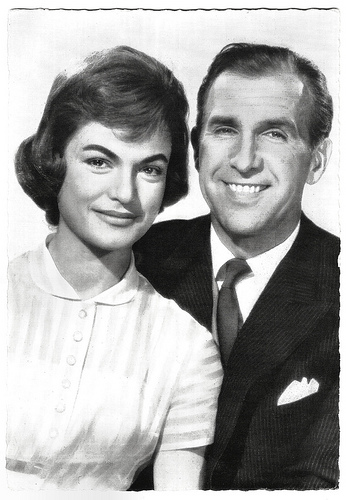
German postcard by WS-Druck, Wanne-Eickel, no. 309. Photo: Unionfilm / Wanka. Publicity still for Ein Amerikaner in Salzburg/An American in Salzburg (Helmut Weiss, 1958) with Bruce Low .
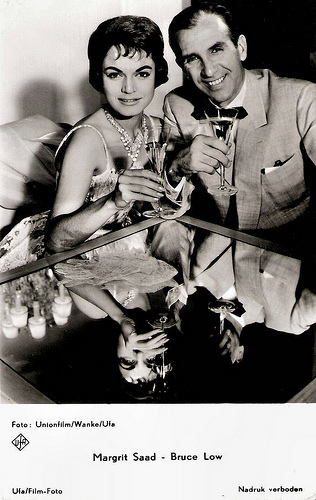
Dutch postcard by Gebr. Spanjersberg N.V., Rotterdam no. 1488. Photo: Unionfilm / Wanke / Ufa. Publicity still for Ein Amerikaner in Salzburg/An American in Salzburg (Helmut Weiss, 1958) with Bruce Low .
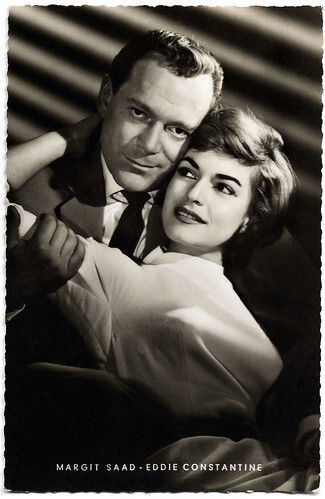
West German postcard by Kunst und Bild, Berlin-Charlottenburg. Photo: Gloria-Film / Wesel. Margit Saad and Eddie Constantine in Hoppla, jetzt kommt Eddie/Hoopla, Now Comes Eddie (Werner Klingler, 1958). Sent by mail in 1960.
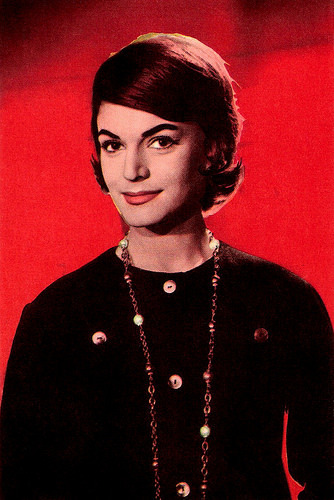
Belgian postcard by Cox, no. 48.
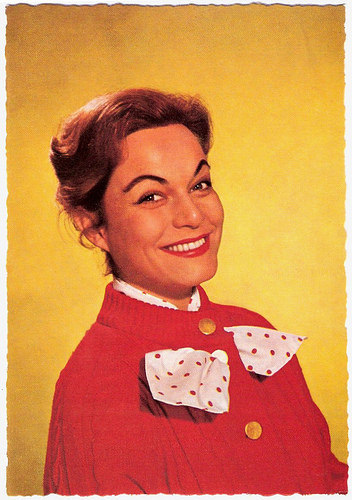
German postcard by WS-Druck, Wanne Eickel, no. F 101. Photo: Klaus Collignon.
Sources: Mario Gauci (IMDb), British Film Institute, Wikipedia (English and German) and .

German postcard by Rüdel-Verlag, Hamburg-Bergedorf, no. 844. Photo: ÖFA-Schönbrun / Herzog-Film / Czerwonski. Publicity still for Hab ich nur deine Diebe/I only have your love (Eduard von Borsody, 1953).

German postcard by Kunst und Bild, Berlin, no. A 1128. Photo: Herzog / Berolina. Publicity still for Der Zigeunerbaron/Baron Tzigane/Gypsy Baron (Arthur Maria Rabenalt, 1954).

Vintage postcard, no. 103.

Austrian postcard by Kellner-Fotokarten, Wien, no. 987. Photo: Constantin-Film / Berolina / Wesel. Margit Saad in Was die Schwalbe sang/What the swallow sang (Géza von Bolváry, 1956).

German postcard by Kunst und Bild, Berlin-Charlottenburg, no. T 864. Photo: Bavaria / Schorcht / Vogelmann. Publicity still for Ein Stück vom Himmel/A Piece of Heaven (Rudolf Jugert, 1958).

German postcard by ISV, no. H 43. Peter Kraus and Margit Saad in Melodie und Rhythmus/Melody and Rhythms (John Olden, 1959).
Daughter of a Lebanese language professor
Margit Daisy Saad was born in Munich, Bavaria in 1929. She is the daughter of the Lebanese language professor Fuad Jabbour Saad and German language teacher Agnes Saad, born Diepgen. Margit studied acting at the Otto-Falckenberg-Schule in Munich. To finance her studies, she worked as a model. She had her first stage engagement in Düsseldorf.
Saad made her screen debut in the Austrian comedy Eva erbt das Paradies... ein Abenteuer im Salzkammergut/Eva Inherits Paradise (Franz Antel, 1951), starring Maria Andergast. She also appeared as a nun in the West German drama Hinter Klostermauern/The Unholy Intruders (Harald Reinl, 1952) starring Olga Tschechowa , Frits van Dongen (a.k.a. Philip Dorn) and Katharina Mayberg .
She played leading roles in the romantic musical Südliche Nächte/Southern Nights (Robert A. Stemmle, 1953), the operetta Baron Tzigane/Gypsy Baron (Arthur Maria Rabenalt, 1954) with Georges Guétary , and the romantic comedy Drei Mädels vom Rhein/Three girls from the Rhine (Ernst Jacoby, 1955).
In the Swedish-German coproduction Sommarflickan/Swedish Girl (Håkan Bergström, Thomas Engel, 1955), she had a part opposite Maj-Britt Nilsson and Karlheinz Böhm . A popular success was the West German crime-comedy Peter Voss, der Millionendieb/Peter Voss, Thief of Millions (Wolfgang Becker, 1958) featuring O.W. Fischer . It was based on the 1913 novel Peter Voss, Thief of Millions by Ewald Gerhard Seeliger, which had been previously adapted into three films.
In France, she appeared in Les dragueurs/The Dredgers (Jean-Pierre Mocky, 1959). Other films that year were Heiße Ware/Hot Goods (Paul May, 1959) with Ivan Desny , and the teen musical Melodie und Rhythmus/Melody and Rhythms (John Olden, 1959) with teen idol Peter Kraus .

Austrian postcard by Verlag Hubmann, Wien, no.3837. Photo: Unionfilm, Wien. Publicity still for Der Zigeunerbaron/The Gypsy Baron (Arthur Maria Rabenalt, 1954) with Gerhard Riedmann .

German postcard by Rüdel-Verlag, Hamburg-Bergedorfno. 1265. Photo: ÖFA / Schönbrunn / Herzog-Film / Sandmann. Publicity still for Ehesanatorium/That's Love (Franz Antel, 1955).

German postcard by Kunst und Bild, Berlin-Charlottenburg, no. I 436. Photo: Melodie / Sandrew / Herzog-Film / Arthur Grimm. Publicity still for Sommarflickan/Swedish Girl (Håkan Bergström, Thomas Engel, 1955).

West German postcard by Kolibri-Verlag G.m.b.H., Minden/Westf., no. 1666. Photo: Melodie / Sandrew / Herzog-Film / A. Grimm. Margit Saad and Ingemar Pallin in Sommarflickan/ Schwedenmädel/Swedish Girl (Håkan Bergström, Thomas Engel, 1955).

German postcard by Ufa, Berlin-Tempelhof, no. FK 3302. Photo: v. Mindszenty / Real-Film / Rank Film. Publicity still for Drei Birken auf der Heide/Three birches on the heath (Ulrich Erfurth, 1956).

Austrian postcard by Kellner-Fotokarten, Wien, no. 949. Photo: Constantin-Film / Berolina / Wesel. Margit Saad in Was die Schwalbe sang/What the swallow sang (Géza von Bolváry, 1956).
The film's seedy milieu and sadistic streak
In 1960 Margit Saad starred in the British drama The Criminal (Joseph Losey, 1960) with Stanley Baker and Sam Wanamaker. Mario Gauci at IMDb : “While essentially character-driven, the film's seedy milieu and sadistic streak allows for a number of vivid sequences (though the race-track robbery itself is rather thrown away!) including the wild party held at Baker's flat on being released from prison (highlighting sexy Margit Saad who subsequently replaces Jill Bennett as Baker's moll), the equally chaotic prison riot, Baker's escape from the penitentiary (having been betrayed after the robbery and recaptured) and the inevitable showdown with the ruthless Wanamaker.”
She followed it up with appearances in other British films such as The Rebel (Robert Day, 1961) with Tony Hancock and George Sanders , and the low-budget thriller Playback (Quentin Lawrence, 1962). The latter was one of a series of British films based on Edgar Wallace novels, released between 1960 and 1965. On TV she appeared opposite Roger Moore in an episode of The Saint, The Saint Sees It Through (Robert S. Baker, 1964). And in the cinema, she supported TV comedians Eric Morecambe and Ernie Wise in The Magnificent Two (Cliff Owen, 1967).
In Germany, she co-starred with Stewart Granger in the Edgar Wallace crime film Das Geheimnis der drei Dschunken/Code Name Alpha (Ernst Hofbauer, 1965). In 1966, Saad appeared in an episode of the American television espionage series Blue Light, starring Robert Goulet and Christine Carère . It was edited together with three other episodes into the feature film I Deal in Danger (Walter Grauman, 1966), which includes her appearance.
Later she also appeared in Grauman’s war film The Last Escape (Walter Grauman, 1969) starring Stuart Whitman. It was her last film, but she continued to appear incidentally on German TV. Saad also started to direct TV films, including the drama Die Geschichte vom guten alten Herrn und dem schönen Madchen/The Story of the good old gentleman and the beautiful girl (1986) with Peter Pasetti .
From 1957 till his death in 1988, Margit Saad was married to noted French opera director Jean-Pierre Ponnelle. They had one son, conductor Pierre-Dominique Ponnelle.

German postcard by Kolibri-Verlag, Minden/Westf., no. D 40. Photo: Berolina / Constantin / Wesel. Publicity still for Was die Schwalbe sang/What the swallow sang (Géza von Bolváry, 1956).

German postcard by WS-Druck, Wanne-Eickel, no. 309. Photo: Unionfilm / Wanka. Publicity still for Ein Amerikaner in Salzburg/An American in Salzburg (Helmut Weiss, 1958) with Bruce Low .

Dutch postcard by Gebr. Spanjersberg N.V., Rotterdam no. 1488. Photo: Unionfilm / Wanke / Ufa. Publicity still for Ein Amerikaner in Salzburg/An American in Salzburg (Helmut Weiss, 1958) with Bruce Low .

West German postcard by Kunst und Bild, Berlin-Charlottenburg. Photo: Gloria-Film / Wesel. Margit Saad and Eddie Constantine in Hoppla, jetzt kommt Eddie/Hoopla, Now Comes Eddie (Werner Klingler, 1958). Sent by mail in 1960.

Belgian postcard by Cox, no. 48.

German postcard by WS-Druck, Wanne Eickel, no. F 101. Photo: Klaus Collignon.
Sources: Mario Gauci (IMDb), British Film Institute, Wikipedia (English and German) and .
Published on August 09, 2023 22:00
August 8, 2023
Quo vadis? (1924)
One of the most spectacular films of European silent cinema was Quo vadis? (Gabriellino D'Annunzio, Georg Jacoby, 1924), based on the classic novel by Henryk Sienkiewicz. The production company, the Unione Cinematografica Italiana (UCI) was a Ufa-like or Universal-like merger of many Italian pre-war film companies. The producer was grand old man Arturo Ambrosio and the directors were the German Georg Jacoby and the Italian Gabriellino D' Annunzio, son of Gabriele D'Annunzio, the famous Italian writer and adventurer. The sets for this German-Italian coproduction were designed by R. Ferro and G. Spilani. A lot of beautiful publicity material was produced for the film, including several series of postcards as we showed in an earlier post on Quo Vadis from 2016. This new post contains a postcard series published by the Turinese Ed. L'Argentografica.

Italian postcard by Ed. L'Argentografica, Turin, no. 3040. Photo: Unione Cinematografia Italiana (UCI). Scene from Quo vadis? (Gabriellino D'Annunzio, Georg Jacoby, 1924) starring Emil Jannings as Nero and Elena Sangro as Poppea.
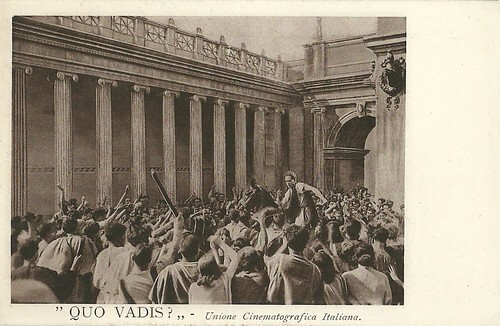
Italian postcard by Ed. L'Argentografica, Turin, no. 3041. Photo: Unione Cinematografia Italiana (UCI). Scene from Quo vadis? (Gabriellino D'Annunzio, Georg Jacoby, 1924) starring Alphons Fryland as Vinicius.
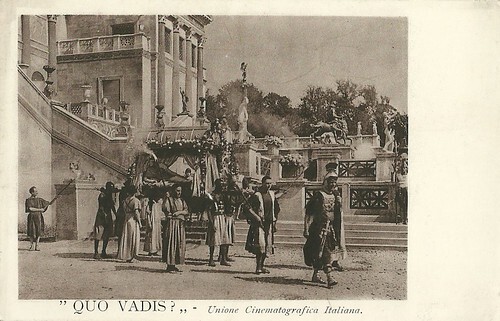
Italian postcard by Ed. L'Argentografica, Turin, no. 3042. Photo: Unione Cinematografia Italiana (UCI). Scene from Quo vadis? (Gabriellino D'Annunzio, Georg Jacoby, 1924).
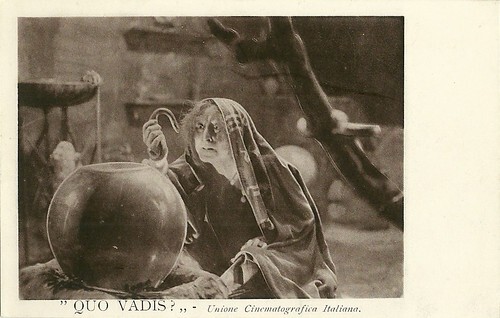
Italian postcard by Ed. L'Argentografica, Turin, no. 3043. Photo: Unione Cinematografia Italiana (UCI). Scene from Quo vadis? (Gabriellino D'Annunzio, Georg Jacoby, 1924).
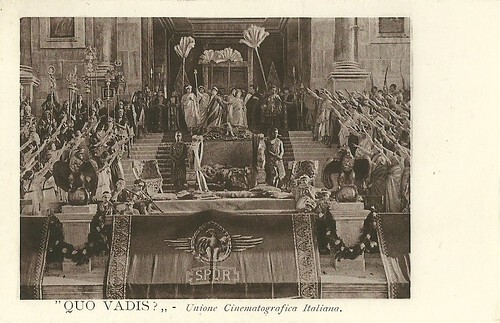
Italian postcard by Ed. L'Argentografica, Turin, no. 3044. Photo: Unione Cinematografia Italiana (UCI). Scene from Quo vadis? (Gabriellino D'Annunzio, Georg Jacoby, 1924).
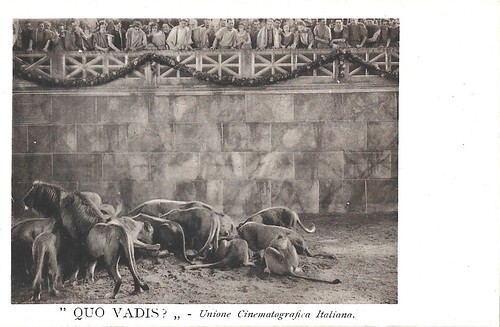
Italian postcard by Ed. L'Argentografica, Turin, no. 3046. Photo: Unione Cinematografia Italiana (UCI). Scene from Quo vadis? (Gabriellino D'Annunzio, Georg Jacoby, 1924). The lions in the arena.
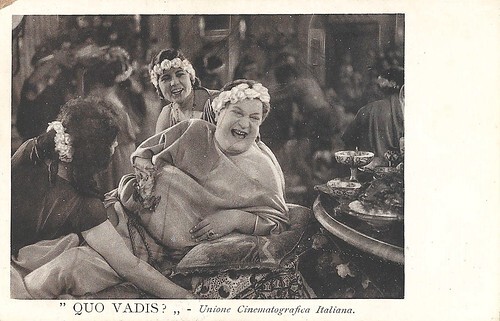
Italian postcard by Ed. L'Argentografica, Turin, no. 3047. Photo: Unione Cinematografia Italiana (UCI). Scene from Quo vadis? (Gabriellino D'Annunzio, Georg Jacoby, 1924). Gildo Bocci as Vitellius at Nero's orgy.
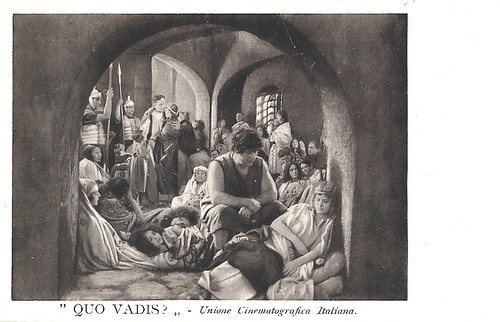
Italian postcard by Ed. L'Argentografica, Turin, no. 3048. Photo: Unione Cinematografia Italiana (UCI). Scene from Quo vadis? (Gabriellino D'Annunzio, Georg Jacoby, 1924). Ursus and Licia/Lygia in prison.
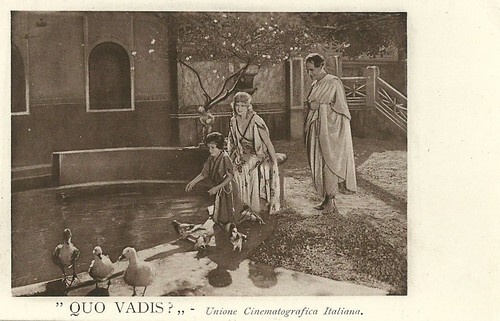
Italian postcard by Ed. L'Argentografica, Turin, no. 3049. Photo: Unione Cinematografia Italiana (UCI). Scene from Quo vadis? (Gabriellino D'Annunzio, Georg Jacoby, 1924) starring Alphons Fryland as Vinicius and Lilian Hall-Davis as Licia.
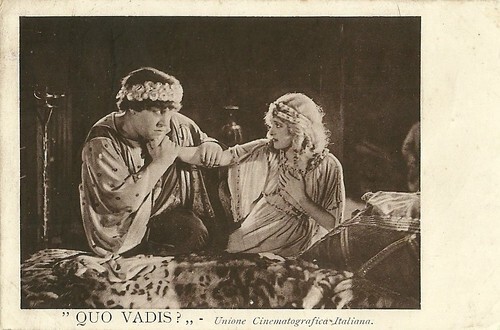
Italian postcard by Ed. L'Argentografica, Turin, no. 3050. Photo: Unione Cinematografia Italiana (UCI). Scene from Quo vadis? (Gabriellino D'Annunzio, Georg Jacoby, 1924), starring Emil Jannings as Nero and Lilian Hall-Davis as Licia. Nero menaces Licia, after having 'saved her from the clutches of Vinicius'.
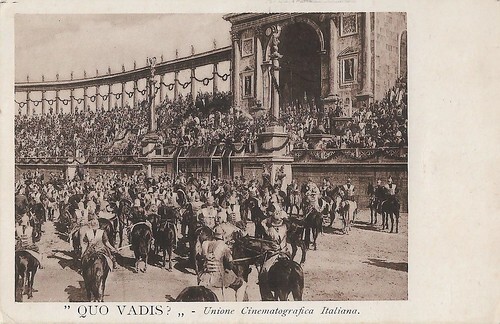
Italian postcard by Ed. L'Argentografica, Turin, no. 3051. Photo: Unione Cinematografia Italiana (UCI). Scene from Quo vadis? (Gabriellino D'Annunzio, Georg Jacoby, 1924). Roman cavalry in the arena.
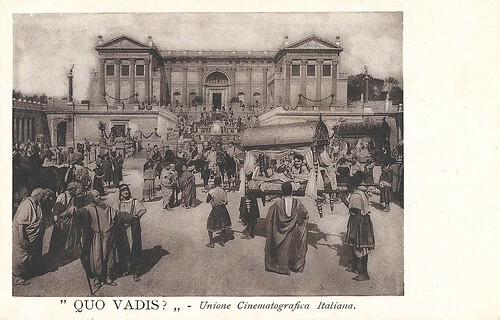
Italian postcard by Ed. L'Argentografica, Turin, no. 3052. Photo: Unione Cinematografia Italiana (UCI). Scene from Quo vadis? (Gabriellino D'Annunzio, Georg Jacoby, 1924). Nero's Palace. The man in the litter on the foreground is André Habay who plays Petronius.
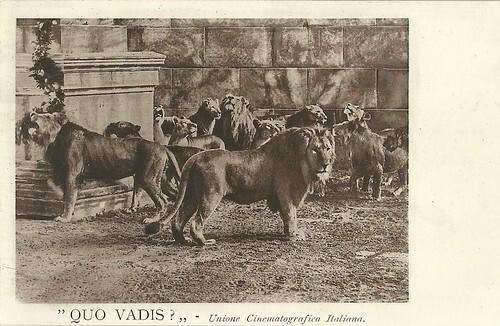
Italian postcard by Ed. L'Argentografica, Turin, no. 3054. Photo: Unione Cinematografia Italiana (UCI). Scene from Quo vadis? (Gabriellino D'Annunzio, Georg Jacoby, 1924).

Italian postcard by Ed. L'Argentografica, Turin, no. 3055. Photo: Unione Cinematografia Italiana (UCI). Scene from Quo vadis? (Gabriellino D'Annunzio, Georg Jacoby, 1924). Alfons Fryland as Vinicius and Lilian Hall-Davis as Licia/Lygia at Nero's banquet.
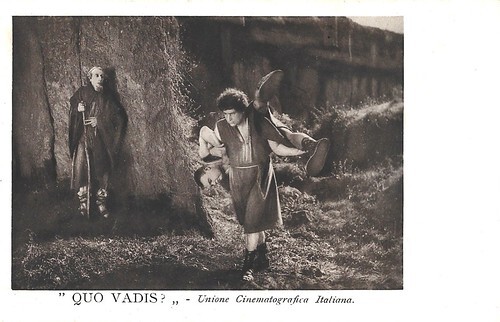
Italian postcard by Ed. L'Argentografica, Turin, no. 3056. Photo: Unione Cinematografia Italiana (UCI). Scene from Quo vadis? (Gabriellino D'Annunzio, Georg Jacoby, 1924). Ursus (Bruto Castellani) has killed the gladiator Croton, who instead had been paid to kill Ursus, in order to abduct Lygia again. The traitor Chilo (Gino Viotti) watches on.
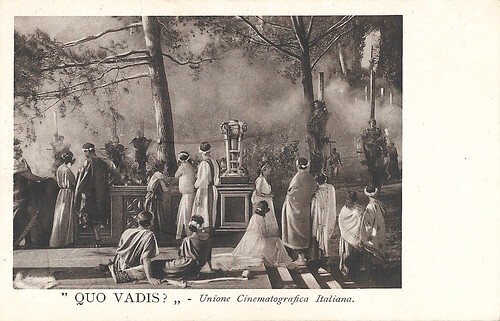
Italian postcard by Ed. L'Argentografica, Turin, no. ?. Photo: Unione Cinematografia Italiana (UCI). Scene from Quo vadis? (Gabriellino D'Annunzio, Georg Jacoby, 1924). Nero's human torches in his gardens.
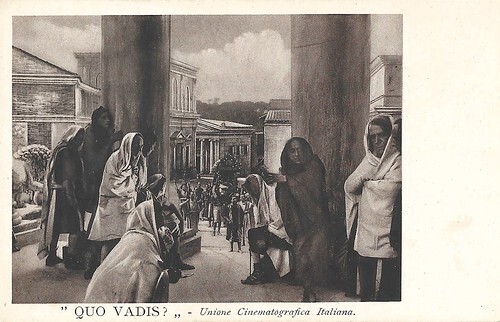
Italian postcard by Ed. L'Argentografica, Turin, no. 3058. Photo: Unione Cinematografia Italiana (UCI). Scene from Quo vadis? (Gabriellino D'Annunzio, Georg Jacoby, 1924). The Abduction of Licia/Lygia.
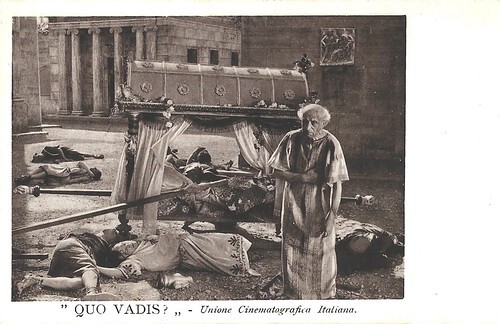
Italian postcard by Ed. L'Argentografica, Turin, no. 3059. Photo: Unione Cinematografia Italiana (UCI). Scene from Quo vadis? (Gabriellino D'Annunzio, Georg Jacoby, 1924). After Licia's/ Lygia's abduction. From 1909 on, the same litter was constantly used in Roman Antiquity films at Cines, including the 1913 Quo vadis?.
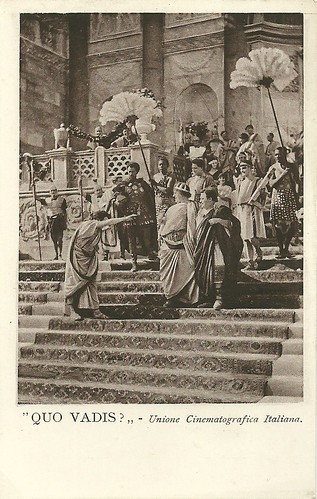
Italian postcard by Edizione L'Argentografica, Torino, no. 3060. Publicity still for the Italo-German epic Quo Vadis? (Gabriellino D'Annunzio & Georg Jacoby, 1924), starring Emil Jannings as Nero.
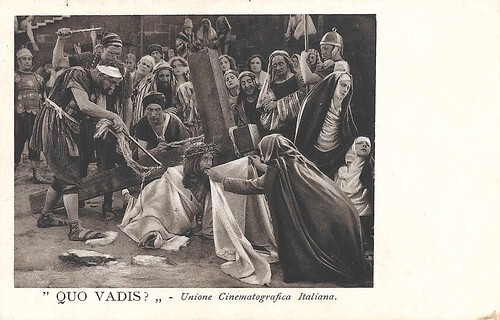
Italian postcard by Ed. L'Argentografica, Turin, no. ?. Photo: Unione Cinematografia Italiana (UCI). Scene from Quo vadis? (Gabriellino D'Annunzio, Georg Jacoby, 1924). Christ has fallen under the Cross, the veil of Veronica.

Italian postcard by Ed. L'Argentografica, Turin, no. 3040. Photo: Unione Cinematografia Italiana (UCI). Scene from Quo vadis? (Gabriellino D'Annunzio, Georg Jacoby, 1924) starring Emil Jannings as Nero and Elena Sangro as Poppea.

Italian postcard by Ed. L'Argentografica, Turin, no. 3041. Photo: Unione Cinematografia Italiana (UCI). Scene from Quo vadis? (Gabriellino D'Annunzio, Georg Jacoby, 1924) starring Alphons Fryland as Vinicius.

Italian postcard by Ed. L'Argentografica, Turin, no. 3042. Photo: Unione Cinematografia Italiana (UCI). Scene from Quo vadis? (Gabriellino D'Annunzio, Georg Jacoby, 1924).

Italian postcard by Ed. L'Argentografica, Turin, no. 3043. Photo: Unione Cinematografia Italiana (UCI). Scene from Quo vadis? (Gabriellino D'Annunzio, Georg Jacoby, 1924).

Italian postcard by Ed. L'Argentografica, Turin, no. 3044. Photo: Unione Cinematografia Italiana (UCI). Scene from Quo vadis? (Gabriellino D'Annunzio, Georg Jacoby, 1924).

Italian postcard by Ed. L'Argentografica, Turin, no. 3046. Photo: Unione Cinematografia Italiana (UCI). Scene from Quo vadis? (Gabriellino D'Annunzio, Georg Jacoby, 1924). The lions in the arena.

Italian postcard by Ed. L'Argentografica, Turin, no. 3047. Photo: Unione Cinematografia Italiana (UCI). Scene from Quo vadis? (Gabriellino D'Annunzio, Georg Jacoby, 1924). Gildo Bocci as Vitellius at Nero's orgy.

Italian postcard by Ed. L'Argentografica, Turin, no. 3048. Photo: Unione Cinematografia Italiana (UCI). Scene from Quo vadis? (Gabriellino D'Annunzio, Georg Jacoby, 1924). Ursus and Licia/Lygia in prison.

Italian postcard by Ed. L'Argentografica, Turin, no. 3049. Photo: Unione Cinematografia Italiana (UCI). Scene from Quo vadis? (Gabriellino D'Annunzio, Georg Jacoby, 1924) starring Alphons Fryland as Vinicius and Lilian Hall-Davis as Licia.

Italian postcard by Ed. L'Argentografica, Turin, no. 3050. Photo: Unione Cinematografia Italiana (UCI). Scene from Quo vadis? (Gabriellino D'Annunzio, Georg Jacoby, 1924), starring Emil Jannings as Nero and Lilian Hall-Davis as Licia. Nero menaces Licia, after having 'saved her from the clutches of Vinicius'.

Italian postcard by Ed. L'Argentografica, Turin, no. 3051. Photo: Unione Cinematografia Italiana (UCI). Scene from Quo vadis? (Gabriellino D'Annunzio, Georg Jacoby, 1924). Roman cavalry in the arena.

Italian postcard by Ed. L'Argentografica, Turin, no. 3052. Photo: Unione Cinematografia Italiana (UCI). Scene from Quo vadis? (Gabriellino D'Annunzio, Georg Jacoby, 1924). Nero's Palace. The man in the litter on the foreground is André Habay who plays Petronius.

Italian postcard by Ed. L'Argentografica, Turin, no. 3054. Photo: Unione Cinematografia Italiana (UCI). Scene from Quo vadis? (Gabriellino D'Annunzio, Georg Jacoby, 1924).

Italian postcard by Ed. L'Argentografica, Turin, no. 3055. Photo: Unione Cinematografia Italiana (UCI). Scene from Quo vadis? (Gabriellino D'Annunzio, Georg Jacoby, 1924). Alfons Fryland as Vinicius and Lilian Hall-Davis as Licia/Lygia at Nero's banquet.

Italian postcard by Ed. L'Argentografica, Turin, no. 3056. Photo: Unione Cinematografia Italiana (UCI). Scene from Quo vadis? (Gabriellino D'Annunzio, Georg Jacoby, 1924). Ursus (Bruto Castellani) has killed the gladiator Croton, who instead had been paid to kill Ursus, in order to abduct Lygia again. The traitor Chilo (Gino Viotti) watches on.

Italian postcard by Ed. L'Argentografica, Turin, no. ?. Photo: Unione Cinematografia Italiana (UCI). Scene from Quo vadis? (Gabriellino D'Annunzio, Georg Jacoby, 1924). Nero's human torches in his gardens.

Italian postcard by Ed. L'Argentografica, Turin, no. 3058. Photo: Unione Cinematografia Italiana (UCI). Scene from Quo vadis? (Gabriellino D'Annunzio, Georg Jacoby, 1924). The Abduction of Licia/Lygia.

Italian postcard by Ed. L'Argentografica, Turin, no. 3059. Photo: Unione Cinematografia Italiana (UCI). Scene from Quo vadis? (Gabriellino D'Annunzio, Georg Jacoby, 1924). After Licia's/ Lygia's abduction. From 1909 on, the same litter was constantly used in Roman Antiquity films at Cines, including the 1913 Quo vadis?.

Italian postcard by Edizione L'Argentografica, Torino, no. 3060. Publicity still for the Italo-German epic Quo Vadis? (Gabriellino D'Annunzio & Georg Jacoby, 1924), starring Emil Jannings as Nero.

Italian postcard by Ed. L'Argentografica, Turin, no. ?. Photo: Unione Cinematografia Italiana (UCI). Scene from Quo vadis? (Gabriellino D'Annunzio, Georg Jacoby, 1924). Christ has fallen under the Cross, the veil of Veronica.
Published on August 08, 2023 22:00
August 7, 2023
Jean Weber
French actor Jean Weber (1906-1995) was a sociétaire (member) of the famous stage company Comédie-Française. He also appeared in several French films during the late 1920s and 1930s.
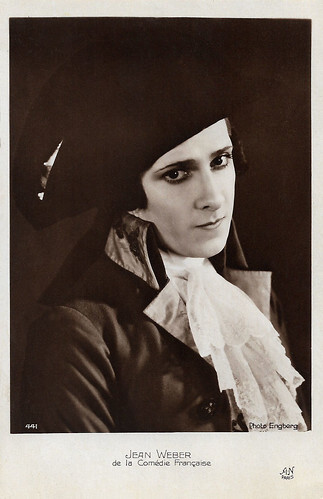
French postcard by A.N., Paris, no. 441. Photo: Engberg. Jean Weber as the Chevalier Marc Rétaux de Villette Le Collier de la reine (Gaston Ravel, Tony Lekain, 1929).
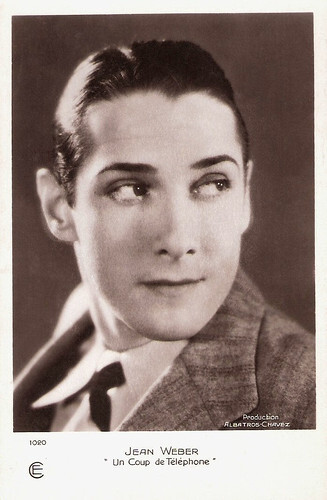
French postcard by EC (Editions Cinematographiques), Paris, no. 1020. Photo: Production Albatros-Chavez. Publicity still for Un Coup de Téléphone/A Phone Call (Georges Lacombe, 1932).
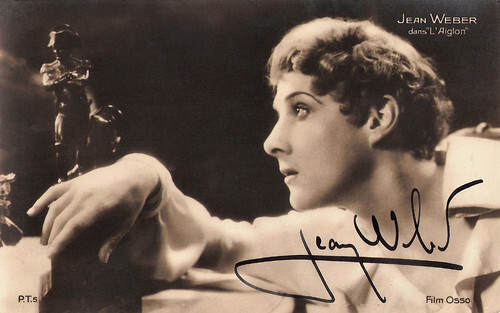
French postcard, no P.T.5. Photo: Film Osso. Jean Weber in L'Aiglon/The Eagle (Victor Tourjansky, 1931).
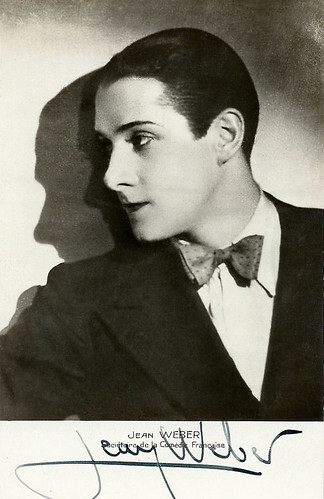
French postcard. Collection: Didier Hanson.
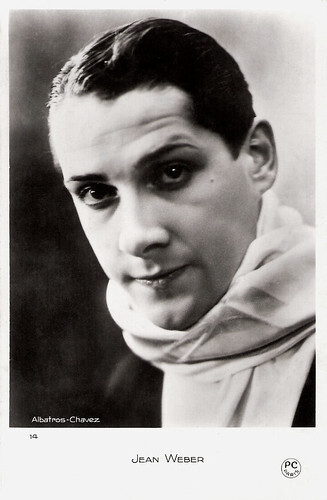
French postcard by PC, Paris, no. 14. Photo: Albatros / Chavez.
Cherubino
Jean-Édouard-Constant Weber was born in Paris, France, in 1906.
In 1925 he joined the Comédie-Française and played that year in plays like 'Les Corbeaux' (The Raven) by Henry Becque, and 'Fantasio' by Alfred de Musset. In 1926, he made his film debut in Eh bien! dansez maintenant/Well, let’s dance! (Émilien Champetier, 1926).
In the following years, he appeared in silent films like Figaro (Gaston Ravel, Tony Lekain, 1929), as the pageboy Cherubino, and the historical drama Le Collier de la reine/The Queen's Necklace (Gaston Ravel, Tony Lekain, 1929), with Marcelle Chantal and Diana Karenne .
He played the title role in the early sound film L'Aiglon (Viktor Tourjansky, 1931) opposite Victor Francen . It was a remake of a silent film, and a remake that made sense because it was based on Edmond Rostand's play so it is necessary to hear the actor's voices.
D.B. du Monteil at IMDb : “The performances may seem old-fashioned for today's audience, the actors overplay as if they were on a stage; Jean Weber, who plays the lead, may seem ridiculous to some, but his performance, which seems extra-terrestrial - he displays some female sensitiveness, one should remember that the part was created on stage by Sarah Bernhardt - is deeply moving, particularly in the last scenes (last act: ‘broken wings’): they wouldn't film a dying man that way nowadays.”
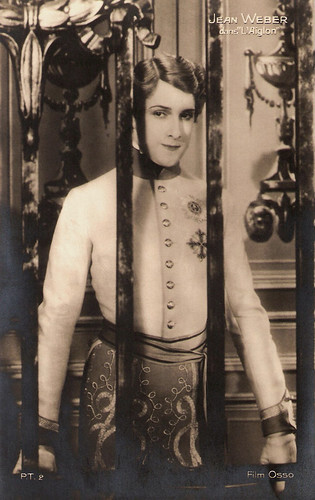
French postcard, no. P.T. 2. Photo: Film Osso. Publicity still for L'aiglon/The Eagle (Victor Tourjansky, 1931).
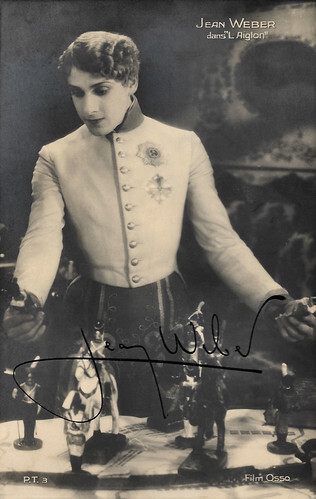
French postcard, no P.T. 3. Photo: Film Osso. Jean Weber in L'Aiglon/The Eagle (Victor Tourjansky, 1931).
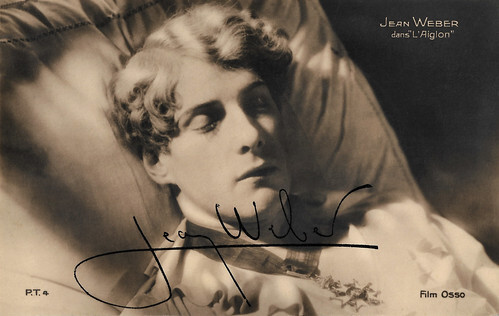
French postcard, no P.T. 4. Photo: Film Osso. Jean Weber and Henri Desfontaines in L'Aiglon/The Eagle (Victor Tourjansky, 1931).
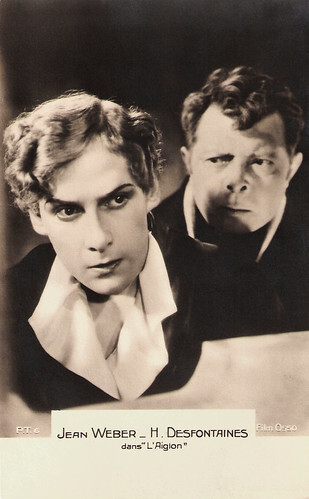
French postcard, no P.T. 6. Photo: Film Osso. Jean Weber and Henri Desfontaines in L'Aiglon/The Eagle (Victor Tourjansky, 1931).
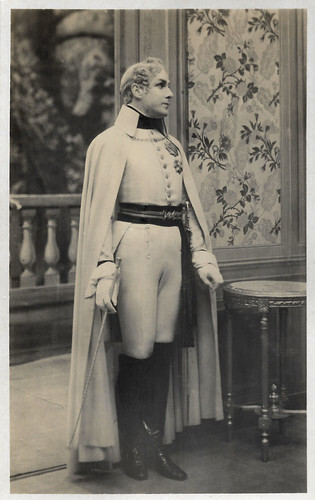
French postcard Photo: Studio Demontrond, Nancy. Jean Weber in L'Aiglon/The Eagle (Victor Tourjansky, 1931).
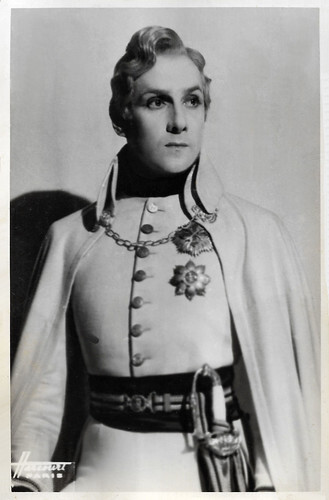
French card. Photo: Harcourt, Paris. Jean Weber in L'Aiglon/The Eagle (Victor Tourjansky, 1931).
Chéri
In 1932, Jean Weber became a sociétaire at the Comédie-Française. The sociétaires of the famous French stage company are chosen from among the pensionnaires who have been in the company a year or more. On becoming a sociétaire, an actor automatically becomes a member of the Société des Comédiens-Française and receives a share of the profits as well as receiving a number of shares in the société to which he or she is contractually linked.
Weber continued to be a sociétaire till 1949. During this period he appeared in a dozen films, including the comedy Tricoche et Cacolet/Tricoche and Cacolet (Pierre Colombier, 1938), starring Fernandel , and the adventure film Le Capitaine Fracasse/Captain Fracasse (Abel Gance, 1943), based on the novel by Théophile Gautier.
During the 1950s he appeared in a few more films. He was among the star cast of Si Paris nous était conté/If Paris Were Told to Us (Sacha Guitry, 1955) about the history of the city of Paris. His final film was Action immédiate (Maurice Labro, 1957), starring Henri Vidal .
In 1961 he appeared on stage in 'Henri III et sa cour' by Alexandre Dumas , directed by Pierre Bertin at the Théâtre de l'Athénée. Later he could be seen on TV in the series Café du square (Louis Daquin, 1969) with Catherine Allégret, and finally, in an registration of Colette ’s play Chéri (Yves-André Hubert, 1984), starring Michèle Morgan and Jean-Pierre Bouvier as Chéri.
Jean Weber died in Neuilly-sur-Seine near Paris in 1995. He was 89.
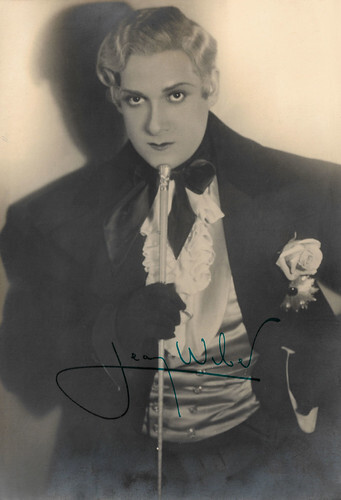
French autograph card.
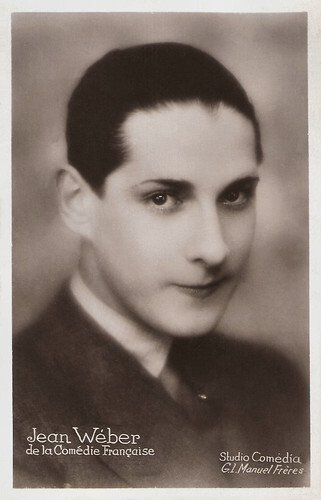
French postcard by Studio Comedia. Photo: G.L. Manuel Frères. Caption: Jean Weber of the Comédie Française.
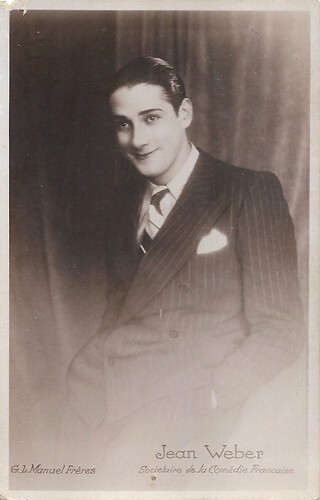
French postcard. Photo: G.L. Manuel Frères. Caption: Jean Weber, Sociétaire de la Comédie Française.
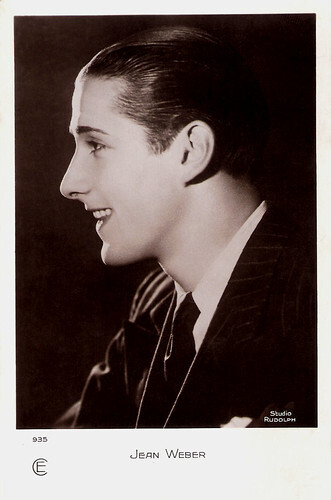
French postcard by CE (Cinémagazine-Edition), Paris, no. 935. Photo: Studio Rudolph.
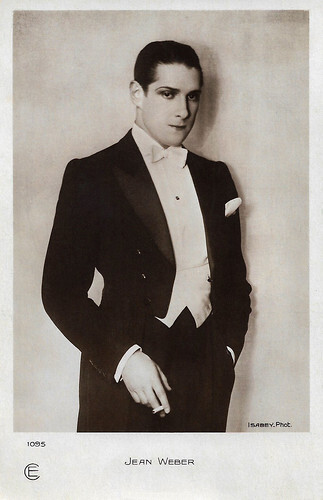
French postcard by CE (Cinémagazine-Edition), no. 1095. Photo: Isabey.
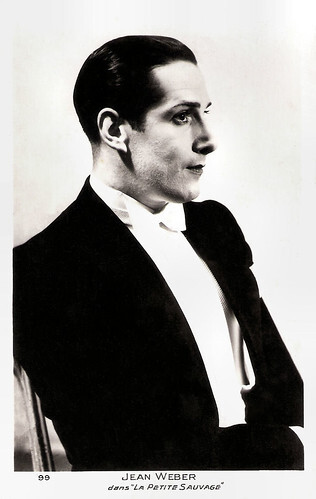
French postcard, no. 99 Photo: Jean Weber in La petite sauvage/The little savage (Jean de Limur, 1936).
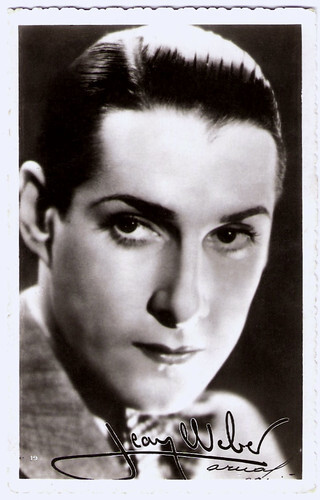
French postcard by Editions et Publications Cinematographiques, no. 19. Photo: Arnal.
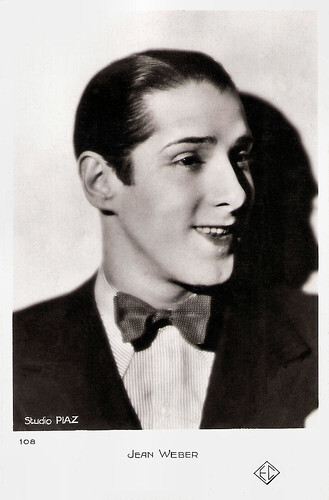
French postcard by EC (Editions Chantal, Paris), no. 108 Photo: Studio Piaz.
Sources: D.B. du Monteil (IMDb), Thomas Staedeli (Cyranos), Wikipedia (French) and .

French postcard by A.N., Paris, no. 441. Photo: Engberg. Jean Weber as the Chevalier Marc Rétaux de Villette Le Collier de la reine (Gaston Ravel, Tony Lekain, 1929).

French postcard by EC (Editions Cinematographiques), Paris, no. 1020. Photo: Production Albatros-Chavez. Publicity still for Un Coup de Téléphone/A Phone Call (Georges Lacombe, 1932).

French postcard, no P.T.5. Photo: Film Osso. Jean Weber in L'Aiglon/The Eagle (Victor Tourjansky, 1931).

French postcard. Collection: Didier Hanson.

French postcard by PC, Paris, no. 14. Photo: Albatros / Chavez.
Cherubino
Jean-Édouard-Constant Weber was born in Paris, France, in 1906.
In 1925 he joined the Comédie-Française and played that year in plays like 'Les Corbeaux' (The Raven) by Henry Becque, and 'Fantasio' by Alfred de Musset. In 1926, he made his film debut in Eh bien! dansez maintenant/Well, let’s dance! (Émilien Champetier, 1926).
In the following years, he appeared in silent films like Figaro (Gaston Ravel, Tony Lekain, 1929), as the pageboy Cherubino, and the historical drama Le Collier de la reine/The Queen's Necklace (Gaston Ravel, Tony Lekain, 1929), with Marcelle Chantal and Diana Karenne .
He played the title role in the early sound film L'Aiglon (Viktor Tourjansky, 1931) opposite Victor Francen . It was a remake of a silent film, and a remake that made sense because it was based on Edmond Rostand's play so it is necessary to hear the actor's voices.
D.B. du Monteil at IMDb : “The performances may seem old-fashioned for today's audience, the actors overplay as if they were on a stage; Jean Weber, who plays the lead, may seem ridiculous to some, but his performance, which seems extra-terrestrial - he displays some female sensitiveness, one should remember that the part was created on stage by Sarah Bernhardt - is deeply moving, particularly in the last scenes (last act: ‘broken wings’): they wouldn't film a dying man that way nowadays.”

French postcard, no. P.T. 2. Photo: Film Osso. Publicity still for L'aiglon/The Eagle (Victor Tourjansky, 1931).

French postcard, no P.T. 3. Photo: Film Osso. Jean Weber in L'Aiglon/The Eagle (Victor Tourjansky, 1931).

French postcard, no P.T. 4. Photo: Film Osso. Jean Weber and Henri Desfontaines in L'Aiglon/The Eagle (Victor Tourjansky, 1931).

French postcard, no P.T. 6. Photo: Film Osso. Jean Weber and Henri Desfontaines in L'Aiglon/The Eagle (Victor Tourjansky, 1931).

French postcard Photo: Studio Demontrond, Nancy. Jean Weber in L'Aiglon/The Eagle (Victor Tourjansky, 1931).

French card. Photo: Harcourt, Paris. Jean Weber in L'Aiglon/The Eagle (Victor Tourjansky, 1931).
Chéri
In 1932, Jean Weber became a sociétaire at the Comédie-Française. The sociétaires of the famous French stage company are chosen from among the pensionnaires who have been in the company a year or more. On becoming a sociétaire, an actor automatically becomes a member of the Société des Comédiens-Française and receives a share of the profits as well as receiving a number of shares in the société to which he or she is contractually linked.
Weber continued to be a sociétaire till 1949. During this period he appeared in a dozen films, including the comedy Tricoche et Cacolet/Tricoche and Cacolet (Pierre Colombier, 1938), starring Fernandel , and the adventure film Le Capitaine Fracasse/Captain Fracasse (Abel Gance, 1943), based on the novel by Théophile Gautier.
During the 1950s he appeared in a few more films. He was among the star cast of Si Paris nous était conté/If Paris Were Told to Us (Sacha Guitry, 1955) about the history of the city of Paris. His final film was Action immédiate (Maurice Labro, 1957), starring Henri Vidal .
In 1961 he appeared on stage in 'Henri III et sa cour' by Alexandre Dumas , directed by Pierre Bertin at the Théâtre de l'Athénée. Later he could be seen on TV in the series Café du square (Louis Daquin, 1969) with Catherine Allégret, and finally, in an registration of Colette ’s play Chéri (Yves-André Hubert, 1984), starring Michèle Morgan and Jean-Pierre Bouvier as Chéri.
Jean Weber died in Neuilly-sur-Seine near Paris in 1995. He was 89.

French autograph card.

French postcard by Studio Comedia. Photo: G.L. Manuel Frères. Caption: Jean Weber of the Comédie Française.

French postcard. Photo: G.L. Manuel Frères. Caption: Jean Weber, Sociétaire de la Comédie Française.

French postcard by CE (Cinémagazine-Edition), Paris, no. 935. Photo: Studio Rudolph.

French postcard by CE (Cinémagazine-Edition), no. 1095. Photo: Isabey.

French postcard, no. 99 Photo: Jean Weber in La petite sauvage/The little savage (Jean de Limur, 1936).

French postcard by Editions et Publications Cinematographiques, no. 19. Photo: Arnal.

French postcard by EC (Editions Chantal, Paris), no. 108 Photo: Studio Piaz.
Sources: D.B. du Monteil (IMDb), Thomas Staedeli (Cyranos), Wikipedia (French) and .
Published on August 07, 2023 22:00
August 6, 2023
Merle Oberon
Indian-born British actress Merle Oberon (1911-1979) had her breakthrough as Anna Boleyn in The Private Life of Henry VIII (1933). She played leading roles in such British films as The Scarlet Pimpernel (1934) before she travelled to Hollywood to star in classics such as The Dark Angel (1935) and Wuthering Heights (1939).
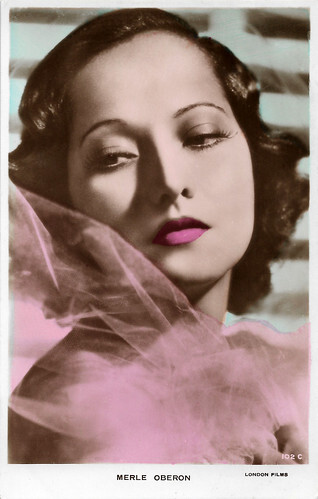
British Real Photograph postcard, no. 102c. Photo: London Films.
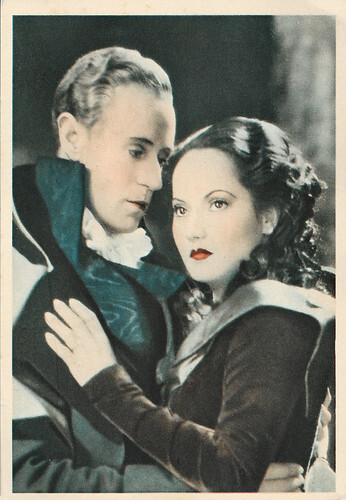
British postcard by De Reszke Cigarettes, no. 44. Photo: London Films. Leslie Howard and Merle Oberon in The Scarlet Pimpernel (Harold Young, 1934).
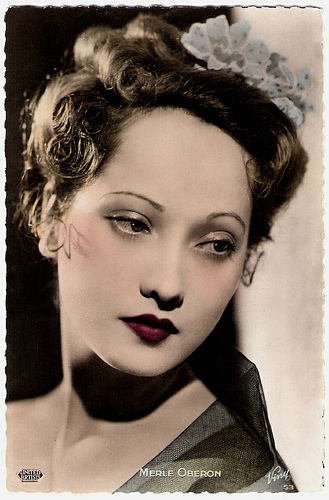
French postcard by Viny, no. 53. Photo: United Artists.
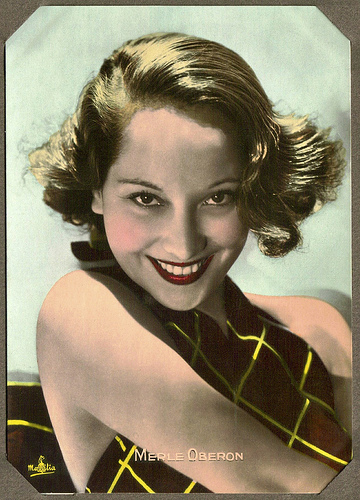
French card by Massilia. Collection: Amit Benyovits.
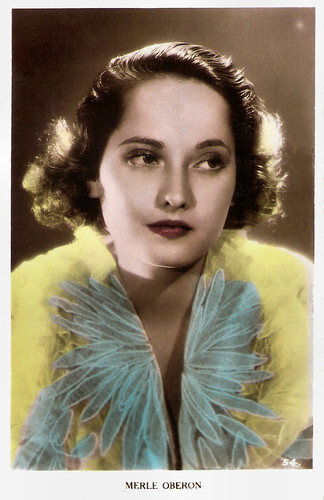
British postcard by Art Photo, no. 54.
Queenie
From the early days of her career, Merle Oberon succeeded in establishing a fabricated history of her origins in which she said that she had been born in Tasmania, Australia. According to her birth certificate though, Oberon was born in Bombay, British India in 1911 as Estelle Merle Thompson.
Merle was given ´Queenie´ as a nickname, in honour of Queen Mary who visited India along with King George V in 1911. Her parentage has remained deliberately obscure over the years. Some sources claim Charlotte Selby, a Eurasian from Ceylon with partial Māori heritage, and Arthur Terrence O'Brien Thompson, a British mechanical engineer from Darlington, who worked in Indian Railways, as Merle's parents.
At the age of fourteen years, Charlotte had given birth to her first child Constance, in Ceylon, from a relationship with Henry Alfred Selby, an Irish foreman of a tea planter. Some sources claim that Constance was the biological mother of Merle, even though Charlotte raised Merle as her own child. Merle believed the truth about her parentage would have destroyed her career prospects due to societal expectations and restrictions at that time. In 1914, Arthur Thompson joined the British Army and later died of pneumonia on the Western Front during the Battle of the Somme. Merle, with her mother (or grandmother), led an impoverished existence in shabby Bombay flats for a few years.
Then, in 1917, they moved to better circumstances in Calcutta. Oberon received a foundation scholarship to attend La Martiniere Calcutta for Girls, a well-known Calcutta private school. There, she was constantly taunted for her unconventional parentage and eventually quit school and had her lessons at home. Oberon first performed with the Calcutta Amateur Dramatic Society. She was also completely enamoured of the cinema and enjoyed going out to nightclubs. As she entered her teen years, she dated increasingly older, urbane men.
In 1928, she dated a former actor named Colonel Ben Finney. He promised to introduce her to Rex Ingram of Victorine Studios if she could come to France. Oberon jumped at the offer and decided to follow the man to the studios in France. There, Oberon and her mother found that their supposed benefactor had dodged them, but he had left a good word for her with Rex Ingram who liked Oberon's exotic appearance. He hired her as an extra in a party scene in The Three Passions (Rex Ingram, 1928) starring Alice Terry and Iván Petrovich .
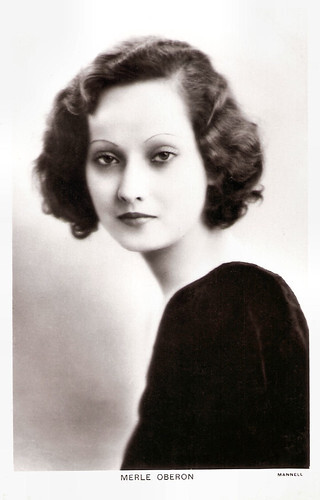
British postcard in the Picturegoer series. Photo by London-based British studio photographer George Mannell.
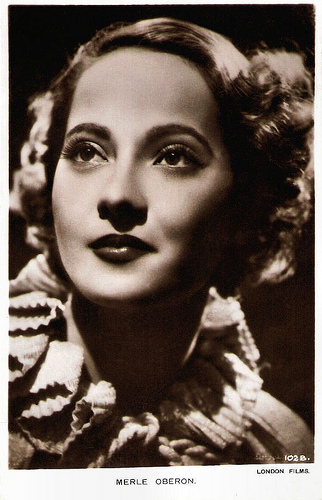 British 'Real Photograph' postcard, no. 102B. Photo: London Films.
British 'Real Photograph' postcard, no. 102B. Photo: London Films.
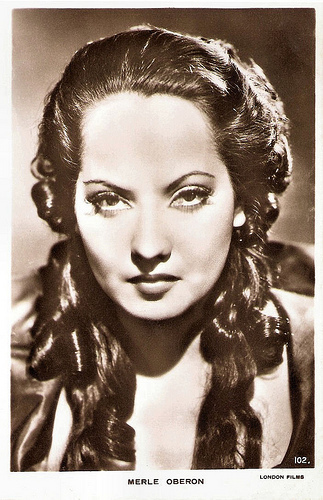
British postcard by Real Photograph, London, no. 102. Photo: London Films.
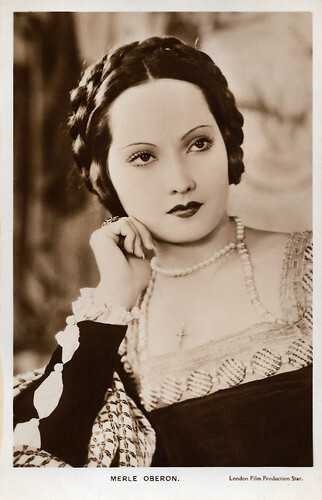
British Real Photograph postcard. Photo: London Film Production. Merle Oberon in The Private Life of Henry VIII (Alexander Korda, 1933).
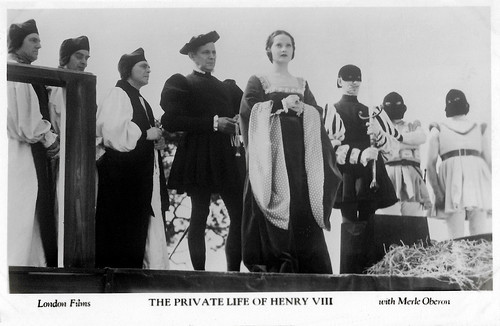
British postcard in the Filmshots series by Film Weekly. Photo: London Films. Merle Oberon in The Private Life of Henry VIII (Alexander Korda, 1933).
Anne Boleyn
Merle Oberon moved to England in 1928. Initially, she worked as a club hostess under the name Queenie O'Brien and played as an extra in various films. Finally, she landed a part with substance: the role of Ysobel d'Aunay in Men of Tomorrow (Zoltan Korda, Leontine Sagan, 1933) with Robert Donat .
She combined a slightly frosty reserve and a distinctive British accent with a somewhat exotic beauty which suggested a passionate nature. Her career went on to greater heights, thanks to director-producer Alexander Korda, who persuaded her to take the name under which she became famous.
Korda gave her a small but prominent role, under the name Merle Oberon, as Anne Boleyn in The Private Life of Henry VIII (1933) opposite Charles Laughton .
The film became a major success and Korda gave her leading roles, such as the temperamental dancer Antonita in The Private Life of Don Juan (Alexander Korda, 1934) opposite Douglas Fairbanks Sr. , and Lady Blakeney in The Scarlet Pimpernel (Harold Young, 1934) with Leslie Howard , who became her lover for a while.
Oberon went to great lengths to disguise her mixed-race background and when her dark-skinned mother moved in with her, she masqueraded as Oberon's maid.
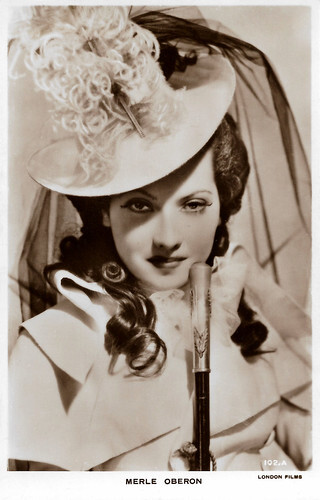
British Real Photograph postcard, no. 102a. Photo: London Film. Merle Oberon in The Scarlet Pimpernel (Alexander Korda, 1934).
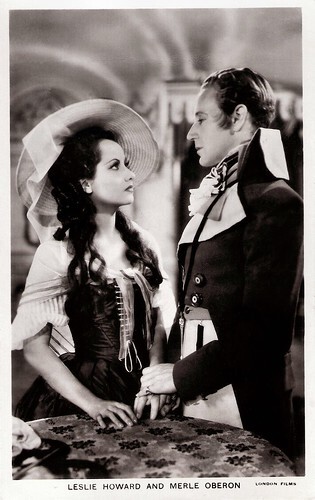
British postcard in the Film Partners Series, London, no. P 150. Photo: London Films. Leslie Howard and Merle Oberon in The Scarlet Pimpernel (Harold Young, 1934).
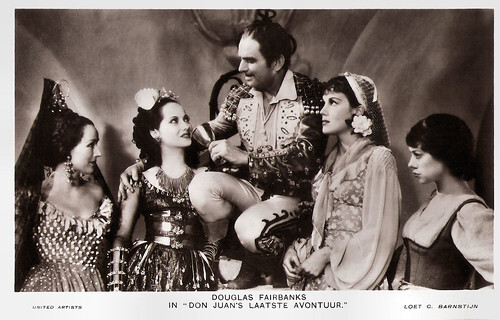
Dutch postcard. Photo: Loet C. Barnstijn / United Artists. Douglas Fairbanks and Merle Oberon in The Private Life of Don Juan (Alexander Korda, 1934), based on the play 'L'Homme de la rose' by Henry Bataille.
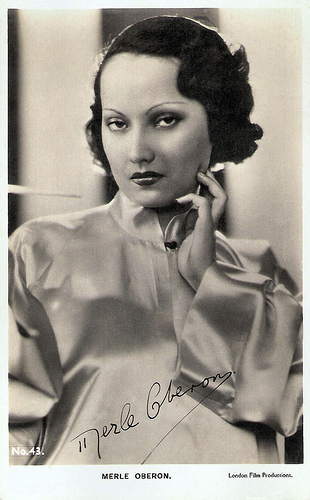
British postcard in the Film-Kurier series, no. 43. Photo: London Film Production.
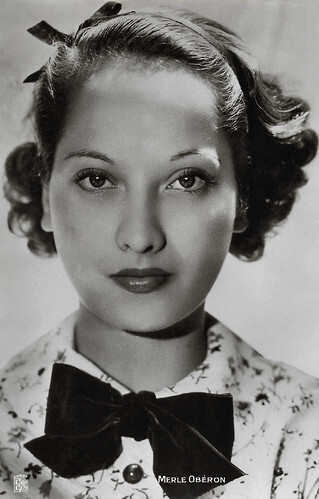
French postcard by Editions et Publications cinématographiques (EPC).
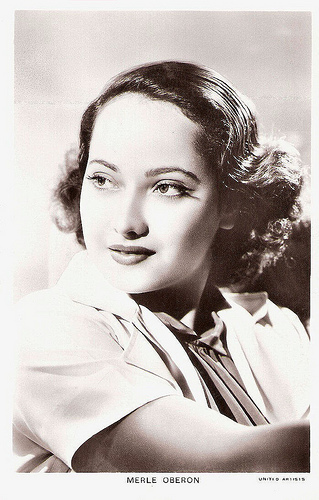
British postcard by Real Photograph, London, in the Picturegoer series, no. 820c. Photo: United Artists.
Cathy
Alexander Korda sold 'shares' of Merle Oberon´s contract to producer Samuel Goldwyn, who gave her good vehicles in Hollywood. Her 'mother' stayed behind in England. Oberon received her only Oscar nomination as Best Actress for The Dark Angel (Sidney Franklin, 1935) opposite Fredric March .
Her work in that film resulted in offers for more quality pictures, and she appeared in several well-received films, such as These Three (William Wyler, 1936), a worthy but altered adaptation of Lillian Hellman's The Children's Hour in which a scandalous lesbian romance was rewritten as a heterosexual triangle.
Next she appeared in Over the Moon (Thornton Freeland, 1936) with Rex Harrison , and The Divorce of Lady X (Tim Whelan, 1938).
She was selected to star in Korda's epic film I, Claudius (Josef von Sternberg, 1937) as Messalina, but unfortunately, the film was abandoned in mid-production after Oberon was seriously injured in a 1937 car crash. Oberon was scarred for life, but skilled lighting technicians were able to hide her injuries from cinema audiences.
She went on to appear as Cathy in Wuthering Heights (William Wyler, 1939) opposite Laurence Olivier as Heathcliff. It would become her best-remembered performance.
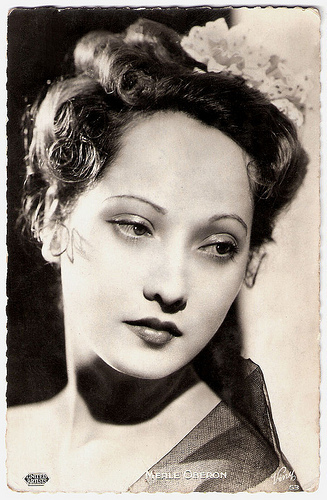
French postcard by Viny, no. 53. Photo: United Artists.
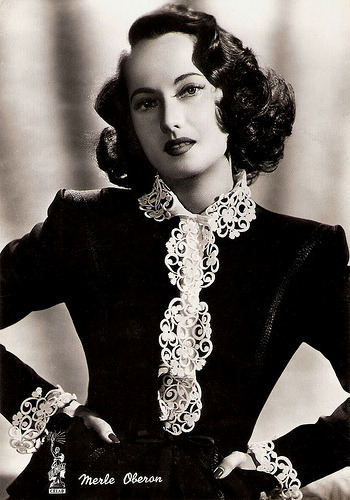
Italian postcard by Rotalfoto, Milano, no. 46. Photo: Columbia / CEIAD.
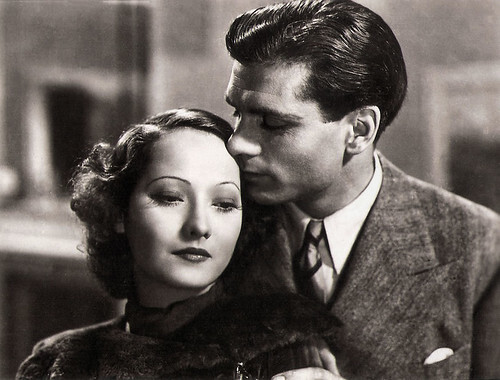
Spanish card, no. 1074. Merle Oberon and Laurence Olivier in The Divorce of Lady X (Tim Whelan, 1938).
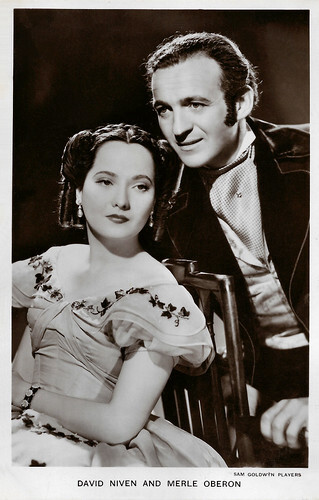
British postcard in the Film Partners Series, London, no. P 285. Photo: Sam Goldwyn. Merle Oberon and David Niven in Wuthering Heights (William Wyler, 1939).
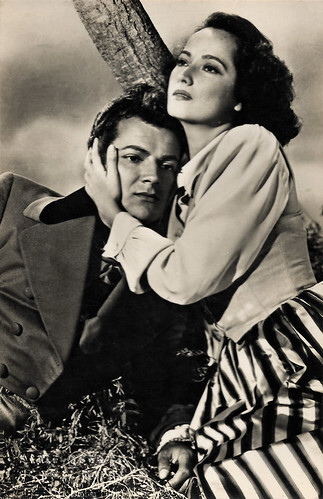
Spanish postcard by Proa, no. 519. Photo: Merle Oberon as George Sand and Cornel Wilde as Frédéric Chopin in A Song to Remember (Charles Vidor, 1945). Sent by mail in 1950.
George Sand
The 1940s proved to be a very busy decade for Merle Oberon, as she appeared in no less than 15 films, including That Uncertain Feeling (Ernst Lubitsch, 1941), The Lodger (John Brahm, 1944) about Jack the Ripper, and A Song to Remember (Charles Vidor, 1945) as the tempestuous and unconventional author George Sand.
Oberon became Lady Korda upon her husband's knighthood in 1942. She divorced him in 1945, to marry cinematographer Lucien Ballard. Ballard devised a special camera light for her to eliminate her facial scars on film. The light became known as the Obie.
After her role in Berlin Express (Jacques Tourneur, 1948), she would not be seen on the screen again until four years later, as Elizabeth Rockwell in Pardon My French (Bernard Vorhaus, 1951). She then appeared as Empress Josephine in Désirée (Henry Koster, 1954) with Marlon Brando and Jean Simmons . Unfortunately, she began appearing in fewer and fewer films over the ensuing years. After her divorce from Ballard in 1949, she married Italian-born industrialist Bruno Pagliai (from 1957 to 1973). They adopted two children, Francesca Pagliai and Bruno Pagliai Jr.
Her final film was Interval (Daniel Mann, 1973) which she also produced, and co-edited. According to Bruce Eder of AllMovie , it is “a strange romantic drama that costarred Dutch actor Robert Wolders, that failed to find good reviews or an audience”. After that, she retired and lived in Malibu, California. In 1975 she married Robert Wolders who would later become Audrey Hepburn 's and Leslie Caron 's companion.
In 1979 she died in Malibu after suffering a stroke at the age of 68. She left most of her money to be divided between her children. She left $1 million to the Motion Picture Country Home and Hospital. Her husband, Robert Wolders, got nothing, at his own request. Merle Oberon has a star on the Hollywood Walk of Fame for her contributions to Motion Pictures. Her strange and affecting true life story was the subject of Michael (nephew of Alexander) Korda's best-seller, Queenie (1985). This book was made into a TV miniseries, Queenie (1987) starring Mia Sara.
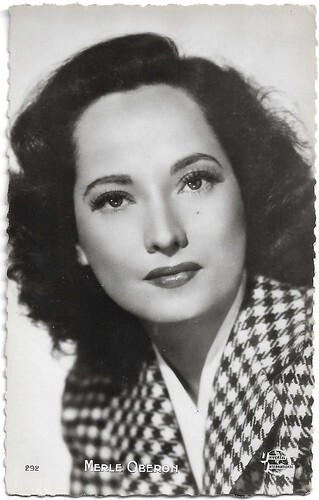
French postcard, no. 292. Photo: Universal International.
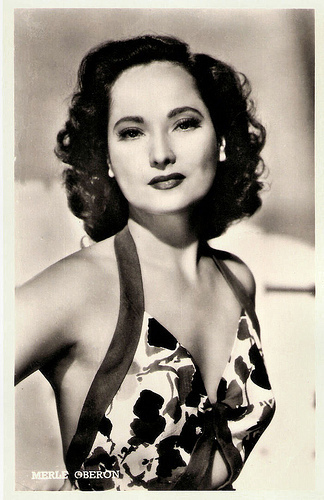
Dutch postcard by J.S.A. Photo: Universal M.P.E.
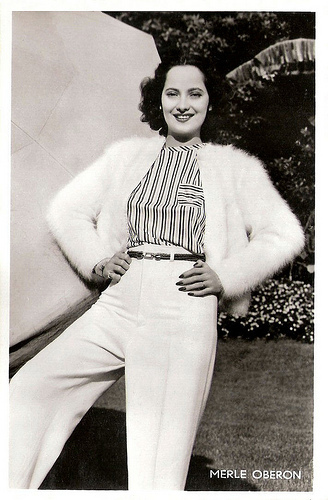
Dutch postcard.
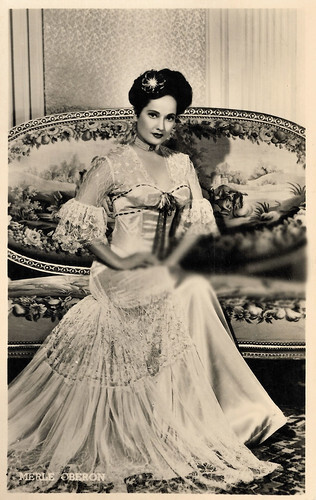
Dutch postcard by J.S.A. Photo: Universal M.P.E.
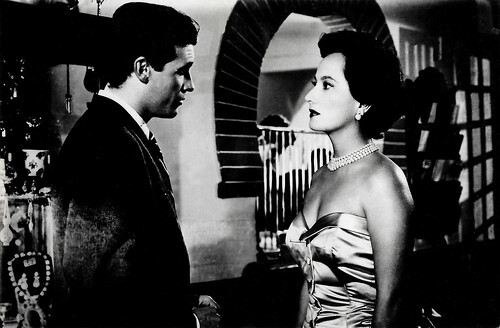
Spanish postcard. Francisco Rabal and Merle Oberon in Todo es posible en Granada/All is possible in Granada (José Luis Sáenz de Heredia, 1954).
Sources: Brian McFarlane (Encyclopedia of British Film), (IMDb), Bruce Eder (AllMovie), Turner Classic Movies, Wikipedia and .

British Real Photograph postcard, no. 102c. Photo: London Films.

British postcard by De Reszke Cigarettes, no. 44. Photo: London Films. Leslie Howard and Merle Oberon in The Scarlet Pimpernel (Harold Young, 1934).

French postcard by Viny, no. 53. Photo: United Artists.

French card by Massilia. Collection: Amit Benyovits.

British postcard by Art Photo, no. 54.
Queenie
From the early days of her career, Merle Oberon succeeded in establishing a fabricated history of her origins in which she said that she had been born in Tasmania, Australia. According to her birth certificate though, Oberon was born in Bombay, British India in 1911 as Estelle Merle Thompson.
Merle was given ´Queenie´ as a nickname, in honour of Queen Mary who visited India along with King George V in 1911. Her parentage has remained deliberately obscure over the years. Some sources claim Charlotte Selby, a Eurasian from Ceylon with partial Māori heritage, and Arthur Terrence O'Brien Thompson, a British mechanical engineer from Darlington, who worked in Indian Railways, as Merle's parents.
At the age of fourteen years, Charlotte had given birth to her first child Constance, in Ceylon, from a relationship with Henry Alfred Selby, an Irish foreman of a tea planter. Some sources claim that Constance was the biological mother of Merle, even though Charlotte raised Merle as her own child. Merle believed the truth about her parentage would have destroyed her career prospects due to societal expectations and restrictions at that time. In 1914, Arthur Thompson joined the British Army and later died of pneumonia on the Western Front during the Battle of the Somme. Merle, with her mother (or grandmother), led an impoverished existence in shabby Bombay flats for a few years.
Then, in 1917, they moved to better circumstances in Calcutta. Oberon received a foundation scholarship to attend La Martiniere Calcutta for Girls, a well-known Calcutta private school. There, she was constantly taunted for her unconventional parentage and eventually quit school and had her lessons at home. Oberon first performed with the Calcutta Amateur Dramatic Society. She was also completely enamoured of the cinema and enjoyed going out to nightclubs. As she entered her teen years, she dated increasingly older, urbane men.
In 1928, she dated a former actor named Colonel Ben Finney. He promised to introduce her to Rex Ingram of Victorine Studios if she could come to France. Oberon jumped at the offer and decided to follow the man to the studios in France. There, Oberon and her mother found that their supposed benefactor had dodged them, but he had left a good word for her with Rex Ingram who liked Oberon's exotic appearance. He hired her as an extra in a party scene in The Three Passions (Rex Ingram, 1928) starring Alice Terry and Iván Petrovich .

British postcard in the Picturegoer series. Photo by London-based British studio photographer George Mannell.
 British 'Real Photograph' postcard, no. 102B. Photo: London Films.
British 'Real Photograph' postcard, no. 102B. Photo: London Films.
British postcard by Real Photograph, London, no. 102. Photo: London Films.

British Real Photograph postcard. Photo: London Film Production. Merle Oberon in The Private Life of Henry VIII (Alexander Korda, 1933).

British postcard in the Filmshots series by Film Weekly. Photo: London Films. Merle Oberon in The Private Life of Henry VIII (Alexander Korda, 1933).
Anne Boleyn
Merle Oberon moved to England in 1928. Initially, she worked as a club hostess under the name Queenie O'Brien and played as an extra in various films. Finally, she landed a part with substance: the role of Ysobel d'Aunay in Men of Tomorrow (Zoltan Korda, Leontine Sagan, 1933) with Robert Donat .
She combined a slightly frosty reserve and a distinctive British accent with a somewhat exotic beauty which suggested a passionate nature. Her career went on to greater heights, thanks to director-producer Alexander Korda, who persuaded her to take the name under which she became famous.
Korda gave her a small but prominent role, under the name Merle Oberon, as Anne Boleyn in The Private Life of Henry VIII (1933) opposite Charles Laughton .
The film became a major success and Korda gave her leading roles, such as the temperamental dancer Antonita in The Private Life of Don Juan (Alexander Korda, 1934) opposite Douglas Fairbanks Sr. , and Lady Blakeney in The Scarlet Pimpernel (Harold Young, 1934) with Leslie Howard , who became her lover for a while.
Oberon went to great lengths to disguise her mixed-race background and when her dark-skinned mother moved in with her, she masqueraded as Oberon's maid.

British Real Photograph postcard, no. 102a. Photo: London Film. Merle Oberon in The Scarlet Pimpernel (Alexander Korda, 1934).

British postcard in the Film Partners Series, London, no. P 150. Photo: London Films. Leslie Howard and Merle Oberon in The Scarlet Pimpernel (Harold Young, 1934).

Dutch postcard. Photo: Loet C. Barnstijn / United Artists. Douglas Fairbanks and Merle Oberon in The Private Life of Don Juan (Alexander Korda, 1934), based on the play 'L'Homme de la rose' by Henry Bataille.

British postcard in the Film-Kurier series, no. 43. Photo: London Film Production.

French postcard by Editions et Publications cinématographiques (EPC).

British postcard by Real Photograph, London, in the Picturegoer series, no. 820c. Photo: United Artists.
Cathy
Alexander Korda sold 'shares' of Merle Oberon´s contract to producer Samuel Goldwyn, who gave her good vehicles in Hollywood. Her 'mother' stayed behind in England. Oberon received her only Oscar nomination as Best Actress for The Dark Angel (Sidney Franklin, 1935) opposite Fredric March .
Her work in that film resulted in offers for more quality pictures, and she appeared in several well-received films, such as These Three (William Wyler, 1936), a worthy but altered adaptation of Lillian Hellman's The Children's Hour in which a scandalous lesbian romance was rewritten as a heterosexual triangle.
Next she appeared in Over the Moon (Thornton Freeland, 1936) with Rex Harrison , and The Divorce of Lady X (Tim Whelan, 1938).
She was selected to star in Korda's epic film I, Claudius (Josef von Sternberg, 1937) as Messalina, but unfortunately, the film was abandoned in mid-production after Oberon was seriously injured in a 1937 car crash. Oberon was scarred for life, but skilled lighting technicians were able to hide her injuries from cinema audiences.
She went on to appear as Cathy in Wuthering Heights (William Wyler, 1939) opposite Laurence Olivier as Heathcliff. It would become her best-remembered performance.

French postcard by Viny, no. 53. Photo: United Artists.

Italian postcard by Rotalfoto, Milano, no. 46. Photo: Columbia / CEIAD.

Spanish card, no. 1074. Merle Oberon and Laurence Olivier in The Divorce of Lady X (Tim Whelan, 1938).

British postcard in the Film Partners Series, London, no. P 285. Photo: Sam Goldwyn. Merle Oberon and David Niven in Wuthering Heights (William Wyler, 1939).

Spanish postcard by Proa, no. 519. Photo: Merle Oberon as George Sand and Cornel Wilde as Frédéric Chopin in A Song to Remember (Charles Vidor, 1945). Sent by mail in 1950.
George Sand
The 1940s proved to be a very busy decade for Merle Oberon, as she appeared in no less than 15 films, including That Uncertain Feeling (Ernst Lubitsch, 1941), The Lodger (John Brahm, 1944) about Jack the Ripper, and A Song to Remember (Charles Vidor, 1945) as the tempestuous and unconventional author George Sand.
Oberon became Lady Korda upon her husband's knighthood in 1942. She divorced him in 1945, to marry cinematographer Lucien Ballard. Ballard devised a special camera light for her to eliminate her facial scars on film. The light became known as the Obie.
After her role in Berlin Express (Jacques Tourneur, 1948), she would not be seen on the screen again until four years later, as Elizabeth Rockwell in Pardon My French (Bernard Vorhaus, 1951). She then appeared as Empress Josephine in Désirée (Henry Koster, 1954) with Marlon Brando and Jean Simmons . Unfortunately, she began appearing in fewer and fewer films over the ensuing years. After her divorce from Ballard in 1949, she married Italian-born industrialist Bruno Pagliai (from 1957 to 1973). They adopted two children, Francesca Pagliai and Bruno Pagliai Jr.
Her final film was Interval (Daniel Mann, 1973) which she also produced, and co-edited. According to Bruce Eder of AllMovie , it is “a strange romantic drama that costarred Dutch actor Robert Wolders, that failed to find good reviews or an audience”. After that, she retired and lived in Malibu, California. In 1975 she married Robert Wolders who would later become Audrey Hepburn 's and Leslie Caron 's companion.
In 1979 she died in Malibu after suffering a stroke at the age of 68. She left most of her money to be divided between her children. She left $1 million to the Motion Picture Country Home and Hospital. Her husband, Robert Wolders, got nothing, at his own request. Merle Oberon has a star on the Hollywood Walk of Fame for her contributions to Motion Pictures. Her strange and affecting true life story was the subject of Michael (nephew of Alexander) Korda's best-seller, Queenie (1985). This book was made into a TV miniseries, Queenie (1987) starring Mia Sara.

French postcard, no. 292. Photo: Universal International.

Dutch postcard by J.S.A. Photo: Universal M.P.E.

Dutch postcard.

Dutch postcard by J.S.A. Photo: Universal M.P.E.

Spanish postcard. Francisco Rabal and Merle Oberon in Todo es posible en Granada/All is possible in Granada (José Luis Sáenz de Heredia, 1954).
Sources: Brian McFarlane (Encyclopedia of British Film), (IMDb), Bruce Eder (AllMovie), Turner Classic Movies, Wikipedia and .
Published on August 06, 2023 22:00
August 5, 2023
Bernadette Lafont
French actress Bernadette Lafont (1938-2013) appeared in several classics of the Nouvelle Vague. Original and full of contradictions, she was both sexy and rather plain, brassy and quite serious, a mixture of intellect, sensuality and humour.
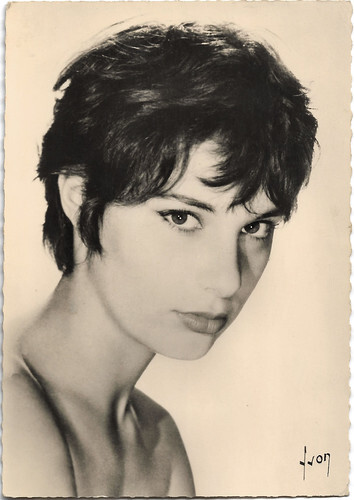
French postcard by Editions d'Art Yvon, Paris, no. 212. Photo: Sam Lévin.
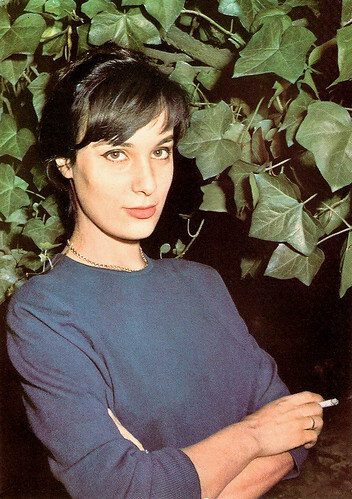
French postcard by Editions P.I., Paris, no. 1076, offered by Les Carbones Kores 'Carboplane'. Photo: Noa.
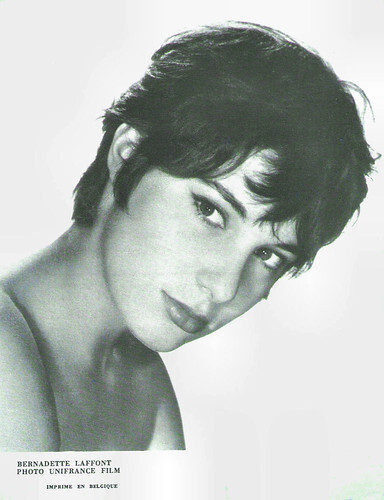
Belgian collectors card for Cine Rio à Coxyde. Photo: Unifrance Film.
The right place at the right time
Bernadette Paule Anne Lafont was born in Nîmes in the South of France in 1938. She was the daughter of a pharmacist and his wife. As a teenager, she started her career as a dancer. She entered the Opéra de Nîmes where she fell in love with her future husband, the handsome actor Gérard Blain .
In Paris, she met the young critic and aspiring film director François Truffaut , who offered her a role in his second short film, shot in Nîmes. So she made her screen debut in Les Mistons/The Mischief Makers (Francois Truffaut, 1957) opposite Gérard Blain . It was a comedy about five kids, who spy on two lovers during a hot summer day. It turned out to be that she was in the right place at the right time to catch the Nouvelle Vague movement, the New Wave of filmmakers that would revolutionise the cinema.
She starred particularly in films by Truffaut and by Claude Chabrol. Her first feature and still one of her best-known films is Le Beau Serge/Bitter Reunion (Claude Chabrol, 1958) with Gérard Blain and Jean-Claude Brialy. She had married Blain the year before but they would divorce a year later. Many Nouvelle Vague films followed.
With Chabrol, she also made À double tour/Leda (Claude Chabrol, 1959) starring Madeleine Robinson , Les bonnes femmes/The Good Time Girls (Claude Chabrol, 1960) with Stéphane Audran , and Les godelureaux/Wise Guys (Claude Chabrol, 1961). She appeared in Truffaut’s comedy Tire-au-flanc 62/The Army Game (Claude de Givray, François Truffaut, 1960), and was the feisty heroine of Truffaut’s Une belle fille comme moi/A Gorgeous Bird Like Me (François Truffaut, 1972).
For Louis Malle, she did a supporting part in his comedy Le voleur/The Thief of Paris (Louis Malle, 1967) starring Jean-Paul Belmondo , and for Jacques Rivette, she joined the cast of Out 1, noli me tangere/Out 1 (Jacques Rivette, Suzanne Schiffman, 1971) and Out 1: Spectre (Jacques Rivette, 1974). Finally, she played the role of Marie, one-third of the trio of lovers in La Maman et la Putain/The Mother and the Whore (Jean Eustache, 1973), considered by some critics as the last film of the Nouvelle Vague.
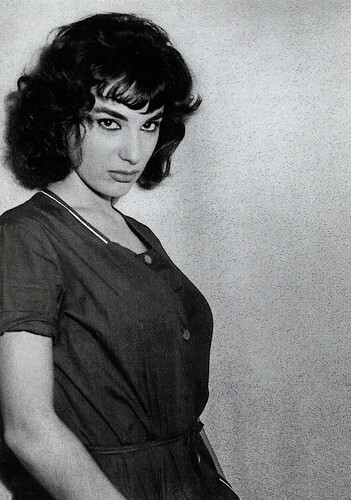
French postcard in the Portrait de Stars by L'Aventure Carto, 2003, no. 12. photo: Marcel Thomas / Collection Gérard Gagnepain.
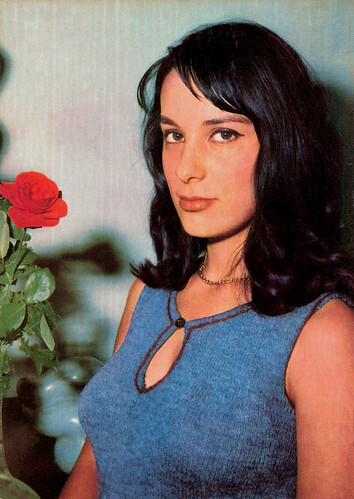
French postcard by Editions Borde, Paris, no. 124. Photo: Morel.

French postcard by Editions La Malibran, Paris, no. CF 31. Photo: P. Lhomme. Jean-Pierre Léaud , Françoise Lebrun and Bernadette Lafont in La Maman et la Putain (Jean Eustache, 1973).
Always a strong presence
A well-known film with Bernadette Lafont is La Fiancée du Pirate/A Very Curious Girl (Nelly Kaplan, 1969). The success of this film about violence against women renewed her career after a difficult period. She was seen in Les stances à Sophie/Sophie’s Ways (Moshé Mizrahi, 1971), the crime drama Zig Zig (László Szabó, 1975) with Catherine Deneuve , and had a small part as the cellmate of Isabelle Huppert in Violette Nozière (Claude Chabrol, 1978).
In Italy, she appeared in the comedy Il Ladrone/The Thief (Pasquale Festa Campanile, 1980). In a 1997 New York Times article, Katherine Knorr writes: “Lafont has in a tumultuous life done a bit of everything, from television movies to the stage, never quite the megastar but always a strong presence, smart and messed up all at the same time”. In the 1980s she appeared in Chabrol’s crime films Inspecteur Lavardin/Inspector Lavardin (Claude Chabrol, 1986) featuring Jean Poiret, and Masques/Masks (Claude Chabrol, 1987) with Philippe Noiret . She also played in Les saisons du plaisir/The Pleasure Seasons (1988) and other comedies by Jean-Pierre Mocky.
Lafont won the César Award for Best Actress in a Supporting Role for L'Effrontée/Charlotte and Lulu (Claude Miller, 1985) starring Charlotte Gainsbourg . The energetic Lafont created in 1990 an audio-visual workshop to help young actors develop their creativity. She is the co-founder and on the committee that awards the Glace Gervais and an accompanying 100,000 franc prize to works competing in the Cannes Film Festival ‘Un certain Regard’ category. The award was designed to help bolster the budding careers of filmmakers. Her later films include Généalogies d'un crime/Genealogies of a Crime (Raul Ruiz, 1997) with Catherine Deneuve and the comedy Ripoux 3/Part-Time Cops (Claude Zidi, 2003) with Philippe Noiret . In May 2007, she chaired the jury for the fifth edition of the Award for Education presented at the 60th Cannes Film Festival.
After her divorce from Blain in 1959, Bernadette Lafont married the Hungarian sculptor Diourka Medveczky. Although the marriage was difficult and ended in a divorce, there were three children: actress Élisabeth Lafont, David Lafont and the late actress Pauline Lafont, who died in the summer of 1988 under tragic circumstances. She went for a walk near the family property in the Cevennes and never returned. For many weeks, police searched and the popular press went on a feeding frenzy. When Pauline's body was finally found, it became clear she had fallen down in rough, lonely terrain.
Lafont published her autobiography in 1997, an event heralded by a grand star-studded gala in Paris. For her long service to the French motion picture industry, she was given an Honorary César Award in 2003. She was made Officier de la Légion d'honneur (Officer of the Legion of Honour) in 2009. In 2013, Bernadette Lafont died in a hospital in her home town of Nimes.
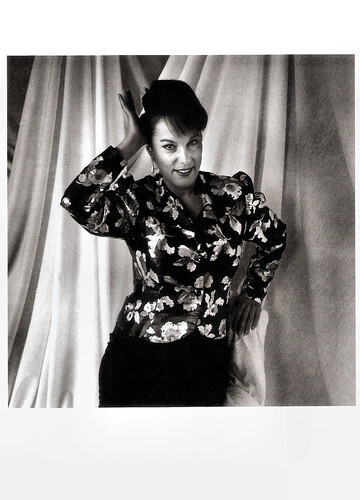
French postcard by Editions Gendre, no. XL 17. Photo: Xavier Lambours. Caption: Bernadette Lafont, Paris, 1984.
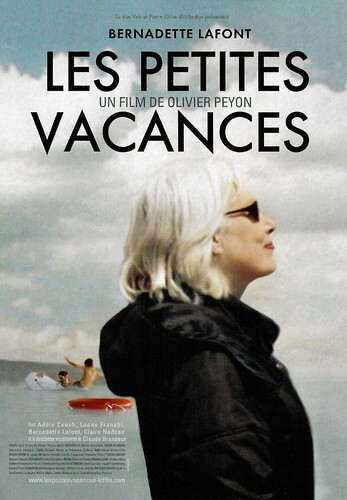
French freecard by Cartcom. Bernadette Lafont in Les petites vacances/Stolen Holidays (Olivier Peyon, 2006).
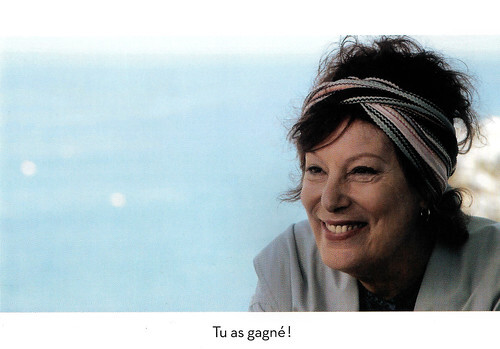
French-Swiss postcard by Light Night Production, Carouge / Alfama Films, Paris. Photo: Frenetic Films / Regio Distr. Bernadette Lafont in Bazar (Patricia Plattner, 2009). Caption: Tu as gagné! (You have won!).
Trailer for La Fiancée du Pirate/A Very Curious Girl (1969). Source: Federico Tlahuizcalpantecuhtli (YouTube).
Bernadette Lafont listens to Edith Piaf 's Les amants de Paris in La maman et la putain/The Mother and the Whore (1973). Source: Nostalgist (YouTube).
Sources: Katherine Knorr (New York Times), Sandra Brennan (AllMovie), France 24, Wikipedia, and .

French postcard by Editions d'Art Yvon, Paris, no. 212. Photo: Sam Lévin.

French postcard by Editions P.I., Paris, no. 1076, offered by Les Carbones Kores 'Carboplane'. Photo: Noa.

Belgian collectors card for Cine Rio à Coxyde. Photo: Unifrance Film.
The right place at the right time
Bernadette Paule Anne Lafont was born in Nîmes in the South of France in 1938. She was the daughter of a pharmacist and his wife. As a teenager, she started her career as a dancer. She entered the Opéra de Nîmes where she fell in love with her future husband, the handsome actor Gérard Blain .
In Paris, she met the young critic and aspiring film director François Truffaut , who offered her a role in his second short film, shot in Nîmes. So she made her screen debut in Les Mistons/The Mischief Makers (Francois Truffaut, 1957) opposite Gérard Blain . It was a comedy about five kids, who spy on two lovers during a hot summer day. It turned out to be that she was in the right place at the right time to catch the Nouvelle Vague movement, the New Wave of filmmakers that would revolutionise the cinema.
She starred particularly in films by Truffaut and by Claude Chabrol. Her first feature and still one of her best-known films is Le Beau Serge/Bitter Reunion (Claude Chabrol, 1958) with Gérard Blain and Jean-Claude Brialy. She had married Blain the year before but they would divorce a year later. Many Nouvelle Vague films followed.
With Chabrol, she also made À double tour/Leda (Claude Chabrol, 1959) starring Madeleine Robinson , Les bonnes femmes/The Good Time Girls (Claude Chabrol, 1960) with Stéphane Audran , and Les godelureaux/Wise Guys (Claude Chabrol, 1961). She appeared in Truffaut’s comedy Tire-au-flanc 62/The Army Game (Claude de Givray, François Truffaut, 1960), and was the feisty heroine of Truffaut’s Une belle fille comme moi/A Gorgeous Bird Like Me (François Truffaut, 1972).
For Louis Malle, she did a supporting part in his comedy Le voleur/The Thief of Paris (Louis Malle, 1967) starring Jean-Paul Belmondo , and for Jacques Rivette, she joined the cast of Out 1, noli me tangere/Out 1 (Jacques Rivette, Suzanne Schiffman, 1971) and Out 1: Spectre (Jacques Rivette, 1974). Finally, she played the role of Marie, one-third of the trio of lovers in La Maman et la Putain/The Mother and the Whore (Jean Eustache, 1973), considered by some critics as the last film of the Nouvelle Vague.

French postcard in the Portrait de Stars by L'Aventure Carto, 2003, no. 12. photo: Marcel Thomas / Collection Gérard Gagnepain.

French postcard by Editions Borde, Paris, no. 124. Photo: Morel.

French postcard by Editions La Malibran, Paris, no. CF 31. Photo: P. Lhomme. Jean-Pierre Léaud , Françoise Lebrun and Bernadette Lafont in La Maman et la Putain (Jean Eustache, 1973).
Always a strong presence
A well-known film with Bernadette Lafont is La Fiancée du Pirate/A Very Curious Girl (Nelly Kaplan, 1969). The success of this film about violence against women renewed her career after a difficult period. She was seen in Les stances à Sophie/Sophie’s Ways (Moshé Mizrahi, 1971), the crime drama Zig Zig (László Szabó, 1975) with Catherine Deneuve , and had a small part as the cellmate of Isabelle Huppert in Violette Nozière (Claude Chabrol, 1978).
In Italy, she appeared in the comedy Il Ladrone/The Thief (Pasquale Festa Campanile, 1980). In a 1997 New York Times article, Katherine Knorr writes: “Lafont has in a tumultuous life done a bit of everything, from television movies to the stage, never quite the megastar but always a strong presence, smart and messed up all at the same time”. In the 1980s she appeared in Chabrol’s crime films Inspecteur Lavardin/Inspector Lavardin (Claude Chabrol, 1986) featuring Jean Poiret, and Masques/Masks (Claude Chabrol, 1987) with Philippe Noiret . She also played in Les saisons du plaisir/The Pleasure Seasons (1988) and other comedies by Jean-Pierre Mocky.
Lafont won the César Award for Best Actress in a Supporting Role for L'Effrontée/Charlotte and Lulu (Claude Miller, 1985) starring Charlotte Gainsbourg . The energetic Lafont created in 1990 an audio-visual workshop to help young actors develop their creativity. She is the co-founder and on the committee that awards the Glace Gervais and an accompanying 100,000 franc prize to works competing in the Cannes Film Festival ‘Un certain Regard’ category. The award was designed to help bolster the budding careers of filmmakers. Her later films include Généalogies d'un crime/Genealogies of a Crime (Raul Ruiz, 1997) with Catherine Deneuve and the comedy Ripoux 3/Part-Time Cops (Claude Zidi, 2003) with Philippe Noiret . In May 2007, she chaired the jury for the fifth edition of the Award for Education presented at the 60th Cannes Film Festival.
After her divorce from Blain in 1959, Bernadette Lafont married the Hungarian sculptor Diourka Medveczky. Although the marriage was difficult and ended in a divorce, there were three children: actress Élisabeth Lafont, David Lafont and the late actress Pauline Lafont, who died in the summer of 1988 under tragic circumstances. She went for a walk near the family property in the Cevennes and never returned. For many weeks, police searched and the popular press went on a feeding frenzy. When Pauline's body was finally found, it became clear she had fallen down in rough, lonely terrain.
Lafont published her autobiography in 1997, an event heralded by a grand star-studded gala in Paris. For her long service to the French motion picture industry, she was given an Honorary César Award in 2003. She was made Officier de la Légion d'honneur (Officer of the Legion of Honour) in 2009. In 2013, Bernadette Lafont died in a hospital in her home town of Nimes.

French postcard by Editions Gendre, no. XL 17. Photo: Xavier Lambours. Caption: Bernadette Lafont, Paris, 1984.

French freecard by Cartcom. Bernadette Lafont in Les petites vacances/Stolen Holidays (Olivier Peyon, 2006).

French-Swiss postcard by Light Night Production, Carouge / Alfama Films, Paris. Photo: Frenetic Films / Regio Distr. Bernadette Lafont in Bazar (Patricia Plattner, 2009). Caption: Tu as gagné! (You have won!).
Trailer for La Fiancée du Pirate/A Very Curious Girl (1969). Source: Federico Tlahuizcalpantecuhtli (YouTube).
Bernadette Lafont listens to Edith Piaf 's Les amants de Paris in La maman et la putain/The Mother and the Whore (1973). Source: Nostalgist (YouTube).
Sources: Katherine Knorr (New York Times), Sandra Brennan (AllMovie), France 24, Wikipedia, and .
Published on August 05, 2023 22:00
August 4, 2023
Photo by Mario von Bucovich
Mario von Bucovich (1884-1947) was described as "one of the great unknown photographers of 20th Century European photography". He worked in Berlin in the 1920s and the early 1930s, where he took over the photo studio of Karl Schenker in 1925. He photographed stage and film personalities of the Weimar Republic, including Marlene Dietrich, Elisabeth Bergner and Leni Riefenstahl. After the rise of the Nazis, he went in exile in New York.
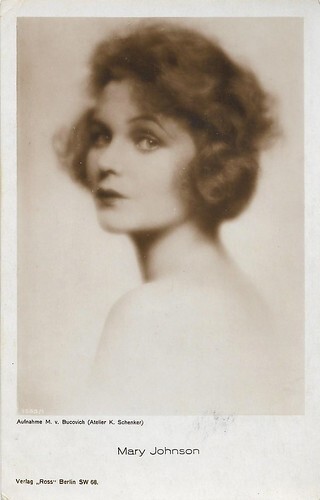
German postcard by Ross Verlag, no. 1653/1, 1927-1928. Photo: Mario von Bucovich (Atelier K. Schenker). Mary Johnson .

German postcard by Ross Verlag, no. 3228/2, 1928-1929. Photo: Mario von Bucovich (Atelier K. Schenker). Elisabeth Bergner in Doña Juana (Paul Czinner, 1928).

German postcard by Ross Verlag, no. 3228/3, 1928-1929. Photo: Mario von Bucovich (Atelier K. Schenker). Elisabeth Bergner in the outfit for Doña Juana/ Donna Juana (Paul Czinner, 1928).
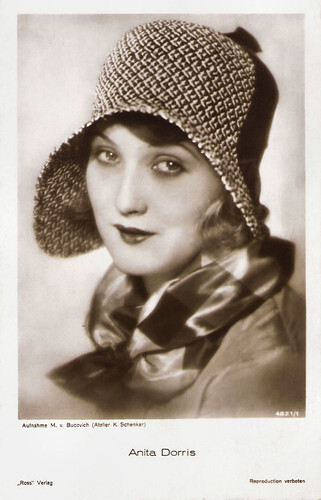
German postcard by Ross Verlag, no. 4821/1, 1929-1930. Photo: Mario von Bucovich (Atelier K. Schenker). Anita Dorris .
Deported to Siberia
Mario von Bucovich or Marius von Bucovich was born in 1884 in Pula in the Istrian region of the Austro-Hungarian Empire. He held the title of Baron. His father, August, Freiherr von Bucovich, was a former Corvette Captain in the Austro-Hungarian navy and later an entrepreneur in the railroad concession sector. His mother was Greek.
Mario began studying mathematics and mechanics at the Eidgenössischen Technischen Hochschule (Swiss Federal Institute of Technology) in Zurich in 1904. He continued these studies in Nancy, France. From 1908 to 1909 he studied electrical engineering and mechanical engineering at the Technikum Mittweida in Saxony. He began his professional career in 1909 at the Otis Elevator Company in New York City, USA, which sent him to the Russian capital St. Petersburg in 1911. There he also dealt with the profitable sale of agricultural machinery.
In 1913, Von Bucovich acceded to his title as Baron upon his father's death. In 1914 he was deported to Siberia as an enemy foreigner but was able to flee and return to St. Petersburg. From 1918 he dedicated himself to the repatriation of the deportees who remained in Siberia, which was very difficult due to the civil war in Russia. The title of Baron and the privileges lapsed with the 1919 Law on the Abolition of the Nobility.
In the 1920s, he worked primarily in Germany but also travelled to France and England. Bucovich was active in the art and antiques trade and settled in Berlin, where he became an authorised signatory in Karl Schenker's photo studio in 1925. The following year, he took over the photo studio. Between 1926 and 1930, von Bucovich and his wife, Marie, who was also a photographer, ran their studio from Budapester Straße 6, in Berlin's Tiergarten district.
In his published work he was most noted for his urban studies with a focus on streetscapes, but his studio work undertaken at the Atelier Karl Schenker was often of entertainment personalities of the Weimar period stage and screen. He photographed Marlene Dietrich , Elisabeth Bergner and Leni Riefenstahl in her days as a dancer, preceding her career as a film director. Von Bucovich also became known as a nude photographer.
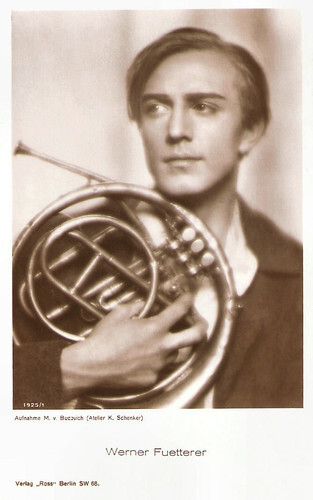
German postcard by Ross Verlag, no. 1925/1, 1927-1928. Photo: M. v. Bucovich / Atelier K. Schenker, Berlin. Werner Fuetterer .
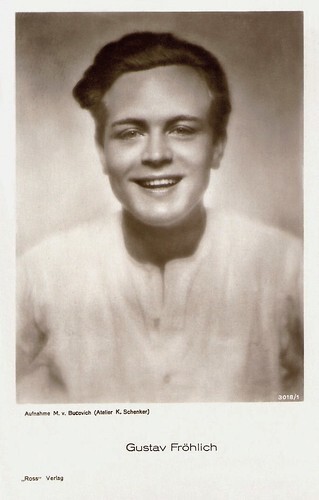
German postcard by Ross Verlag, no. 3018/1, 1928-1929. Photo: M. v. Bucovich (Atelier K. Schenker). Gustav Fröhlich .
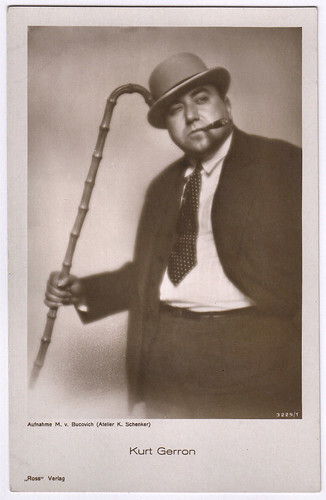
German postcard by Ross Verlag, no. 3229/1, 1928-1929. Photo: M. von Bucovich (Atelier K. Schenker). Collection: Marlene Pilaete. Kurt Gerron.
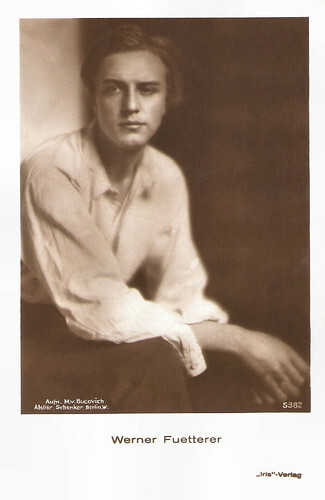
Austrian postcard by Iris Verlag, no. 5382. Photo: M. v. Bucovich / Atelier K. Schenker, Berlin. Werner Fuetterer .
Manhattan Magic
Amongst Mario von Bucovich's most notable books were 'Berlin, Das Gesicht Der Stadt' (Berlin, Portrait of a City) and 'Paris' (with a foreword by Paul Morand). The Paris book included photos by Germaine Krull. The Berlin book published originally by Albertus Verlag, a publishing house he founded in 1928, had a foreword written by the author Alfred Döblin.
During the late 1920s, his photos appeared across the gamut of German photojournalism including the titles: Der Querschnitt, Uhu, Die Dame, Die neue Linie, Das Magazin, Skizzen, Welt-Magazin, Kölnische Illustrierte Zeitung, Revue des Monats, Das Kriminalmagazin, Das Leben, Das Kunstblatt, Farbe und Form, Das Deutsche Lichtbild, Deutscher Kamera Almanach, Die Reklame, and Der Photo-Freund. His views of Girona in Spain taken in 1933 were published in the National Geographic magazine.
In 1931, Von Bucovich moved to New York, via Wiesbaden, London and Paris. In New York, he had a studio at 687 Lexington Avenue and worked for a publishing house on 41st Street. In his American period, he published two photographic essays, 'Washington D.C. City Beautiful' and 'Manhattan Magic: A Collection of Eighty-Five Photographs'. In 1939, he moved to Mexico and was working there through at least the early part of that decade, until his death in 1947 in a traffic accident in Mexico City. He is believed to have been married four times.
His work was shown at major photography salons of the day. He was represented at probably the most important German photography exhibition of the Bauhaus period, 'Fotografie der Gegenwart' (Contemporary photography) in Magdeburg in 1929. He was also shown at the Fourth International Exhibition of Pictorial Photography at the California Palace of the Legion of Honor, the Third International Exhibition of Pictorial Photography Seattle Camera Club, and the 15th and 16th Annual Pittsburgh Salon of Photographic Art at the Carnegie Institute.
His work is in the collections of the New Orleans Museum of Art, the National Museum of Mexican Art and the National Gallery of Canada. The Berliner Morgenpost described him in 2009 as "one of the great unknown photographers of 20th Century European photography".
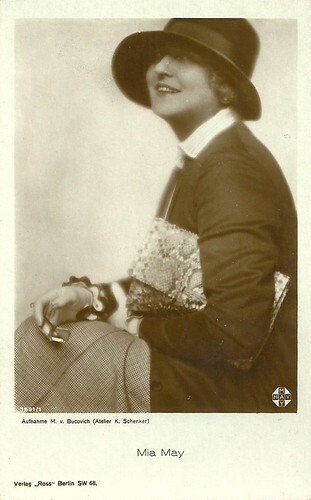
German postcard by Ross Verlag, no. 1551/1, 1927-1928. Photo: M. von Bucovich (Atelier Karl Schenker) / May Film. Mia May .
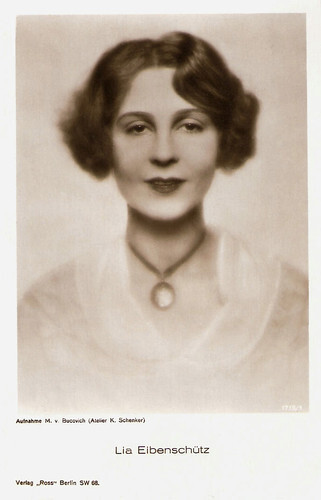
German postcard by Ross Verlag, no. 1715/1, 1927-1928. Photo: M. v. Bucovich (Atelier K. Schenker). Lia Eibenschütz .
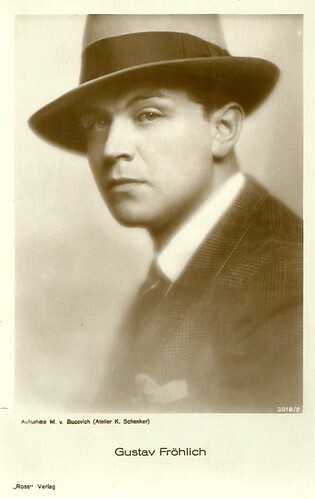
German postcard by Ross Verlag, no. 3018/2, 1928-1929. Photo: M. von Bucovich (Atelier Schenker, Berlin). Gustav Fröhlich .
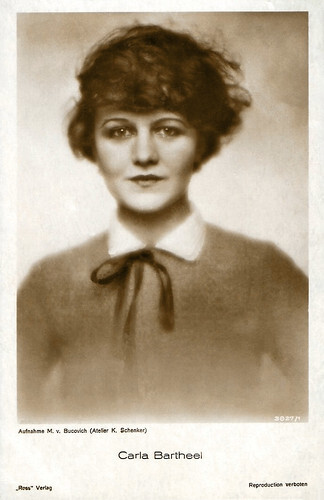
German postcard by Ross Verlag, no. 3827/1, 1928-1929. Photo: M. von Bucovich (Atelier K. Schenker). Carla Bartheel .
Sources: Wikipedia (English and German).

German postcard by Ross Verlag, no. 1653/1, 1927-1928. Photo: Mario von Bucovich (Atelier K. Schenker). Mary Johnson .

German postcard by Ross Verlag, no. 3228/2, 1928-1929. Photo: Mario von Bucovich (Atelier K. Schenker). Elisabeth Bergner in Doña Juana (Paul Czinner, 1928).

German postcard by Ross Verlag, no. 3228/3, 1928-1929. Photo: Mario von Bucovich (Atelier K. Schenker). Elisabeth Bergner in the outfit for Doña Juana/ Donna Juana (Paul Czinner, 1928).

German postcard by Ross Verlag, no. 4821/1, 1929-1930. Photo: Mario von Bucovich (Atelier K. Schenker). Anita Dorris .
Deported to Siberia
Mario von Bucovich or Marius von Bucovich was born in 1884 in Pula in the Istrian region of the Austro-Hungarian Empire. He held the title of Baron. His father, August, Freiherr von Bucovich, was a former Corvette Captain in the Austro-Hungarian navy and later an entrepreneur in the railroad concession sector. His mother was Greek.
Mario began studying mathematics and mechanics at the Eidgenössischen Technischen Hochschule (Swiss Federal Institute of Technology) in Zurich in 1904. He continued these studies in Nancy, France. From 1908 to 1909 he studied electrical engineering and mechanical engineering at the Technikum Mittweida in Saxony. He began his professional career in 1909 at the Otis Elevator Company in New York City, USA, which sent him to the Russian capital St. Petersburg in 1911. There he also dealt with the profitable sale of agricultural machinery.
In 1913, Von Bucovich acceded to his title as Baron upon his father's death. In 1914 he was deported to Siberia as an enemy foreigner but was able to flee and return to St. Petersburg. From 1918 he dedicated himself to the repatriation of the deportees who remained in Siberia, which was very difficult due to the civil war in Russia. The title of Baron and the privileges lapsed with the 1919 Law on the Abolition of the Nobility.
In the 1920s, he worked primarily in Germany but also travelled to France and England. Bucovich was active in the art and antiques trade and settled in Berlin, where he became an authorised signatory in Karl Schenker's photo studio in 1925. The following year, he took over the photo studio. Between 1926 and 1930, von Bucovich and his wife, Marie, who was also a photographer, ran their studio from Budapester Straße 6, in Berlin's Tiergarten district.
In his published work he was most noted for his urban studies with a focus on streetscapes, but his studio work undertaken at the Atelier Karl Schenker was often of entertainment personalities of the Weimar period stage and screen. He photographed Marlene Dietrich , Elisabeth Bergner and Leni Riefenstahl in her days as a dancer, preceding her career as a film director. Von Bucovich also became known as a nude photographer.

German postcard by Ross Verlag, no. 1925/1, 1927-1928. Photo: M. v. Bucovich / Atelier K. Schenker, Berlin. Werner Fuetterer .

German postcard by Ross Verlag, no. 3018/1, 1928-1929. Photo: M. v. Bucovich (Atelier K. Schenker). Gustav Fröhlich .

German postcard by Ross Verlag, no. 3229/1, 1928-1929. Photo: M. von Bucovich (Atelier K. Schenker). Collection: Marlene Pilaete. Kurt Gerron.

Austrian postcard by Iris Verlag, no. 5382. Photo: M. v. Bucovich / Atelier K. Schenker, Berlin. Werner Fuetterer .
Manhattan Magic
Amongst Mario von Bucovich's most notable books were 'Berlin, Das Gesicht Der Stadt' (Berlin, Portrait of a City) and 'Paris' (with a foreword by Paul Morand). The Paris book included photos by Germaine Krull. The Berlin book published originally by Albertus Verlag, a publishing house he founded in 1928, had a foreword written by the author Alfred Döblin.
During the late 1920s, his photos appeared across the gamut of German photojournalism including the titles: Der Querschnitt, Uhu, Die Dame, Die neue Linie, Das Magazin, Skizzen, Welt-Magazin, Kölnische Illustrierte Zeitung, Revue des Monats, Das Kriminalmagazin, Das Leben, Das Kunstblatt, Farbe und Form, Das Deutsche Lichtbild, Deutscher Kamera Almanach, Die Reklame, and Der Photo-Freund. His views of Girona in Spain taken in 1933 were published in the National Geographic magazine.
In 1931, Von Bucovich moved to New York, via Wiesbaden, London and Paris. In New York, he had a studio at 687 Lexington Avenue and worked for a publishing house on 41st Street. In his American period, he published two photographic essays, 'Washington D.C. City Beautiful' and 'Manhattan Magic: A Collection of Eighty-Five Photographs'. In 1939, he moved to Mexico and was working there through at least the early part of that decade, until his death in 1947 in a traffic accident in Mexico City. He is believed to have been married four times.
His work was shown at major photography salons of the day. He was represented at probably the most important German photography exhibition of the Bauhaus period, 'Fotografie der Gegenwart' (Contemporary photography) in Magdeburg in 1929. He was also shown at the Fourth International Exhibition of Pictorial Photography at the California Palace of the Legion of Honor, the Third International Exhibition of Pictorial Photography Seattle Camera Club, and the 15th and 16th Annual Pittsburgh Salon of Photographic Art at the Carnegie Institute.
His work is in the collections of the New Orleans Museum of Art, the National Museum of Mexican Art and the National Gallery of Canada. The Berliner Morgenpost described him in 2009 as "one of the great unknown photographers of 20th Century European photography".

German postcard by Ross Verlag, no. 1551/1, 1927-1928. Photo: M. von Bucovich (Atelier Karl Schenker) / May Film. Mia May .

German postcard by Ross Verlag, no. 1715/1, 1927-1928. Photo: M. v. Bucovich (Atelier K. Schenker). Lia Eibenschütz .

German postcard by Ross Verlag, no. 3018/2, 1928-1929. Photo: M. von Bucovich (Atelier Schenker, Berlin). Gustav Fröhlich .

German postcard by Ross Verlag, no. 3827/1, 1928-1929. Photo: M. von Bucovich (Atelier K. Schenker). Carla Bartheel .
Sources: Wikipedia (English and German).
Published on August 04, 2023 22:00
August 3, 2023
Josef Peterhans
Josef Peterhans (1882-1960) was a German stage and screen actor of the Weimar period. The physically beefy actor with the massive character head and high forehead peaked in German silent cinema of the late 1910s.
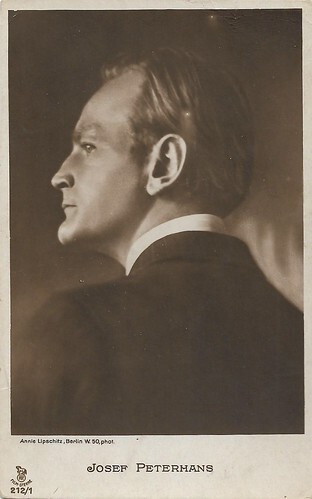
German postcard by Rotophot in the Film-Sterne series, no. 212/1. Photo: Annie Lipschitz, Berlin.
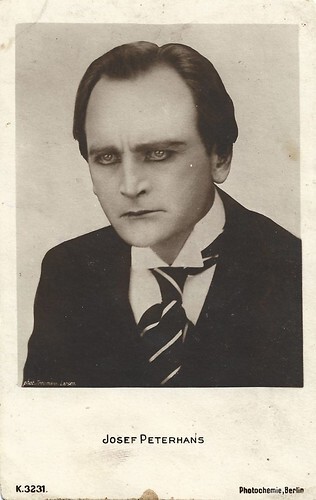
German postcard by Photochemie, Berlin, no. K.3231. Photo: Treumann-Larsen. As far as known, Peterhans did only one film for Treumann-Larsen, Der violette Tod/The Purple Death (Eugen Burg, 1919).
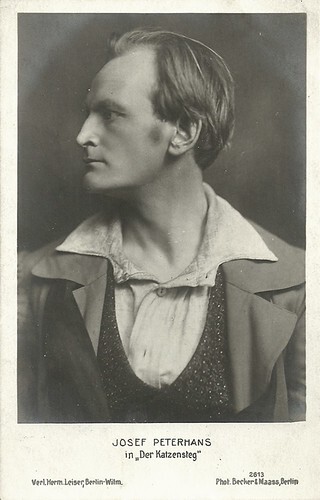
German postcard by Verlag Hermann Leiser, no. 2613. Photo: Becker & Maass, Berlin. Josef Peterhans in the stage play 'Der Katzensteg', based on the eponymous novel (1889) by Hermann Sudermann, which was later transformed into a stage play. The play was also adapted into a film, first in 1915 by Max Mack.
Screen partner of American diva Fern Andra
Josef Thomas Peterhans was born in 1882 in Achern, Germany. He began his acting career at the age of twenty. Peterhans acted for many years with little response in the provinces and in Berlin. After his war service from 1914 to 1917, he got his first film role in Berlin.
In the beginning, Peterhans played leading roles. In 1918, he was the partner of the American screen diva Fern Andra in two films: Frühlingsstürme im Herbste des Lebens/Spring Storms in the Autumn of Life (Fern Andra, 1918) and Um Krone und Peitsche/Crown and Whip (Georg Bluen, Fern Andra, 1918), as well as Andra's film Zwei Menschen/Two People (Fern Andra, 1919).
He also acted opposite Hedda Vernon in ...der Übel größtes aber ist die Schuld.../but the greatest evil is guilt (Hubert Moest, 1918), opposite Ria Jende in Seelenverkäufer/Seller of Souls (Carl Boese, 1919) and Gepeitscht/Whipped (Carl Boese, 1919), opposite Wanda Treumann in Der violette Tod/The purple death (Eugen Burg, 1919), opposite Rita Clermont in Wenn Frauen lieben/When women love (Otto Haerting, 1919), and opposite Helga Molander in Das Lied des Narren/The Song of the Fool (dir. unknown, 1919).
Yet, from 1920 on, he had to be content with supporting parts. While in 1920 he still acted in 9 films, from 1921 onward he would act in only one or two films per year. He acted for instance in Zur Chronik von Grieshuus/Chronicles of the Gray House (Arthur von Gerlach, 1925), in which his son Hanspeter Peterhans had a major part.
Father and son also acted together in Wilhelm Tell (Rudolf Dworsky, Rudolf Walther-Fein, 1923) and Der Wilderer/The Poacher (Johannes Meyer, 1926). Peterhans had a major part as Dary Holm 's husband in the Harry Piel film Rätsel einer Nacht/Night of Mystery (Harry Piel, 1927). He also acted in Piel's Panik/Panic (Harry Piel, 1928).
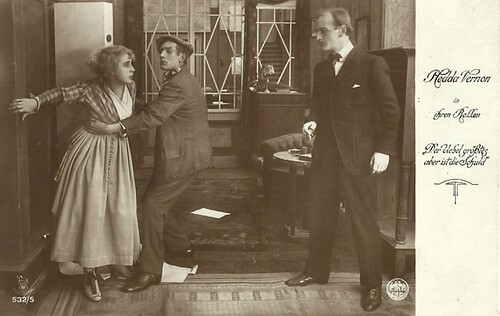
German postcard in the Film Sterne series by Rotophot, no. 532/5. Photo: Eiko Film. Hedda Vernon and Josef Peterhans in Der Übel größtes aber ist die Schuld (Hubert Moest, 1918). The title of the film refers to a line by Cicero, retaken by Friedrich Schiller in the closing lines of his play 'Die Braut von Messina'. Worse than a (self-chosen) death, both claim, is guilt.
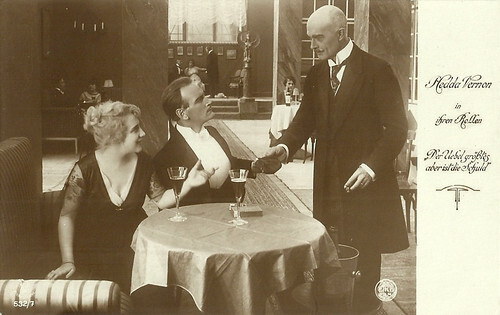
German postcard in the Film Sterne series by Rotophot, no. 532/7. Photo: Eiko Film. Hedda Vernon and Josef Peterhans in Der Übel größtes aber ist die Schuld (Hubert Moest, 1918).
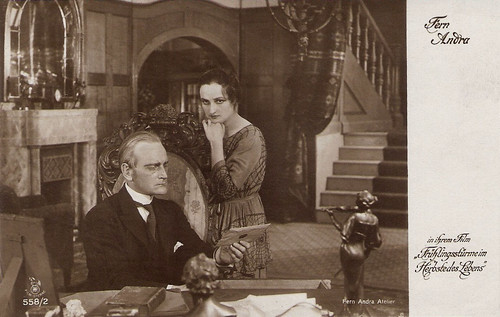
German postcard in the Film Sterne series by Rotophot, no. 558/2. Photo: Fern Andra Atelier. Fern Andra and Josef Peterhans in Frühlingsstürme im Herbste des Lebens/Spring Storms in the Autumn of Life (Fern Andra, 1918).
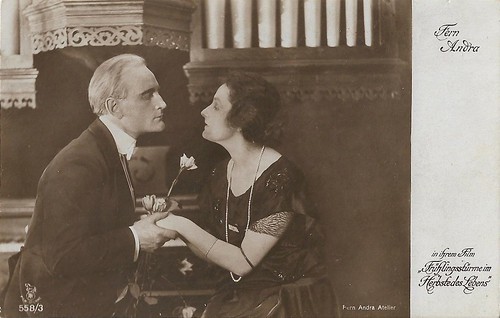
German postcard in the Film Sterne series by Rotophot, no. 558/3. Photo: Fern Andra Atelier. Fern Andra and Josef Peterhans in Frühlingsstürme im Herbste des Lebens/Spring Storms in the Autumn of Life (Fern Andra, 1918).
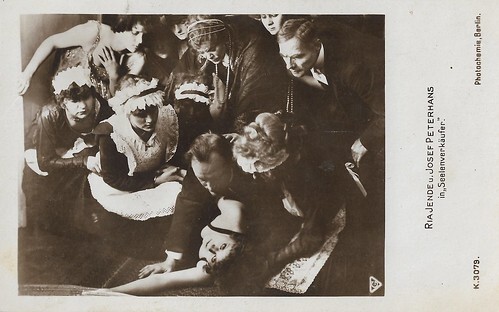
German postcard by Photochemie, Berlin, no. K.3079. Photo: Greenbaum-Film. Josef Peterhans and Ria Jende in Seelenverkäufer/Seller of Souls (Carl Boese, 1919), also with Magnus Stifter. Seelenverkäufer was based on an at the time very popular German novel, 'Seelenverkäufer: Das Schicksal einer Deutsch-Amerikanerin', a fairly autobiographical novel by Margaret[h]e Schuck who under the name of M. Gontard-Schuck published this novel on her life.
Shrinking roles in sound films
In the sound period, Josef Peterhans' roles shrank to batch size. He was a general in the Heinz Rühman comedy Der Stolz der 3. Kompanie/The Pride of Company Three (Fred Sauer, 1932), a forester in Viktoria (Carl Hoffmann, 1935), Marshal Soult in the Napoleon film Hundert Tage/Hundred Days (Franz Wenzler), a priest in Wilhelm Tell/The Legend of William Tell (Heinz Paul, 1934), a member of parliament in Pour le mérite (Karl Ritter, 1938), and a policeman in Frau Luna (Theo Lingen, 1941).
In both of the Prussian stories about Frederick the Great: Fridericus (Johannes Meyer, 1937) and Der große König/The Great King (Veit Harlan, 1942), Peterhans played a general.
After his role in the silent film Indische Rache/Indian Revenge (Georg Jacoby, Léo Lasko, 1920), he played again an Indian in the double feature Der Tiger von Eschnapur/The Tiger of Eshnapur (Richard Eichberg, 1938) and Das indische Grabmal/The Indian Tomb (Richard Eichberg, 1938), starring Frits van Dongen/Philip Dorn and La Jana .
The theatre also hardly needed the actor in later years. Josef Peterhans was last seen on stage in Zurich between 1928 and 1930. To earn a living Peterhans often worked as a dubbing artist from the early 1930s. Peterhans retired from the film business before he was 60 years old and he didn't get a permanent engagement from the theatre for years.
Peterhans was on the 'Gottbegnadeten' list of the Reich Ministry for Popular Enlightenment and Propaganda in 1944. He spent his retirement in Berlin-Steglitz. His wife, to whom he had been married since 1913, died in February 1945 during an air raid on Berlin. Josef Peterhans died in 1960 in Berlin-Steglitz. His written estate is in the archive of the Akademie der Künste in Berlin.
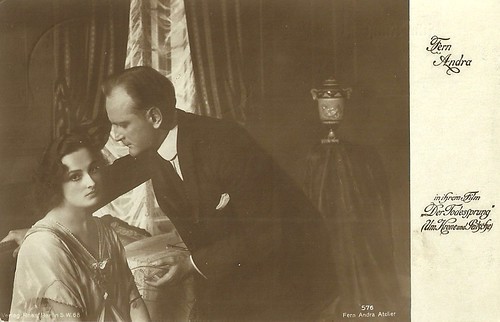
German postcard by Ross Verlag, no. 576. Photo: Fern-Andra-Atelier. Fern Andra and Josef Peterhans in Der Todessprung/Um Krone und Peitsche/Crown and Whip (Georg Bluen, Fern Andra, 1918).
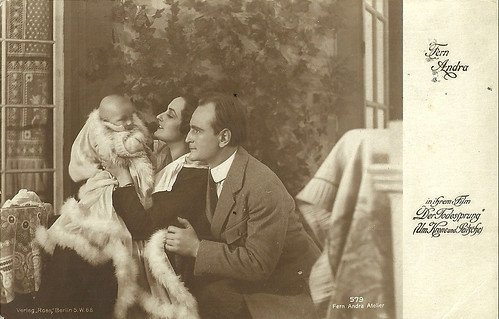
German postcard by Ross Verlag, no. 580. Photo: Fern-Andra-Atelier. Fern Andra and Josef Peterhans in Der Todessprung/Um Krone und Peitsche/Crown and Whip (Georg Bluen, Fern Andra, 1918).
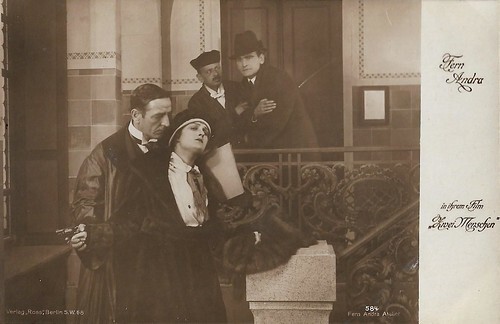
German postcard by Verlag Ross, Berlin, no. 584, 1919-1924. Photo: Fern Andra Atelier. Fern Andra and Josef Peterhans in the German silent drama Zwei Menschen (Fern Andra, 1919).
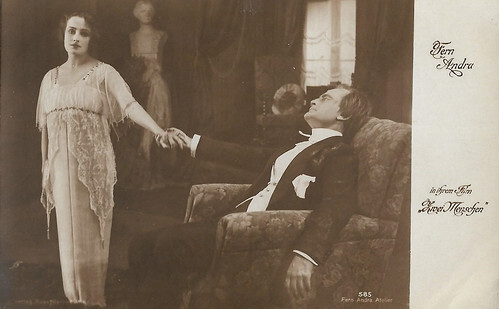
German postcard by Verlag Ross, Berlin, no. 585, 1919-1924. Photo: Fern Andra Atelier. Fern Andra and Josef Peterhans in the German silent drama Zwei Menschen (Fern Andra, 1919).
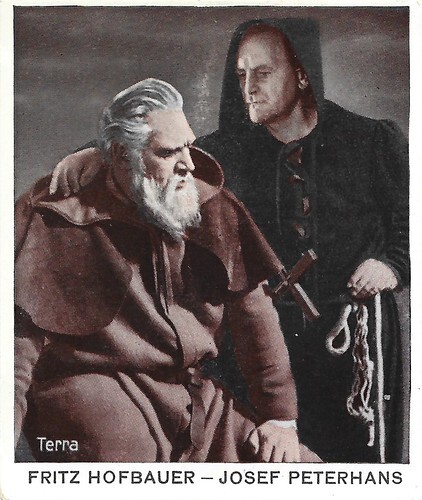
German cigarette card by Ross Verlag in the Haus Bergmann Farb-Filmbilder series, no. 199. Photo: Terra Film. Fritz Hofbauer as Walter Fürst and Josef Peterhans as Pfarrer Rösselmann in Wilhelm Tell/The Legend of William Tell (Heinz Paul, 1934).
Sources: Wikipedia (German and English) and .

German postcard by Rotophot in the Film-Sterne series, no. 212/1. Photo: Annie Lipschitz, Berlin.

German postcard by Photochemie, Berlin, no. K.3231. Photo: Treumann-Larsen. As far as known, Peterhans did only one film for Treumann-Larsen, Der violette Tod/The Purple Death (Eugen Burg, 1919).

German postcard by Verlag Hermann Leiser, no. 2613. Photo: Becker & Maass, Berlin. Josef Peterhans in the stage play 'Der Katzensteg', based on the eponymous novel (1889) by Hermann Sudermann, which was later transformed into a stage play. The play was also adapted into a film, first in 1915 by Max Mack.
Screen partner of American diva Fern Andra
Josef Thomas Peterhans was born in 1882 in Achern, Germany. He began his acting career at the age of twenty. Peterhans acted for many years with little response in the provinces and in Berlin. After his war service from 1914 to 1917, he got his first film role in Berlin.
In the beginning, Peterhans played leading roles. In 1918, he was the partner of the American screen diva Fern Andra in two films: Frühlingsstürme im Herbste des Lebens/Spring Storms in the Autumn of Life (Fern Andra, 1918) and Um Krone und Peitsche/Crown and Whip (Georg Bluen, Fern Andra, 1918), as well as Andra's film Zwei Menschen/Two People (Fern Andra, 1919).
He also acted opposite Hedda Vernon in ...der Übel größtes aber ist die Schuld.../but the greatest evil is guilt (Hubert Moest, 1918), opposite Ria Jende in Seelenverkäufer/Seller of Souls (Carl Boese, 1919) and Gepeitscht/Whipped (Carl Boese, 1919), opposite Wanda Treumann in Der violette Tod/The purple death (Eugen Burg, 1919), opposite Rita Clermont in Wenn Frauen lieben/When women love (Otto Haerting, 1919), and opposite Helga Molander in Das Lied des Narren/The Song of the Fool (dir. unknown, 1919).
Yet, from 1920 on, he had to be content with supporting parts. While in 1920 he still acted in 9 films, from 1921 onward he would act in only one or two films per year. He acted for instance in Zur Chronik von Grieshuus/Chronicles of the Gray House (Arthur von Gerlach, 1925), in which his son Hanspeter Peterhans had a major part.
Father and son also acted together in Wilhelm Tell (Rudolf Dworsky, Rudolf Walther-Fein, 1923) and Der Wilderer/The Poacher (Johannes Meyer, 1926). Peterhans had a major part as Dary Holm 's husband in the Harry Piel film Rätsel einer Nacht/Night of Mystery (Harry Piel, 1927). He also acted in Piel's Panik/Panic (Harry Piel, 1928).

German postcard in the Film Sterne series by Rotophot, no. 532/5. Photo: Eiko Film. Hedda Vernon and Josef Peterhans in Der Übel größtes aber ist die Schuld (Hubert Moest, 1918). The title of the film refers to a line by Cicero, retaken by Friedrich Schiller in the closing lines of his play 'Die Braut von Messina'. Worse than a (self-chosen) death, both claim, is guilt.

German postcard in the Film Sterne series by Rotophot, no. 532/7. Photo: Eiko Film. Hedda Vernon and Josef Peterhans in Der Übel größtes aber ist die Schuld (Hubert Moest, 1918).

German postcard in the Film Sterne series by Rotophot, no. 558/2. Photo: Fern Andra Atelier. Fern Andra and Josef Peterhans in Frühlingsstürme im Herbste des Lebens/Spring Storms in the Autumn of Life (Fern Andra, 1918).

German postcard in the Film Sterne series by Rotophot, no. 558/3. Photo: Fern Andra Atelier. Fern Andra and Josef Peterhans in Frühlingsstürme im Herbste des Lebens/Spring Storms in the Autumn of Life (Fern Andra, 1918).

German postcard by Photochemie, Berlin, no. K.3079. Photo: Greenbaum-Film. Josef Peterhans and Ria Jende in Seelenverkäufer/Seller of Souls (Carl Boese, 1919), also with Magnus Stifter. Seelenverkäufer was based on an at the time very popular German novel, 'Seelenverkäufer: Das Schicksal einer Deutsch-Amerikanerin', a fairly autobiographical novel by Margaret[h]e Schuck who under the name of M. Gontard-Schuck published this novel on her life.
Shrinking roles in sound films
In the sound period, Josef Peterhans' roles shrank to batch size. He was a general in the Heinz Rühman comedy Der Stolz der 3. Kompanie/The Pride of Company Three (Fred Sauer, 1932), a forester in Viktoria (Carl Hoffmann, 1935), Marshal Soult in the Napoleon film Hundert Tage/Hundred Days (Franz Wenzler), a priest in Wilhelm Tell/The Legend of William Tell (Heinz Paul, 1934), a member of parliament in Pour le mérite (Karl Ritter, 1938), and a policeman in Frau Luna (Theo Lingen, 1941).
In both of the Prussian stories about Frederick the Great: Fridericus (Johannes Meyer, 1937) and Der große König/The Great King (Veit Harlan, 1942), Peterhans played a general.
After his role in the silent film Indische Rache/Indian Revenge (Georg Jacoby, Léo Lasko, 1920), he played again an Indian in the double feature Der Tiger von Eschnapur/The Tiger of Eshnapur (Richard Eichberg, 1938) and Das indische Grabmal/The Indian Tomb (Richard Eichberg, 1938), starring Frits van Dongen/Philip Dorn and La Jana .
The theatre also hardly needed the actor in later years. Josef Peterhans was last seen on stage in Zurich between 1928 and 1930. To earn a living Peterhans often worked as a dubbing artist from the early 1930s. Peterhans retired from the film business before he was 60 years old and he didn't get a permanent engagement from the theatre for years.
Peterhans was on the 'Gottbegnadeten' list of the Reich Ministry for Popular Enlightenment and Propaganda in 1944. He spent his retirement in Berlin-Steglitz. His wife, to whom he had been married since 1913, died in February 1945 during an air raid on Berlin. Josef Peterhans died in 1960 in Berlin-Steglitz. His written estate is in the archive of the Akademie der Künste in Berlin.

German postcard by Ross Verlag, no. 576. Photo: Fern-Andra-Atelier. Fern Andra and Josef Peterhans in Der Todessprung/Um Krone und Peitsche/Crown and Whip (Georg Bluen, Fern Andra, 1918).

German postcard by Ross Verlag, no. 580. Photo: Fern-Andra-Atelier. Fern Andra and Josef Peterhans in Der Todessprung/Um Krone und Peitsche/Crown and Whip (Georg Bluen, Fern Andra, 1918).

German postcard by Verlag Ross, Berlin, no. 584, 1919-1924. Photo: Fern Andra Atelier. Fern Andra and Josef Peterhans in the German silent drama Zwei Menschen (Fern Andra, 1919).

German postcard by Verlag Ross, Berlin, no. 585, 1919-1924. Photo: Fern Andra Atelier. Fern Andra and Josef Peterhans in the German silent drama Zwei Menschen (Fern Andra, 1919).

German cigarette card by Ross Verlag in the Haus Bergmann Farb-Filmbilder series, no. 199. Photo: Terra Film. Fritz Hofbauer as Walter Fürst and Josef Peterhans as Pfarrer Rösselmann in Wilhelm Tell/The Legend of William Tell (Heinz Paul, 1934).
Sources: Wikipedia (German and English) and .
Published on August 03, 2023 22:00
August 2, 2023
Paul Anka
Paul Anka (1941) is a Canadian singer, songwriter, and actor. Anka became famous in the late 1950s, 1960s, and 1970s with hit songs like 'Diana' (1957), 'Lonely Boy' (1959), 'Put Your Head on My Shoulder' (1959), and '(You're) Having My Baby' (1974). He wrote the theme for The Tonight Show Starring Johnny Carson and the English lyrics for Frank Sinatra's signature song, 'My Way' (1969). He also appeared in such films as The Longest Day (1962).
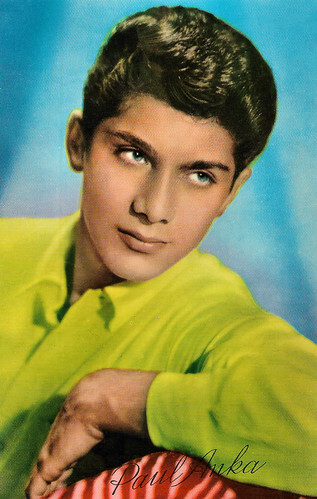
Vintage postcard.
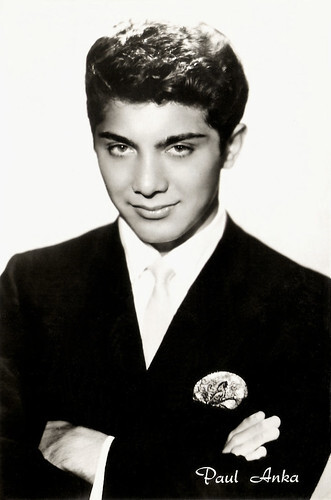
Dutch postcard by Internationale Filmpers (I.F.P.), Amsterdam, no. WPS 117.
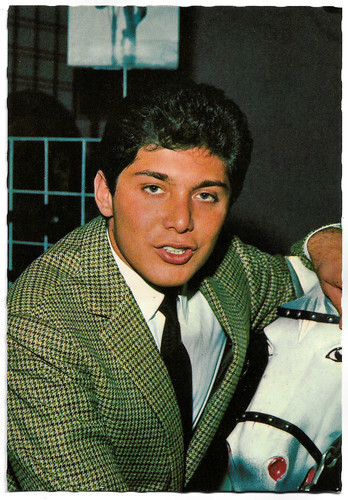
West-German postcard by Filmbilder-Vertrieb Ernst Freihoff, Essen, no. H 112.
Puppy love
Paul Albert Anka was born in Ottawa, Ontario, in 1941. His parents, Camelia and Andy Anka owned a restaurant called the Locanda, that was popular with local entertainers. He taught himself to play guitar and piano as a teen and formed a vocal group called the Bobbysoxers with friends that performed locally in Ottawa.
Paul Anka recorded his first single, 'I Confess' when he was 14. In 1957 he went to New York City where he auditioned for producer Don Costa at ABC. He sang the original song 'Diana' (1957), which he wrote when he was 15 for his first love, Diana Ayoub, the 18-year-old babysitter of his younger brother and sister. He was quickly offered a recording contract, and 'Diana' rocketed to #1 on the Canadian and U.S. music charts. With sales of more than 20 million copies, 'Diana' is one of the best-selling singles ever by a Canadian recording artist.
He followed up with four songs that made it into the Top 20 in 1958, including 'It's Time to Cry', which hit #4. Only 17, he was one of the biggest teen idols of the time. He toured Britain, then Australia with Buddy Holly. Anka wrote for him 'It Doesn't Matter Anymore', which Holly recorded just before he died in 1959. Anka's next hit 'Puppy Love' (1960) was inspired by his girlfriend Annette Funicello.
Paul Anka hit the Italian market with 'Summer's Gone' in 1960. It was released as 'Dove Sei'. The record got immediate success, reaching #4 on Italian hit lists. His top hit was 'Ogni Giorno' which scored #1 in 1962, followed by 'Piangerò per te' and 'Ogni Volta', which reached both #2, in 1963 and 1964.
'Ogni volta' (Every Time) was sung by Anka during the Festival di Sanremo of 1964 and then sold more than one million copies in Italy alone. Anka's talent also included the theme for The Tonight Show Starring Johnny Carson, which was reworked in 1962 from a song Anka wrote earlier.
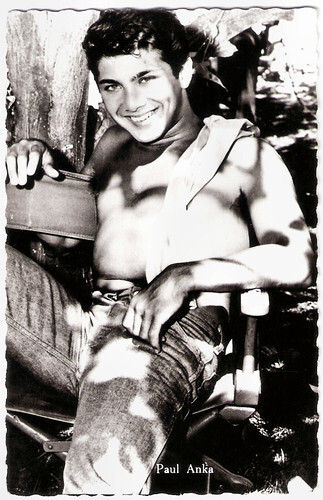
Dutch postcard, no. 162.
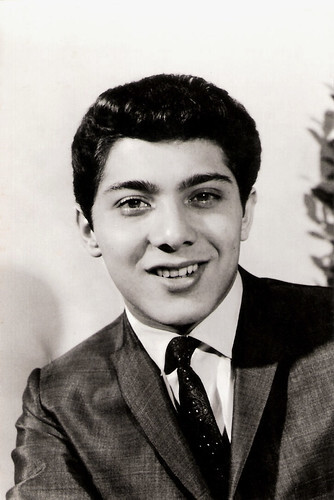
Vintage postcard.
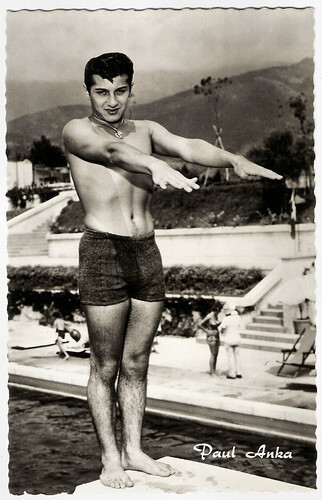
Dutch postcard by Int. Filmpers, Amsterdam (I.F.P.), no. 3350. Caption: Read Song Parade.
The Longest Day
Like most North American recording artists, Paul Anka saw his career stalled by the British Invasion. By the late 1960s, his career focused on adult contemporary and big-band standards, played regularly in Las Vegas. He composed Tom Jones ' biggest hit record, 'She's a Lady' (1971) and wrote the English lyrics to Frank Sinatra 's signature song 'My Way' (1969). It was originally the French song 'Comme d'habitude'. 'My Way' has been covered by many artists including Elvis Presley .
Anka began acting in motion pictures as well as writing songs for them, most notably the theme for the hit film The Longest Day (Ken Annakin, Andrew Marton, Bernhard Wicki, 1962). According to IMDb , "he was quite believable as a nervous hyper young soldier". For his film work, he wrote and recorded also one of his greatest hits, 'Lonely Boy' (1959) which he wrote for his mother, who died of diabetes. During the late 1950s and early 1960s, he starred in such teen exploitation films as Girls Town (Charles F. Haas, 1959) starring Mamie Van Doren and Look in Any Window (William Alland, 1961), in which he played a peeping tom.
Paul Anka later played a yacht broker in Captain Ron (Thom Eberhardt, 1992) starring Kurt Russell and Martin Short and an Elvis-hating casino pit manager in 3000 Miles to Graceland (Demian Lichtenstein, 2001) starring Kurt Russell and Kevin Costner . He also made several appearances on the TV series Las Vegas (2003-2008) with James Caan.
After more than ten years without a top 25 hit record, Paul Anka teamed up in 1974 with Odia Coates to record the #1 hit, '(You're) Having My Baby'. The two would record two more duets that made it into the Top 10, 'One Man Woman/One Woman Man' (#7) and 'I Don't Like to Sleep Alone' (#8). In 1983, he co-wrote the song 'I Never Heard' with Michael Jackson . It was retitled and released in 2009 under the name 'This Is It'. An additional song that Jackson co-wrote with Anka from this 1983 session, 'Love Never Felt So Good', was since discovered and was released on Jackson's posthumous album 'Xscape' in 2014. The song was also released by Johnny Mathis in 1984. To date, Paul has recorded 125 albums -including songs in Japanese, German, Spanish, French, and Italian - and sold more than 15 million worldwide.
Paul Anka became a naturalised US citizen in 1990. Anka was married to Anne de Zogheb, the daughter of a Lebanese diplomat, Charles de Zogheb, from 1963, until 2001. They have five daughters. In 2008, Anka married his personal trainer, Anna Åberg, in Sardinia. They divorced in 2010 and share custody of their son, Ethan. An autobiography, 'My Way' (co-written with David Dalton), was published in 2013. In October 2016, Anka married Lisa Pemberton in Beverly Hills, California. They divorced in 2020. Anka is the father-in-law of actor/director Jason Bateman, who married Paul's daughter, Amanda Anka in 2001.
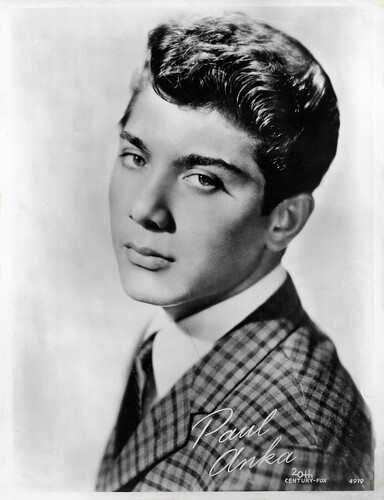
Big Dutch card, no. 4919. Photo: 20th Century Fox.
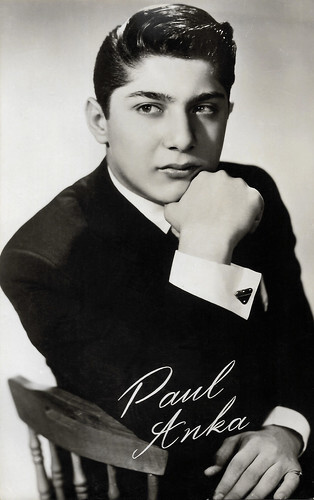
Dutch postcard by Takken, Utrecht, no. AX 3838. Caption: Read Jukebox monthly.
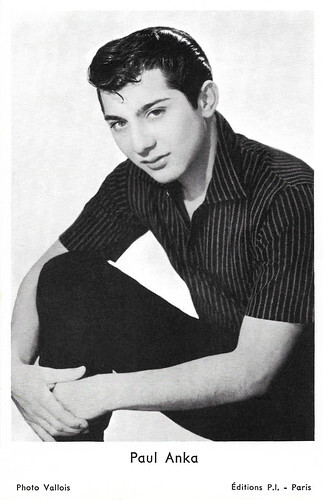
French postcard by Editions P.I., Paris. Photo: Vallois.
Source: Paul Onkenhout and John Schoorl (De Volkskrant -Dutch), Encyclopaedia Britannica, Wikipedia and .

Vintage postcard.

Dutch postcard by Internationale Filmpers (I.F.P.), Amsterdam, no. WPS 117.

West-German postcard by Filmbilder-Vertrieb Ernst Freihoff, Essen, no. H 112.
Puppy love
Paul Albert Anka was born in Ottawa, Ontario, in 1941. His parents, Camelia and Andy Anka owned a restaurant called the Locanda, that was popular with local entertainers. He taught himself to play guitar and piano as a teen and formed a vocal group called the Bobbysoxers with friends that performed locally in Ottawa.
Paul Anka recorded his first single, 'I Confess' when he was 14. In 1957 he went to New York City where he auditioned for producer Don Costa at ABC. He sang the original song 'Diana' (1957), which he wrote when he was 15 for his first love, Diana Ayoub, the 18-year-old babysitter of his younger brother and sister. He was quickly offered a recording contract, and 'Diana' rocketed to #1 on the Canadian and U.S. music charts. With sales of more than 20 million copies, 'Diana' is one of the best-selling singles ever by a Canadian recording artist.
He followed up with four songs that made it into the Top 20 in 1958, including 'It's Time to Cry', which hit #4. Only 17, he was one of the biggest teen idols of the time. He toured Britain, then Australia with Buddy Holly. Anka wrote for him 'It Doesn't Matter Anymore', which Holly recorded just before he died in 1959. Anka's next hit 'Puppy Love' (1960) was inspired by his girlfriend Annette Funicello.
Paul Anka hit the Italian market with 'Summer's Gone' in 1960. It was released as 'Dove Sei'. The record got immediate success, reaching #4 on Italian hit lists. His top hit was 'Ogni Giorno' which scored #1 in 1962, followed by 'Piangerò per te' and 'Ogni Volta', which reached both #2, in 1963 and 1964.
'Ogni volta' (Every Time) was sung by Anka during the Festival di Sanremo of 1964 and then sold more than one million copies in Italy alone. Anka's talent also included the theme for The Tonight Show Starring Johnny Carson, which was reworked in 1962 from a song Anka wrote earlier.

Dutch postcard, no. 162.

Vintage postcard.

Dutch postcard by Int. Filmpers, Amsterdam (I.F.P.), no. 3350. Caption: Read Song Parade.
The Longest Day
Like most North American recording artists, Paul Anka saw his career stalled by the British Invasion. By the late 1960s, his career focused on adult contemporary and big-band standards, played regularly in Las Vegas. He composed Tom Jones ' biggest hit record, 'She's a Lady' (1971) and wrote the English lyrics to Frank Sinatra 's signature song 'My Way' (1969). It was originally the French song 'Comme d'habitude'. 'My Way' has been covered by many artists including Elvis Presley .
Anka began acting in motion pictures as well as writing songs for them, most notably the theme for the hit film The Longest Day (Ken Annakin, Andrew Marton, Bernhard Wicki, 1962). According to IMDb , "he was quite believable as a nervous hyper young soldier". For his film work, he wrote and recorded also one of his greatest hits, 'Lonely Boy' (1959) which he wrote for his mother, who died of diabetes. During the late 1950s and early 1960s, he starred in such teen exploitation films as Girls Town (Charles F. Haas, 1959) starring Mamie Van Doren and Look in Any Window (William Alland, 1961), in which he played a peeping tom.
Paul Anka later played a yacht broker in Captain Ron (Thom Eberhardt, 1992) starring Kurt Russell and Martin Short and an Elvis-hating casino pit manager in 3000 Miles to Graceland (Demian Lichtenstein, 2001) starring Kurt Russell and Kevin Costner . He also made several appearances on the TV series Las Vegas (2003-2008) with James Caan.
After more than ten years without a top 25 hit record, Paul Anka teamed up in 1974 with Odia Coates to record the #1 hit, '(You're) Having My Baby'. The two would record two more duets that made it into the Top 10, 'One Man Woman/One Woman Man' (#7) and 'I Don't Like to Sleep Alone' (#8). In 1983, he co-wrote the song 'I Never Heard' with Michael Jackson . It was retitled and released in 2009 under the name 'This Is It'. An additional song that Jackson co-wrote with Anka from this 1983 session, 'Love Never Felt So Good', was since discovered and was released on Jackson's posthumous album 'Xscape' in 2014. The song was also released by Johnny Mathis in 1984. To date, Paul has recorded 125 albums -including songs in Japanese, German, Spanish, French, and Italian - and sold more than 15 million worldwide.
Paul Anka became a naturalised US citizen in 1990. Anka was married to Anne de Zogheb, the daughter of a Lebanese diplomat, Charles de Zogheb, from 1963, until 2001. They have five daughters. In 2008, Anka married his personal trainer, Anna Åberg, in Sardinia. They divorced in 2010 and share custody of their son, Ethan. An autobiography, 'My Way' (co-written with David Dalton), was published in 2013. In October 2016, Anka married Lisa Pemberton in Beverly Hills, California. They divorced in 2020. Anka is the father-in-law of actor/director Jason Bateman, who married Paul's daughter, Amanda Anka in 2001.

Big Dutch card, no. 4919. Photo: 20th Century Fox.

Dutch postcard by Takken, Utrecht, no. AX 3838. Caption: Read Jukebox monthly.

French postcard by Editions P.I., Paris. Photo: Vallois.
Source: Paul Onkenhout and John Schoorl (De Volkskrant -Dutch), Encyclopaedia Britannica, Wikipedia and .
Published on August 02, 2023 22:00
August 1, 2023
Der weiße Dämon (1932)
Hans Albers, a superstar of German cinema between 1930 and 1945 played the leading role in the Ufa production Der weiße Dämon/Dope (Kurt Gerron, 1932). The supporting cast is also interesting: Fritz Lang's muse Gerda Maurus as Albers' sister, a rising young female singer who gets addicted to drugs, and Alfred Abel, Hubert von Meyerinck and Peter Lorre as three drugs smugglers. Lorre is the demonic villain, a hunchback.
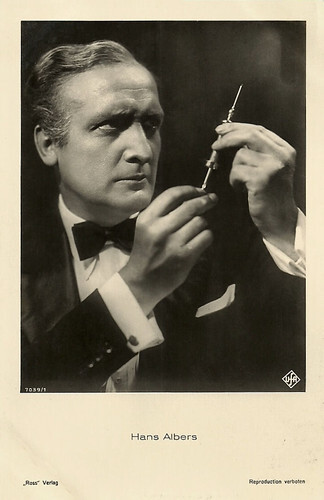
German postcard by Ross Verlag, no. 7039/1, 1932-1933. Photo: Ufa. Hans Albers in Der weiße Dämon/Dope (Kurt Gerron, 1932).
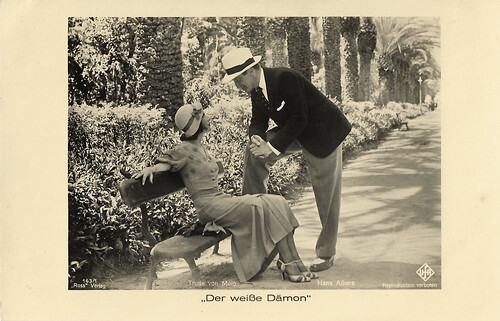
German Postcard by Ross Verlag, no. 163/1, 1932-1933. Photo: Ufa. Hans Albers and Trude von Molo in Der weiße Dämon/Dope (Kurt Gerron, 1932).
A drug called the White Demon
The script of Der weiße Dämon/Dope (Kurt Gerron, 1932) was written by Philipp Lothar Mayring and Fritz Zeckendorf. Alfred Abel plays Consul Gorre, the head of an international gang of drug smugglers that also includes the morphine-addicted theatre director Urussev (Raoul Aslan), the Marquis d'Esquillon (Hubert von Meyerinck), section chief of the gang in Paris, and a man known only as "the Hunchback" ( Peter Lorre ) who is responsible for importing the narcotics from overseas.
The gang of criminals travels under the guise of an internationally performing touring theatre troupe, joined as a leading lady by the young artist Gerda Gildemeister ( Gerda Maurus ). Gerda's brother is the "Hamburg boy" Heini Gildemeister ( Hans Albers ) who, after years of absence spent in South America, finally returns to his hometown by ship. On this journey home, he rescues Gorre's son after he had fallen overboard.
Back home, Heini makes a terrible discovery: Sister Gerda is only a wreck, very weak and ailing in body, mind and soul. Years of morphine abuse have taken their toll on her. She has become completely dependent and can hardly get back on her feet without this drug, also called the "white demon". Heini discovers a corresponding syringe in the pocket of Dora (Trude von Molo), a friend of Gerda's, and receives confirmation from the theatre doctor that his sister has become a dependent morphine addict through years of drug use. Heini immediately takes her to the nearest hospital. But since Gerda is supposed to travel to Paris the next day as part of a tour, the gang members are immediately on the scene and get her out of the hospital. They force Gerda to call her brother and summon him to a meeting in a pub that has a reputation as a drug bar.
When Heini appears there, the gang tries to overpower the "troublemaker", but he manages to free himself and now takes up the pursuit of the gang on his own, as the police who were informed earlier is of no real help. Heini is determined to prevent Gerda from staying in the custody of the unscrupulous dealers even one day longer. But Heini fails in this because Gerda goes to the French capital for a singing performance with the theatre troupe, where she is held in the Marquis' house. The Marquis explains to Heini that Gerda (delirious with fever, as it turns out) has forged a bill of exchange - in the hope that Heini will finally give in so as not to let his sister go to prison.
Consul Gorre, who has been in Heini's debt ever since his son was rescued on the overseas steamer, helps him to free Gerda so that Heini can immediately take her to a sanatorium. But Heini still does not know who the ostensible ally really is. Gildemeister does not let up and follows the gang of criminals. In Lisbon, he manages to get "the hunchback" arrested, while Urusev, who betrayed his buddies, is shot. On the flight home with Dora and Gorre, Heini now also exposes the ominous consul as the head of the gang. With suicidal intent, he then throws himself into the Atlantic. Heini and Gerda's artist colleague Dora, with whom he has become friends in the meantime, return to Hamburg as friends for life.
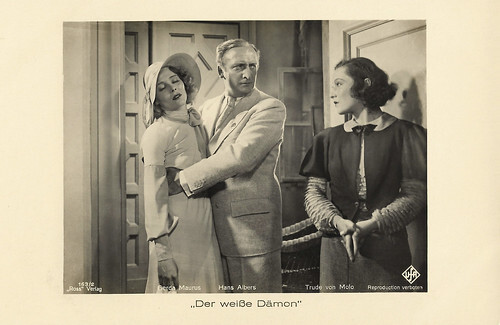
German Postcard by Ross Verlag, no. 163/2, 1932-1933. Photo: Ufa. Hans Albers , Trude von Molo and Gerda Maurus in Der weiße Dämon/Dope (Kurt Gerron, 1932).
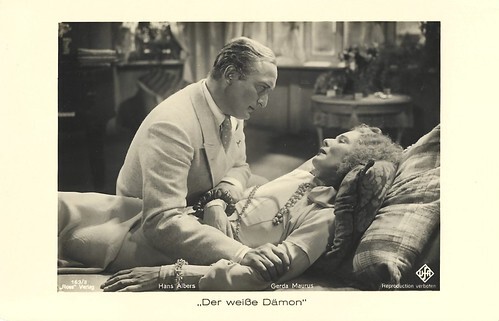
German postcard by Ross Verlag, no. 613/3, 1932-1933. Photo: Ufa. Hans Albers and Gerda Maurus in Der weiße Dämon/Dope (Kurt Gerron, 1932).
Dope
Der weiße Dämon/Dope (Kurt Gerron, 1932) was shot from 20 June until August 1932 in Portugal and Spain as well as on the Hapag steamer Emil Kirdorf, in Cuxhaven harbour and on the MS General Osorio (the exterior shots). The premiere took place on 19 November 1932 in Berlin's Ufa-Palast am Zoo.
The film was originally supposed to be called Rauschgift (Dope), but this title caused considerable problems with the German film censors, who feared that the film would advertise drugs. According to a decision of 10 November 1932, corresponding scenes had to be deleted. In Austria, however, the film title Rauschgift was approved.
Julius von Borsody designed the film sets, Günther Anders assisted chief cameraman Carl Hoffmann. Hermann Hoffmann designed the costumes, Erich Holder assisted director Kurt Gerron. Walter Rühland provided the sound. In the cast was the former star of the early silent film, Eva Speyer . She played her last film role here, a very small role. Karl John in turn made his film debut here.
Simultaneously with the original German production, the Ufa made a French version with Jean Murat in the role of Hans Albers under the title Stupéfiants/Narcotics (Kurt Gerron, Roger Le Bon, 1932). In the cast were also Danièle Parola , Jean Worms, Jean Mercanton and Monique Rolland . Raoul Aslan and Peter Lorre repeated their roles from the German version. In contrast to Lorre, director Kurt Gerron, one of the greats of Weimar cinema, theatre and vaudeville, could not escape the Nazis. Gerron was murdered in Auschwitz in 1943.
Trade journal Der Film wrote: "The director Kurt Gerron ... lets the events take their fabulous course and fabulates happily along, out of actor's whim. (...) He uses his only trump cards and knows how to exploit them the fiercely extemporising Albers, who lives it up, ... the excellent Lorre, who plays with gripping demeanour, ... the this time surprisingly good Gerda Maurus ...". However, future Minister of Propaganda Joseph Goebbels wrote in his diary entry of 21 November 1932: "Albers a fabulous boy. Otherwise a piece of rubbish."
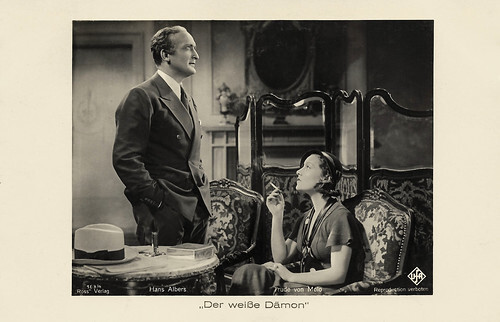
German Postcard by Ross Verlag, no. 163/4, 1932-1933. Photo: Ufa. Hans Albers and Trude von Molo in Der weiße Dämon/Dope (Kurt Gerron, 1932).
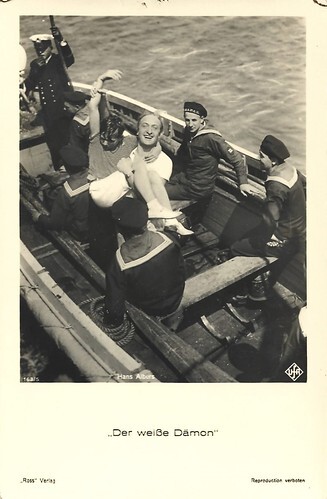
German postcard by Ross Verlag, no. 163/5, 1932-1933. Photo: Ufa. Hans Albers in Der weiße Dämon/Dope (Kurt Gerron, 1932).
Sources: Zeughauskino (German), Filmportal.de, Wikipedia (German and English) and IMDb.

German postcard by Ross Verlag, no. 7039/1, 1932-1933. Photo: Ufa. Hans Albers in Der weiße Dämon/Dope (Kurt Gerron, 1932).

German Postcard by Ross Verlag, no. 163/1, 1932-1933. Photo: Ufa. Hans Albers and Trude von Molo in Der weiße Dämon/Dope (Kurt Gerron, 1932).
A drug called the White Demon
The script of Der weiße Dämon/Dope (Kurt Gerron, 1932) was written by Philipp Lothar Mayring and Fritz Zeckendorf. Alfred Abel plays Consul Gorre, the head of an international gang of drug smugglers that also includes the morphine-addicted theatre director Urussev (Raoul Aslan), the Marquis d'Esquillon (Hubert von Meyerinck), section chief of the gang in Paris, and a man known only as "the Hunchback" ( Peter Lorre ) who is responsible for importing the narcotics from overseas.
The gang of criminals travels under the guise of an internationally performing touring theatre troupe, joined as a leading lady by the young artist Gerda Gildemeister ( Gerda Maurus ). Gerda's brother is the "Hamburg boy" Heini Gildemeister ( Hans Albers ) who, after years of absence spent in South America, finally returns to his hometown by ship. On this journey home, he rescues Gorre's son after he had fallen overboard.
Back home, Heini makes a terrible discovery: Sister Gerda is only a wreck, very weak and ailing in body, mind and soul. Years of morphine abuse have taken their toll on her. She has become completely dependent and can hardly get back on her feet without this drug, also called the "white demon". Heini discovers a corresponding syringe in the pocket of Dora (Trude von Molo), a friend of Gerda's, and receives confirmation from the theatre doctor that his sister has become a dependent morphine addict through years of drug use. Heini immediately takes her to the nearest hospital. But since Gerda is supposed to travel to Paris the next day as part of a tour, the gang members are immediately on the scene and get her out of the hospital. They force Gerda to call her brother and summon him to a meeting in a pub that has a reputation as a drug bar.
When Heini appears there, the gang tries to overpower the "troublemaker", but he manages to free himself and now takes up the pursuit of the gang on his own, as the police who were informed earlier is of no real help. Heini is determined to prevent Gerda from staying in the custody of the unscrupulous dealers even one day longer. But Heini fails in this because Gerda goes to the French capital for a singing performance with the theatre troupe, where she is held in the Marquis' house. The Marquis explains to Heini that Gerda (delirious with fever, as it turns out) has forged a bill of exchange - in the hope that Heini will finally give in so as not to let his sister go to prison.
Consul Gorre, who has been in Heini's debt ever since his son was rescued on the overseas steamer, helps him to free Gerda so that Heini can immediately take her to a sanatorium. But Heini still does not know who the ostensible ally really is. Gildemeister does not let up and follows the gang of criminals. In Lisbon, he manages to get "the hunchback" arrested, while Urusev, who betrayed his buddies, is shot. On the flight home with Dora and Gorre, Heini now also exposes the ominous consul as the head of the gang. With suicidal intent, he then throws himself into the Atlantic. Heini and Gerda's artist colleague Dora, with whom he has become friends in the meantime, return to Hamburg as friends for life.

German Postcard by Ross Verlag, no. 163/2, 1932-1933. Photo: Ufa. Hans Albers , Trude von Molo and Gerda Maurus in Der weiße Dämon/Dope (Kurt Gerron, 1932).

German postcard by Ross Verlag, no. 613/3, 1932-1933. Photo: Ufa. Hans Albers and Gerda Maurus in Der weiße Dämon/Dope (Kurt Gerron, 1932).
Dope
Der weiße Dämon/Dope (Kurt Gerron, 1932) was shot from 20 June until August 1932 in Portugal and Spain as well as on the Hapag steamer Emil Kirdorf, in Cuxhaven harbour and on the MS General Osorio (the exterior shots). The premiere took place on 19 November 1932 in Berlin's Ufa-Palast am Zoo.
The film was originally supposed to be called Rauschgift (Dope), but this title caused considerable problems with the German film censors, who feared that the film would advertise drugs. According to a decision of 10 November 1932, corresponding scenes had to be deleted. In Austria, however, the film title Rauschgift was approved.
Julius von Borsody designed the film sets, Günther Anders assisted chief cameraman Carl Hoffmann. Hermann Hoffmann designed the costumes, Erich Holder assisted director Kurt Gerron. Walter Rühland provided the sound. In the cast was the former star of the early silent film, Eva Speyer . She played her last film role here, a very small role. Karl John in turn made his film debut here.
Simultaneously with the original German production, the Ufa made a French version with Jean Murat in the role of Hans Albers under the title Stupéfiants/Narcotics (Kurt Gerron, Roger Le Bon, 1932). In the cast were also Danièle Parola , Jean Worms, Jean Mercanton and Monique Rolland . Raoul Aslan and Peter Lorre repeated their roles from the German version. In contrast to Lorre, director Kurt Gerron, one of the greats of Weimar cinema, theatre and vaudeville, could not escape the Nazis. Gerron was murdered in Auschwitz in 1943.
Trade journal Der Film wrote: "The director Kurt Gerron ... lets the events take their fabulous course and fabulates happily along, out of actor's whim. (...) He uses his only trump cards and knows how to exploit them the fiercely extemporising Albers, who lives it up, ... the excellent Lorre, who plays with gripping demeanour, ... the this time surprisingly good Gerda Maurus ...". However, future Minister of Propaganda Joseph Goebbels wrote in his diary entry of 21 November 1932: "Albers a fabulous boy. Otherwise a piece of rubbish."

German Postcard by Ross Verlag, no. 163/4, 1932-1933. Photo: Ufa. Hans Albers and Trude von Molo in Der weiße Dämon/Dope (Kurt Gerron, 1932).

German postcard by Ross Verlag, no. 163/5, 1932-1933. Photo: Ufa. Hans Albers in Der weiße Dämon/Dope (Kurt Gerron, 1932).
Sources: Zeughauskino (German), Filmportal.de, Wikipedia (German and English) and IMDb.
Published on August 01, 2023 22:00
Paul van Yperen's Blog
- Paul van Yperen's profile
- 13 followers
Paul van Yperen isn't a Goodreads Author
(yet),
but they
do have a blog,
so here are some recent posts imported from
their feed.



